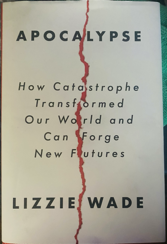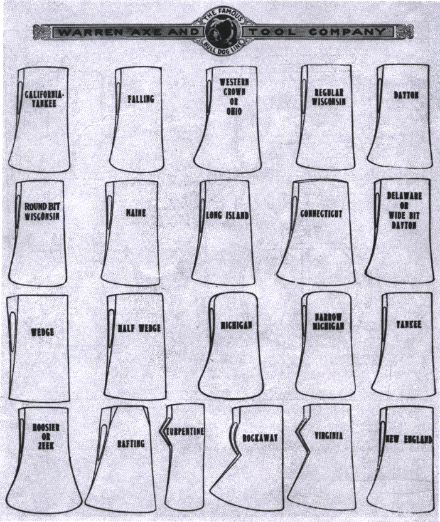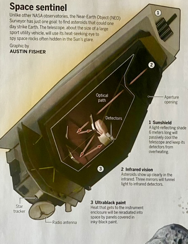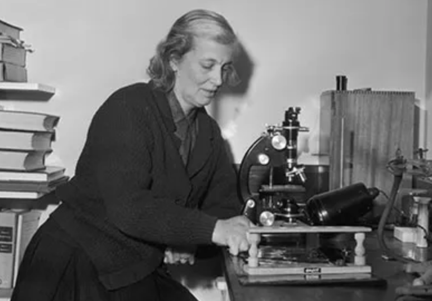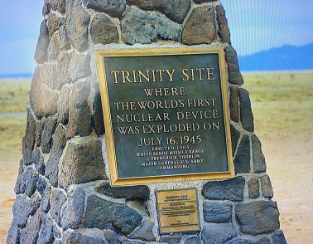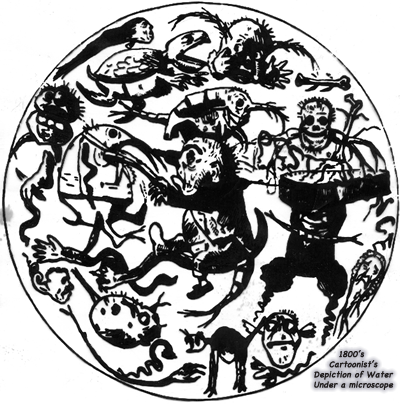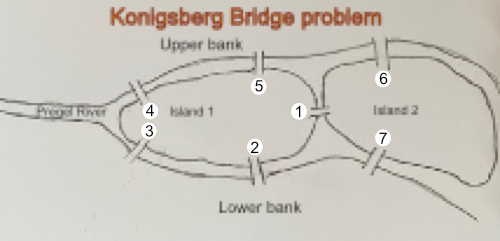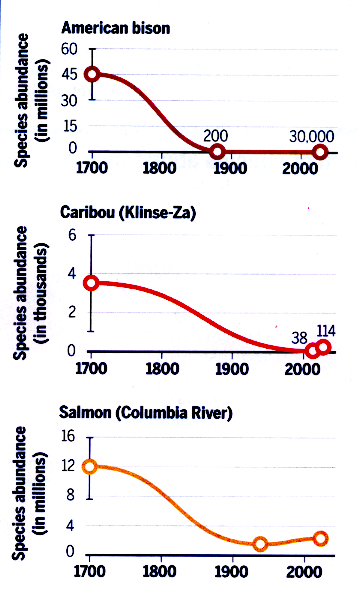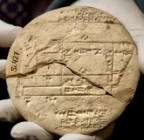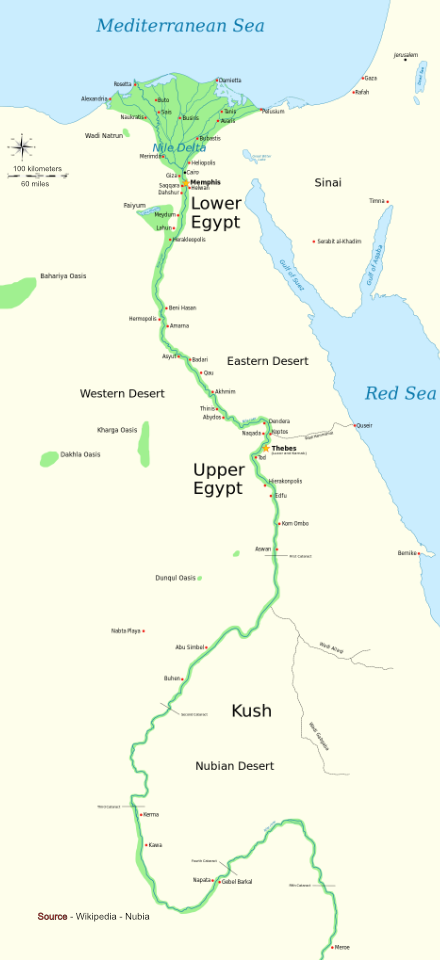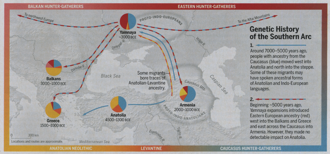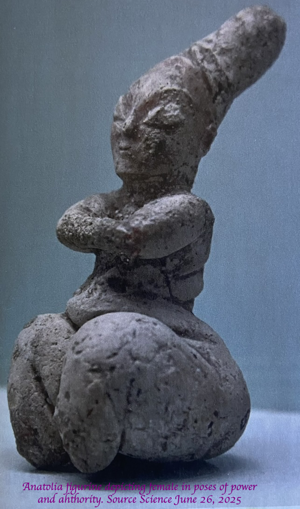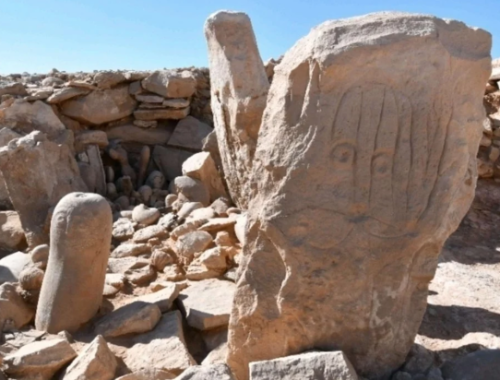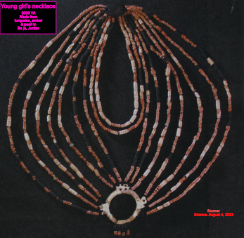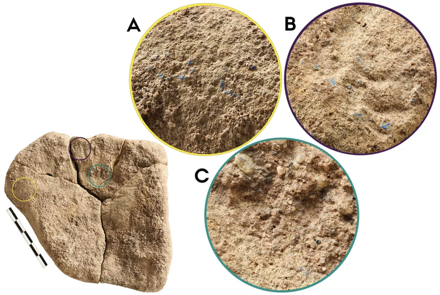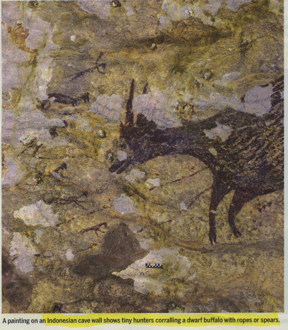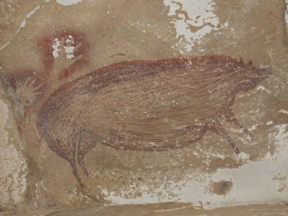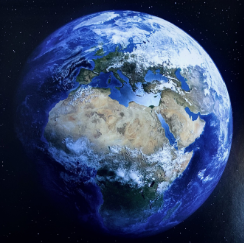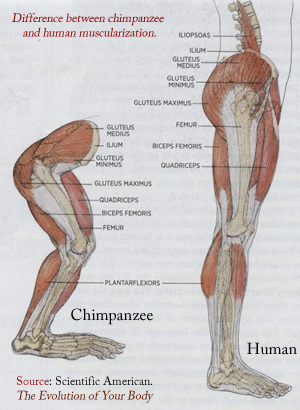
| Education timeline | Historical & political timeline | Literature timeline |
Use crtl f to search this page for key words.
Technology, science, math, engineering (STEAM) timeline
Overview
- Introduction
- Timeline
- Modern Present era - 1920
- Atomic 1860 - 1920 C.E.
- Industrial age 1600 C.E. - 1860 C.E.
- Preindustrial 1599 C.E. - 10,00 C.E.
- City state & Agriculture
1000 C.E. - 10,000 BCE - Hunter Gatherer
Holocene prior 8,000 BCE - Beginning 13.8 billion years ago BP or YA
- Top 101 inventions of all time by Meghan A.T. B. Reese
- Apocalypse World Map
While we can never touch reality,
science moves us ever closer.
When you invent the car,
you create the car wreck.
STEAM knowledge is the result of years of human's global efforts
to learn from our social interactions that exchange information.
Information exchanged, irrelevant of the ethics of the exchanges.
Oppression, war, colonialism, capitalism, slavery, industrialization, geopolitical conflict, & unhealthy choices.
The timeline of science, as we all know, is much slower than the timeline from which regular folks want answers.
Danielle Lee Tomson
Introduction
This page is a comprehensive resource presented as a timeline showcasing pivotal inventions and discoveries across the domains of science, mathematics, engineering, art, and technology (STEAM). It also highlights the individuals who made these groundbreaking contributions and includes intriguing related facts.
To gain a deeper understanding, let us explore the intricate relationships between technology, science, mathematics, engineering, and art. Furthermore, we must consider the diverse perspectives of those who create or study technology, including artisans, scientists, engineers, and mathematicians.
Technology is the practical application of knowledge for a specific purpose. The earliest human use of technology can be traced back to the development of tools. Simple objects such as plant fragments, wood, stone, and bone were likely collected and utilized as functional tools. Over time, individuals began to envision novel possibilities within these objects and, through the use of other tools, transformed them into something entirely new, an invention. Those who excelled in this creative process became skilled artisans.
Prior to the emergence of science, engineering, and mathematics, our visual spatial thinking enabled us to visualize, manipulate, reason, design, form, and create artifacts as artisans. The majority of our understanding then being based on tangible representations of concrete objects. It was not derived from verbal or analytical processes that many people today commonly associate with mathematics, science, or engineering.
Artisans, crafted art, crafts, trade goods, tools, machines, medicine, food, and other artifacts that have profoundly transformed the world. Progress is not always been linear and inevitably leds to challenges such as poverty, disease, and squalor. Consequently, these challenges have not always been shared equally among society's members, resulting in oppression and unfair claims to resources. To ensure an equitable benefit for all, a shared vision must be established within society, that is used to communicate transformative changes to guide informed consentual decisions. A vision to ensure our creations are accessible to all in a sustainable and beneficial manner.
As we generate and discover information, explanations, and relationships, we desire to communicate our information to others. Historically, through verbal explanations, storytelling, modeling, drawings, writing, and recently with video. However, it is physical artifacts that is the sole evidence we have of information that has survived across space and time, primarily in the form of concrete and visual representations. Until our invention of symbols and writing, which could preserve verbal ideas and explanations. Information pertaining to ideas and artifacts; their relationships, dimensions, actions, and construction, which communicates our thought processes across time.
In our study of the world, we accumulate more and more knowledge, going beyond cause-and-effect instructions to anticipate performance of the final artifact before its creation.
For instance, the enduring survival of stone tools suggests that their creators employed cause-and-effect reasoning to acquire the skill of chipping stones to alter their shape for better performance, such as enhancing their sharpness. However, we might also infer they went beyond this process and visualized a finished shape for a particular purpose and then altered their techniques to strike the stone in accordance with that vision.
This complexity of invention has been lost. However we can impagine this complexity if we look at the evolution of this process in modern times and consider the many changes used in the manufacturing of these 21 modern choppers in a few decades, as we wonder about the millions of years of changes our ancesters made to their tools.
Notice the 21 different styles of modern (1916) steel ax heads and consider what we might infer about their construction and functionality?
Drawings of ax heads in a 1916 catalogue:
As you explore, consider the impact on our ancestors and contemporary society the different ideas and artifacts might have had. Furthermore, reflect on the thought processes and understanding different artisans, scientists, mathematicians, and engineers might have had about their ideas and inventions they contributed to our technological advancements. Some eamples follow:
Some information to help in your thinking!
- Artisans visualize and study the structure and behavior of physical and natural objects in the world by observation with our senses to recreate them, make models of them, or something else like them, but new.
- Science is the study the structure and behavior of physical and natural objects in the world by observing, manipulating variables, observing evidence, and making explanations.
- Mathematics is the study of numbers, quantities, relationships, and shapes of space to describe structure and relationships of physical and natural objects in the world.
- Engineering is not to explain nature, but to use relationships of measurable properties: length, mass, volume, temperature, velocity, pressure, density, ... to create a system to model and analyze tools and other artifacts structure mathematically to use that information to design objects and public spaces.
For example Cornell University thought models so valuable that in 1882 they attained the Reuleaux Model Collection.
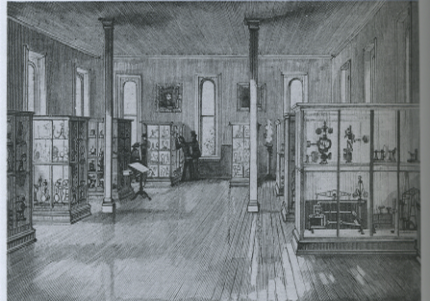
- Invention is the process that causes things to come into existence from ideas, they makes the world confirm to thought; whereas science, by deriving ideas from observation, makes thought conform to existence.
Every invention is a new design. It never existed. It may not entirely be from scratch, but one or more properties of it is new.
Here is a basic example for a tool.
An artisan makes a tool based on their visual representation and past experiences. That tool can be examined and manipulated to collect more observable information mathematically and engineer new desgins and models with a process to create models and process to design and vary them to make a more efficient tool.
For example, our tool becomes useful for chopping. So an engineer or craftsman focuses on a model of an ax, by using math to calculate their balance points and centers of percussion, they can create create different designs and models for a better ax.
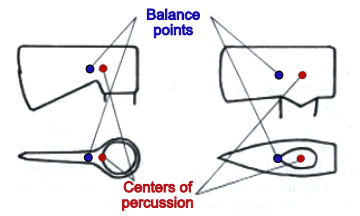
The tool-maker wants not a verbal description of the thing he is asked to make but a meaningful picture [model] of it
... without pictures most of our modern hightly developed technology could not exist. Without them we would've neither had the tools we require nor the data about which we think.
As you see with the example, the relationships between S, T, E, A, & M and their use when inventing and understanding technology is generally fuzzy.
However, we need not be concerned about fitting information uniquely into these categories, but appreciate them, and use them and the ideas they represent to see how others created and understood their world and how we might do so.
Entries for the timeline are selected based on the importance of their contribution to a modern technological world and their relationship to the knowledge bases of S, E, A, & M.
Timeline - today
Modern (Present - 1920)
2026
Space sentinel is scheduled to be launched in 2027
Source Planet Protector. Robin George Andrews. Science December 11, 2025. pps. 1094-1099
2025
Solar energy production increases and cost decrease
The world puts 2 gigawatts of solar power on line each day. Compared to 2004, when it took the whole year to put 1 gigawatt of solar power on line.
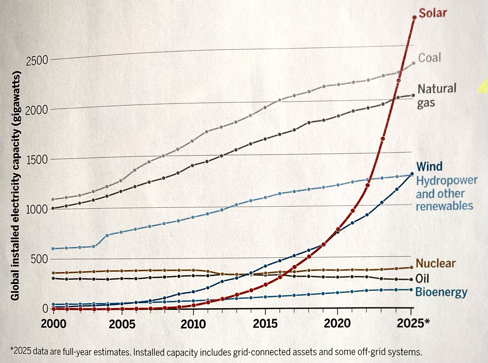
China produces 80% of the world's solar cells, 70% of the wind turbines, and 70% of the lithium batteries.
First robotic and autonomous force
U.S. 4th Fleet, based at Naval Station Mayport in Florida, announces Operations Southern Spear is to begin soon. Spear is a significant step in the Navy's evolving Hybrid Fleet, which integrates robotic and autonomous systems with traditional navy forces.
Earth records the hottest year ever
- Last year's global average temperature passed 2023's record.
- It passes the long-term warming limit of 1.5 degrees Celsius called for by the 2015 Paris pact.
- A European team calculates 1.6 degrees Celsius of warming.
- A Japanese team finds 1.57 degrees Celsius. And
- A British team determines 1.53 degrees Celsius.
- The primary reason for these record temperatures is the accumulation of greenhouse gases in the atmosphere from the burning of coal, oil, and gas.
- As greenhouse gases continue to accumulate in the atmosphere, temperatures will continue to increase, including in the ocean.
- And sea levels will continue to rise and glaciers and ice sheets will continue to melt.
These recent hot years are happening in spite of the Earth's climate state being in one of its cooler phases.

Further emphasizing the impact of the increasing amount of CO2 (carbon dioxide) in our atmosphere.
It is now above 427 parts per million. Every bit of CO2 (carbon dioxide) added to the atmosphere matters, because it takes thousands of years for oceans and rocks to absorb any exceess. Meanwhile, natural processes are supercharged by climate warming. Creating sustainable communities.
- See carbon dioxide clock with historical graphs and more
- See The Keeling Curve - a daily record of global atmospheric carbon dioxide concentration maintained by Scripps Institution of Oceanography at UC San Diego
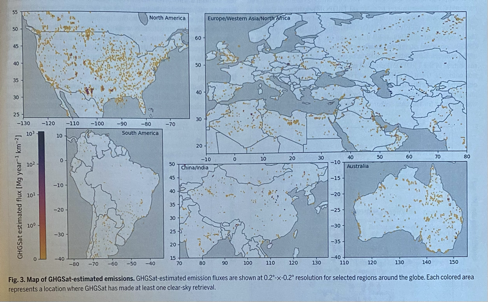
Methane emission around the globe.
Source Global energy sector methane emissions estimated by using facility-level satellite observations. Dylan Jervis, et.al. Science December 11, 205
2024
Environmental changes since civilization began!
- Humans and their livestock (mostly pigs and cows) now are 22 times the mass of wild mammals.
- Domestic birds are two times the mass of wild birds.
- Plant mass is half of what it was before civilization began.
CO2 (carbon dioxide) in our atmosphere continues to increase ...
It is above 417 parts per million.
2023
2023 is the hottest year ever recorded
Climate deniers change their messaging from outright climate denial like:
- Global warming and climate change is not real.
These message types decreased from 65% of claims in 2018 to just 30% in 2023.
To denial messages which attack climate science and scientists, and spread rhetoric attempting to undermine confidence for solutions of climate change like:
- Clean energy technology doesn't work. or
- Cimate scientists can't be trusted.
Which rose from 35% of message content in 2018 to 70% of the content in 2023.
Report source
Countries agree on a treaty to protect biodiversity in international waters
The marine protection areas (MPAs), are developed to: share financial rewards from the DNA of marine organisms, create a central database for patents, share papers, or products, and require new developments to do environmental impact assessments (EIA). However, there is no enforcement.
2022
First Native American woman in space
Nicole Mann becomes the first Native American woman to go to space and serves as mission commander for the SpaceX, Crew-5 mission to the ISS. She is a member of the Wailacki of the Round Valley Indian Tribes.
The Intergovernmental Panel on Climate Change's Sixth Assessment Report warns:
Unless future plans to build more fossil fuel energy plants are not cancelled, and most other existing plants are not decommissioned, along with an increase of three to six times as much money on renewables by 2030, we are on track for catastrophic weather and crop failures.
First U.S. law with a focus on climate change
Biden signs the Inflation Reduction Act (IRA) which includes funding to reduce greenhouse gas emissions and enhance energy security. It's the first major environmental law since the 1990 Air Act. However, it is not expected to be enough to achieve the 50% cut target set for 2030.
DeepMind announces structures of all proteins
DeepMind, an artificial intelligence (AI) company, announces the likely structures of all proteins (200 million) that make up all organisms from bacteria to humans. The program AlphaFold is able to solve protein-folding problems to determine the 3D shapes of proteins, which are made from amino acid sequences.
ChaptGPT is released
Japan's Hayabusa 2 spacecraft returns to Earth with 5 grams of the carbonaceous asteroid Ryugu (162173)
The sample is foun to include 66 elements, 15 amino acids, a wide variety of organic molecules, and materials formed by water alterations. Suggesting these materials can be transported through-out the solar system
Amazon uses the first fully autonomous robots
- Proteus navigates to pick up parcels and transport them to a desired location.
- Sparrow is the first to detect, select, and handle individual products in inventory.
2021
CO2 (carbon dioxide) in our atmosphere continues to increase...
CO2 (carbon dioxide) in our atmosphere passes 417 parts per million. The highest since the beginning of the industrial revolution.
COVID-19 vaccine developed
A messenger RNA Covid-19 vaccine, with 95% efficacy, is developed astonishingly fast; and production of 8 billion shots is achieved.
However, world wide distribution and acceptance of a vacination is less successful. Success hampered by:
- Public expectations of a vaccine, similar to measles, that provides a life time protection.
- Belief herd immunity could be achieved with wide vaccination.
- Spread of vaccine hesitancy, half-truths, misinformation, and a flood of lies along with the promotion of questionable unproven drugs and remedies.
- Evolution of different variants of the virus.
- Belief a specific mRNA vaccine could end the pandemic. And
- Wanting it to be over.
- Aggressive well organized and funded attacks on mainstream science.
- Science and media censoring itself for fear of backlash.
- Failure to recognize the ethics supporting a person's reasoning can be based on: duty to care for and protect self and others or one of privileged individual egotistical liberty of self-regard and let others fend for themselves.
Hope for future successes
- To address future risks of pandemics, people and organizations must include a consideration of how to promote and defend a moral, altruistic basis of public health efforts that will protect against any different forms of selfish individualism.
- The future for ending the pandemic may be a long term struggle that will only be resolved with a pancoronavirus vaccine that will thwart the Sars-CoV-2 virus.
China's Chang'e 5 returns 1.7 kilograms(about 4 pounds) rock and soil from the moon some from 2 meters deep
First since Russia's Luna 24 in 1976. See also Apollo
RoseTTAFold & AlphaFold (artificial intelligence algorithms) is able to predict structures of protein complexes. Both are available for researchers for free. See 2022
2020
NASA announces the Artemis program to put the first woman and next man on the Moon by 2024. Source
Within the Artemis program is the Artemis Accord.
First all women team win a Noble prize
Geneticist Jennifer Doudna and Emmanuelle Charpentier receive the Nobel Prize in Chemistry for their groundbreaking invention of CRISPR-Cas9 (clustered regularly interspaced short palindromic repeats) to edit genes.
Source The Code Breaker Walter Isaacson.
Greta Thunberg gives a Speech at the United Nations on climate and global warming
See 1987 Global Climate Protection Act for U.S. political history related to climate change and Rachel Carson's early warnings.
2019
Earth' s human population is 7.6 billion
China's Chang'e 4 lands on the dark side of the moon. Its biosphere germinates the first seeds (cotton) on the moon. January 3, 2018. Source

First image of a Black Hole is recorded with the help of Katie Bouman, who develops an algorithm necessary to create the image.
The black sphere captures all light with its massive gravity. The photons (light) that surround the event horizon create a glow as matter spirals into the hole. The black hole is at the center of the Messier 87 (M87) galaxy, 53 million light years from Earth. It has a mass of 6.5 billion suns with an event horizon a bit larger than our Solar System, itty-bitty by cosmic standards.
First AI (artificial intelligence) to predict people's emotional state
Kevin LaBar creates a model that uses fMRI scans to associate brain blood flow patterns to recognize seven feelings: countentedness, amusement, surprise, fear, anger, sadness, & neutrality.
His work builds on Jack Gallant's mapping of 1000's of concept words to brain locations. Numbers, body parts, principles such as truth. He found every word maps to multiple regions. He believes each region represents an idea associated with its meaning or related experience.
Source Discover. The Shape of Thought, December, 2019
Covid vaccine developed
Ozem Tureci and Uğur Sahin, co-founders of BioNTech (2008) discovers mRNA vaccines. They will be used to open a new generation of treatments for viruses. Covid vaccine among them.
2018
CO2 (carbon dioxide) in our atmosphere continues to increase...
CO2 (carbon dioxide) in our atmosphere passes 400 parts per million.
Highest since the beginning of the industrial revolution.
Number and intensity of wild fires increase. 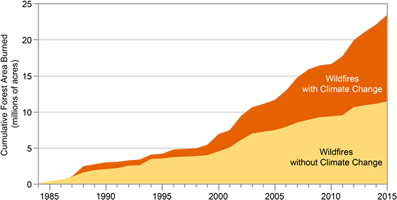
California Camp fire sets a record for the deadliest and most destructive fire in California history. Burns 153 336 acres, destroys 18,804 structures, displaces 52,000 people and kills 85 people.
Japan's Hayabusa 2 spacecraft drops multiple probes onto the surface of the Ryuga Asteroid.
The probes hop across the asteroid, take pictures, measure temperatures, magnetism, look for water and organic molecules. The main spacecraft lands three times, collects samples, and returns to Earth in 2020. Source See Hayabusa1.
NASA announces its Mars rover finds evidence for ancient life and methane in the Martian atmosphere, suggests microbes existed and still might exist today.
The B-52 bomber is still flying. By Gordon F. Sander January 20, 2018
Somalian plate is separating from the African Continent
See Africa's Big Break. by Shannon Hall in Discover magazine May 2018.
Wheat genome sequenced. Source
First known fatality involving an autonomous vehicle (AV) when An Uber test vehicle hits and kills a pedestrian near Phoenix, AZ.
2017
Hurricane Maria devastates Puerto Rico and kills 2,975 people, in September.
First artificial species created
Mycoplasma mycoides JCVI-syn3.0 has 473 genes and is created by J. C. Venter.
He starts with the living organism, Mycoplasma genitalium, the smallest organism (with 525 genes) and the first organism to be sequenced, then removes and adds genes until it sustains life and reproduces.
First time police use a robot to kill a suspect
After a sniper kills 12 police officers in Dallas, police arm a small robot with a bomb and detonate it next to the shooter.
2016
The Great Math Mystery
According to Mario Livio, all numbers (one, two, ...) are human invented concepts. And humans discovered that they have all kinds of intricate relationships.
Therefore, math is both invented and discovered. It may feel like it's already there, but it comes from the creativity of human beings. Source
Cruise ship Crystal Serenity along with 100 tourists steams from Alaska to New York through the Northwest Passage for the first time in recorded history.
OSIRIS-REx launches and arrives at Bennu asteroid in 2018
It finds a space weathered surface, with abundant organic material, and evidence of past erosion by liquid water. It collects 60 g of material and is scheduled to arrive back on Earth in 2023.
WaveNet is released
It is a deep neural network for generating raw audio. Created by researchers at DeepMind. It generates relatively realistic-sounding human-like voices by directly modelling waveforms using a neural network method trained with recordings of real speech. The method is also capable of producing music.
2015
Gravitational wave detected
Paris agreement on climate change is finalized on December 12, 2015
2012
Higgs boson is discovered at CERN on July 4, 2012
Peter Ware Higgs, a theoretical physicist, suggest the electro weak theory and broken symmetry as an explaintion for the source of all elementary particle's mass in general and W and Z bosons in particular through a Higgs mechanism.
This same mechanism was proposed by other physicists about the same time and it predicted the existence of a new particle, the Higgs boson. Both discoveries add support for the Standard Model of particle physics.
On March 14, 2013, the Higgs boson is tentatively confirmed to be + parity and zero spin. Making it the first known fundamental scalar particle to be verified in nature.
Curiosity arrives on Mars and begins to sift soil and rock samples for organic molecules
From two different sites, in 2015, it finds evidence that resembles a goopy fossilized building block (kerogen) of oil and gas on Earth. Also it finds, sulfur bearing carbon rings and traces of methane in the atmosphere that rise and fall with the season.
Voyger I enters intersteller space - August 25, 2012
In another 40,000 years it will leave the solar system and the Sun's gravitational influence. Source Ed Stone
Google brain project created an algorithm that is capable of learning to identify a cat.
AlexNet is built by Geoffrey Hinton, Alex Krizhevsky, & Ilya Sutskever at the University of Toronto
It is a convolutional neural network (CNN), a self learning neural network to learn how to recognize visual representations. While not the first or best it makes a significant splash in computing.
2011
The first internet site that is the start of the dark web
Silk Road is an online black market to buy and sell illegal drugs and for hosting other illicit activities. The site is found by Ross Ulbricht in February 2011 and shut down by law enforcement in 2013.
2010
First spacecraft to land on an asteroid and return to Earth
Japan's Asteroid Explorer Hayabusa (MUSES-C) travels to Itokawa asteroid and brings back samples. It is also the first to use ion engines to navigate. Source
2008
Scalbard Global Seed Vault on the island of Spitsbergen near Longyearbyen Norway opens
It is created to preserve a wide variety of plant seeds as spare copies held as a worldwide gene bank in case of a regional or global crises. Source
2007
The number of people living in urban areas (cities) becomes greater than the number of people living in rural areas.
Massachusetts v. Environmental Protection Agency, 549 U.S. 497,
in a 5-4 decision found
- The petitioners were found to have standing. A state has a right to act in the interest of its citizens as to whether "its mountains shall be stripped of their forests and its inhabitants shall breathe pure air."
- The Court held the CAA gives the EPA the authority to regulate tailpipe emissions of greenhouse gases. The CAA defines "air pollutant" as "any air pollution agent or combination of such agents, including any physical, chemical, biological, radioactive ... substance or matter which is emitted into or otherwise enters the ambient air".
- The Court found the EPA's current rationale for not regulating to be inadequate and required the agency to articulate a reasonable basis in order to avoid regulation.
Chief Justice Roberts dissent argued the alleged injury: Massachusetts' loss of land because of rising sea levels is too speculative and without adequate scientific support and the effect of obliging the EPA to enforce automobile emissions as a solution is hypothetical at best.
Scalia's dissent found the Court has no jurisdiction to decide the case because the petitioners lack standing.
2006
The New Horizon space probe launches
It travels toward Pluto and then Arrokoth in the Kuiper belt at the edge of the solar system. The original positional locating system is unable to center Arrokoth to photograph. Marc Huie recommends using a new star mapping system created from the Gaia satellite from mapping quasars as a reference frame. It works perfectly. Source
The craft is named with reference to the:
Gaia hypothesis, which is an Earth system science hypothesis developed by James E. Lovelock with Lynn Margulis and named by William Golding. It claims the thin layer of life on Earth, along with the enviornmenatal factors, such as air, water, and soil, collectively defines and regulates the conditions necessary to sustain life. The planet, or the biosphere, is thus a vast self-regulating organism.
2005
Hurricane Katrina devastates the north Gulf Coast killing 1,833 people.
2004
Graphene isolated
Andre Geim and Konstantin Novoselov use Scotch tape and peel layers from graphite to make graphene.
It is considered a 2D material that is a single layer of carbon atoms in a hexagonal lattice. It is incredibly thin, strong, lightweight, and conductive.
2001
The Human genome is identified with 32,000 genes
In 2003 a White House ceremony announces 92% as sequenced.
Vaccines have a higher approval rating in the United States than the most popular stars of the time: Dolly Parton, Tom Hanks, or Dr. Seuss.
93% Republicans and 97% Democrats believe they are effective.
1997
Organization for the Prohibition of Chemical Weapons (OPCW) is founded
Its mission is based on the 1993 Chemical Weapons Convention. It will oversee the destruction of the world's declared chemical weapons (CW) stockpiles.
In 2014 it removes and destroys Syria's CW stockpile and in 2022 starts to transition from disarmament to nonproliferation and threat reduction of state and non state actors who develop or use CW.
Among it's most important tasks: to reinforce international norms against the use of chemical weapons (CW). And to document and confirm who is responsible for the use of CW against different populations, and the assassination of political opponents. Source Countering the future chemical weapons threat. By Tuan H. Nguyen. Science April 20. 2022
1996
First mammal, Dolly the sheep, is cloned
Later dogs, rabbits, pigs, and primates in 2018, by Zhongshan Zhongshan and Hua Hua.
The Comprehensive Nuclear-Test-Ban Treaty (CTBT) is opened for signatures.
Nations have signed it, but not all have ratified it. However, most nations agreed to the verification procedures and are gathering and transmitting data to the CTBTO headquarters. Thus, no nuclear explosion goes undetected.
1995
The top quark, the heaviest of the particles in the Standard Model, is discovered at Fermilab
1994
Self flying plane (autonomous vehicle)
A Boeing 737 with a Global positioning system (GPS) lands itself 110 times in a row. Source
U.S. math team wins gold
Coached by Walter Mientka, a professor of mathematics at the University of Nebraska, a team of six American public high-school students score a perfect 42 points on a two-day, nine-hour test of algebra, geometry and number theory to win the gold medal. It is the first time any team has had a perfect score in the 35 years of the competition.
Mientka, says,
The U.S. win proves that American students can excel at math despite the steady drumbeat of poor results on standardized tests in recent years. Without question [the winning students] have innate ability, but their performance is directly attributed to the excellent teachers they've had. All six went to public schools.
1993
Congress kills the Superconducting Super Collider
1992
Confirm microwave background radiation of the big bang
The COBE ( NASA's Cosmic Background Explorer satellite) team announces detection of the three-degree Kelvin electromagnetic background radiation in all directions of the sky that was emitted 380,000 years after the Big Bang.
1991
Al Gore introduces legislation to create ARAPANET
ARAPANET is a public network that will became the internet, which will eventually connect anyone anywhere instantly. See 1990, 1989.
1990
Hubble telescope launches April 24, 1990.
The Hubble telescope is capable of collecting observations of space objects far beyond any previous observations. Greatly expanding the view of our universe and the number of known objects in it. NASA has great photos and more about Hubble.
First web page
Tim Berners-Lees and Robert Cailliau utilize ideas of a server, TCP, DNS, HTTP, HTML, URL, and a browser to make the WWW and the first web page. See it at: http://info.cern.ch/hypertext/WWW/TheProject.html
1989
Internet
Tim Berners-Lee designs the Distributed Information System (internet) for particle physicists to communcate more effectively and efficiently. See 1990 and 1991.
1988
Margaret Thatcher is the first world leader who calls for action on climate change.
First computer network attack
On November 2, 1988, a maliciously cyber attack is unleashed on the Internet from a computer at the Massachusetts Institute of Technology (MIT).
A cyber worm spreads quickly and grinds computers to a halt. Within 24 hours, an estimated 10% of the computers connected to the Internet had been hit. The internet slowed to a crawl before a fix was created. Emails were delayed for days. The culprit was a 23-year-old Cornell University graduate student named Robert Tappan Morris.
1987
Treaty to ban chlorofluorocarbons, to protect the ozone layer, is ratified by 197 countries.
1986
Nuclear power plant in Pripyat, Ukraine (Chernobyl) explodes to become the worst nuclear accident in the history of nuclear power.
1984
Steadicam is invented by Garret Brown
See films it is first used in and films with later cams, Skycam, Flycam, Mini steadicam.
1983
Organ Transplant
Organ transplants are largely unsuccessful because the body rejectes the new organ. Thomas Starzl works for many years to improve on transplant success.
- First, with the drug cyclosporine, approved by the FDA in 1983.
- Later with tacrolimus, approved by the FDA in 1994.
Over his career he investigates: preservation, immunosuppression, infectious diseases, oncology, growth factor physiology, and immunology. The Puzzle People: Memoirs of a Transplant Surgeon. University of Pittsburgh Press.
1982
Stanley Prusiner claims prions replicate without nucleic acids
Stanley publishes: that scrapie, a degenerative disease of the central nervous system of sheep, is caused by prions. Prions are misfolded proteins that have the ability to transmit their misfolded shape into normal proteins without RNA, DNA, or a virus. They also cause other degenerative diseases: mad cow disease and chronic wasting disease. Shifts & drifts in prion science. Science October 2, 2020
1980
Micro Computers hit the market
1980
Diamond v. Chakbrabarty - Can life be patented
The United States Supreme Court is asked to rule if a patent for a human-made, genetically engineered bacterium capable of breaking down crude oil, a property which is possessed by no naturally occurring bacteria, could be patented.
- At questions is: are living things patentable?
- Does a micro-organism constitute a manufactured or composition of matter?
Rules, it was a nonnaturally occurring organism that was manufactured, or a composition of matter of human ingenuity with a distinctive name and character of use.
As such, a live, human-made micro-organism is patentable subject matter under 101. Respondent's micro-organism constitutes a manufacture or composition of matter within that statute.
References:
- 1930 Plant Patent Act, allows protection of certain asexually reproduced plants
- 1970 Plant Variety Protection Act, protects certain sexually reproduced plants
- Title 35 U.S.C. 101 provides for the issuance of a patent to a person who invents or discovers "any" new and useful "manufacture" or "composition of matter."
1978
Global positioning system (GPS)
Brad Parkinson and his team develop proof of concept for a global positioning system (GPS). Source
1977
Gossamer Condor, becames the first nonstop human-powered flight
The Condor designed and built by Paul MacCready stayed aloft for seven minutes and flew a figure eight course. The flight won a prize of $100,000, which was offered by British industrialist Henry Kremer 18 years earlier. The Condor now hangs in the National Air and Space Museum in Washington, D.C. Source & more about Paul ...
Have Blue, the first stealth aircraft designed and built at Lockheed's Skunk Works took flight over Nevada. Source & more
Voyger 1 is launched and continues its voyage
- Voyger 1 was launched Septeber 5, 1977.
- In 1990 the blue dot photo 2, is taken.
- On February 17, 1998 it becomes the most distant human made object
- In 1998 it crosses the termination shock
- On February 13, 2010 it passes the reach of the solar wind
- On August 25, 2012 in reaches interstellar space
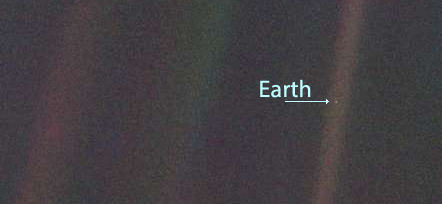
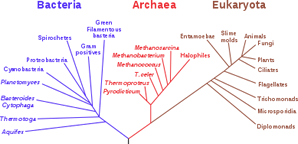

Carl R. Woese discovers cells whose 16S rRNA genetic materials are evolutionary older than known bacteria.
His work and reasoning leads to the separation of prokaryotes into two groups: Bacteria and Archaea based on the differences in genes of the two groups and the eukaryotes (multicellular fungi, plants, & animals) as being sufficiently different to be classified as a separate third domain.
This discovery results in a three-domain
- archaea,
- bacteria, &
- eukaryote
biological classification system and a better understanding of how evolutionary differences can be used for classification.
Source The Tangled Tree by David Quammen
1975
Earth' s human population reaches 4 billion
Asilomar cnference
The Asilomar Conference, organized by Paul Berg, Maxine Singer, and colleagues, convened at Asilomar State Beach, California. Approximately 140 professionals from biology, public safety, ethics, and public policy discussed biohazards associated with biotechnology and established guidelines for its safe development and regulation. Participants created comprehensive guidelines for responsible rDNA technology use. The conference emphasized considering public values in scientific research, especially when making it more accessible. This approach applies the precautionary principle, encouraging proactive measures to prevent potential risks and harms.
1973
Shirley Ann Jackson first African-American woman to earn a doctorate at MIT. See more on her successful science career. Source
Genetic engineering arrives
Stanley N. Cohen & Herbert W. Boyer transplant DNA from a frog to a bacterium. Later find Genentech in 1976.
1972
First use of precision guided bombs
On July 23rd, laser-guided bombs are used to target and destroy the Than Hoa Bridge and Longbien Bridge. The Than Hoa Bridge is destroyed by a 3,000-pound laser-guided bomb dropped by an F-4 Phantom jet, and Longbien Bridge is destroyed by a 2,000-pound TV-guided bomb. Source
A patent is filed for the first MRI (Magnetic Resonance Imaging) scanner
It is developed in the late 1970s. MRI machines use powerful magnets and radio waves to create detailed images of organs and tissues inside the body. They generate a strong magnetic field that aligns protons in hydrogen atoms, then send radio waves that knock them out of alignment. As they return, they emit signals that the machine processes with its semiconductor circuitry to create images of internal structures valuable for medical diagnostics.
1970
First Earth Day
Treaty on the Non-Proliferation of Nuclear Weapons (NPT) to prevent the spread of nuclear weapons and promote peaceful uses of nuclear energy. See 1963 and 1996
Three Environmental Acts ALL pass in the Senate without a single dissenting vote & President Nixon signs them into law.
- The Clean Air Act (1970),
- Clean Water Act (1972), and the
- Endangered Species Act (1973) See 50 Years of the Endangered Species Act (ESA). Science A landmark environmental law looks ahead. December 22, 2023. pgs 1348-1355
Eric Kandel shows short-term memory involves changes in synapse strength and long term memory creates new synapses. Source
The Standard Model of particle physics is developed
It is based on quantum mechanics and describes how fundamental particles, such as quarks and leptons, interact through four fundamental physical forces: gravitation, electromagnetism, the weak nuclear force, and the strong nuclear force.
1969
First automatic teller machine (ATM) is put into use in New York.
Source History channel
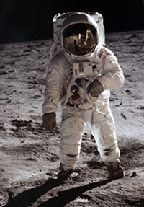
Apollo program achieves the first Moon landing with Apollo 11
- Apollo 1 accident fire kills Virgil Gus Grissom, Edward White, & Roger Chaffee. 1, 27, 1967
- Apoll0 4 no crew Earth orbiting mission to test Saturn V as a launch vehicle. 11, 9, 1967
- Apollo 5 no crew Earth orbit with test flight of lunar module. 1, 22, 1968
- Apollo 7 first crew flight Walter Schirre, Donn Eisele, Walter Cunningham. 10, 11, 1968
- Apollo 8 takes three astronauts: Frank Borman, Jim Lovell, & William Anders to the dark side of the moon and back. 12, 21 1968
- Apollo 9 tests the lunar module for the first time while in Earth orbit. 3, 3, 1969
- Apollo 10 tests all aspects of a complete crewed lunar landing, except the landing. First crewed spacecraft to operate in lunar orbit with Thomas Stafford, John Young, & Eugene Cernan. 5, 18, 1969
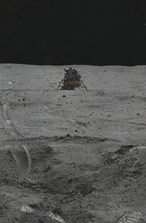
- Apollo 11 Neil Armstrong is the first man to step on the moon and first broadcast from the surface with "One small step for man, a giant leap for mankind." Accompanied by Buzz Aldrin & Michael Collins. Michael orbits the moon. The mission includes a two and one-half hour moon walk.
- Apollo 12 has a second lunar landing with an eight hour moon walk. Found bacteria could survive from Earth through space to the moon on an unmanned lander. 11, 14, 1969 Charles Conrad, Richard Gordon, & Alan Bean
- Apollo 13 has a third planned lunar landing, however, the lunar landing is aborted when an oxygen tank explodes two days after launch. Mission control and astronauts: Jim Lovell, Jack Schwigert, & Fraed Haise engineer a solution and return safely to Earth. 4, 11, 1970
- Apollo 14, Third lunar landing, Alan Shepart, Stuart Roosa, & Edgar Mitchell 1, 31, 1971
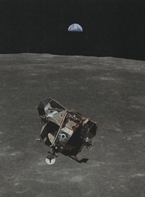
- Apollo 15, has a fourth lunar landing, David Scott, Alfred Worden, & James Irwin 7, 26, 1971 first use of a lunar rover.
- Apollo 16, has a fifth lunar landing John Young, Thomas Mattingly, & Charles Duke. 4, 16, 1972
- Apollo 17 has a sixth lunar landing. Harrison Schmitt, Eugene Cernan, & Ronald Evans. Longest rover exploration and returns more soil and rock samples than previous. 12, 7, 1972
It is the last mission. However, several movie legends and conspiracy theories will claim additional secret NASA missions. - After Apollo 17 the Apollo program goes on to launch Skylab and ends with the docking of the Apollo - Soyuz vehicles.
People hailed these as great science achievements. They were NOT. They were wonderful engineering achievements.
1968
Tragedy of the Commons published
Garrett Hardin writes his Tragedy of the Commons to describe problems for common resources. He explains how herders, who seek to maximize production, can increase herd size and over graze a common range. When production exceeds the range's capacity, then livestock suffer, production falls, and the ultimate tragedy: no rancher being able to graze the field, due to overconsumption.
However, persuasive forces, such as: from a collective cooperative agreement or monarch, who apply coercion or social pressure for conservation of land, could achieve a sustainable environment with appropriate management.
The idea of tragedy of the commons can be extended to other land uses used to provide food, shelter, aesthetic value, watershed for quality water to sustain agriculture and human health; conservation of wild life; healthy oceans; a clean atmosphere with balanced amounts of oxygen, nitrogen, and carbon dioxide, life sustaining climate; transportation; and intellectual knowledge rights.
Decoded how DNA is transribed into RNA to build proteins.
Har Gobind Khorana, found that DNA's four letter codes: A, T, C and G are transcribed into RNA and then translated, three at a time, to build proteins with amino acids. He studied nucleic acids, molecules that make genes, and confirmed the 64 unique three-letter words that determine the order of amino acids needed to make specific proteins.
- In 1972, Khorana made a second breakthrough, constructing the world's first synthetic gene.
- In 1976 he injected the gene into a living E. coli bacterium. And makes the hormone somatostatin.
- In 2008 J. Craig Venter Institute makes a synthetic bacterial genome with more than 580,00 base pairs, and in 2010 create a genome with 1.08 million base pairs. In 2017 creates the first artificial species.
Source The Gene

First interracial kiss on television
On a Startrek, episode between Communications officer, Lieutenant Nyota Uhura (Nichelle Nichols) and Captain Kirk (William Shatner).
Nichelle Nichols, later becomes a spokesperson for NASA in recruiting women and minority astronauts. Her story is told in the documentary, Women in Motion.
1967
Lynn Margulis publishes her theory that cell organelles, such as mitochondria and chloroplasts, were once independent bacteria. It is largely ignored until substantiated with genetic evidence.
Theory on continental drift
W. Jason Morgan builds on the data and ideas of Maria Tharp and Mary Sears to create a theory to explain the spread of the sea floor and continental drift.
It explains three kinds of plate boundaries: Plates that move away from ridges, plates that move toward trenches, or plates that slide past each other to transform faults. The theory describes how to use measurement with spherical geometry of the pole's rotation and triple junction analysis to predict plate motions.
1964
Relates viruses to cancer and other infectious diseases
Michael Anthony Epstein identifies the Epstein-Barr virus (EBV) as playing a part in the cause of some cancers and other illnesses. Infectious mononucleosis and multiple sclerosis.
Arno Allan Penzias and radio-astronomer Robert Woodrow Wilson
Discover microwave background radiation of the big bang
They detect cosmic microwave background (CMB) energy coming from all directions of the sky and estimate its temperature as 3.5 K. It is thought to have been emitted 380,000 years after the Big Bang. See 1992
16 October 3 pm China detonates its first atomic bomb and announces its policy of no first use in a conflict.
Qian Xuesen is born in China. Receives a scholarship to MIT, gains a security clearance, and works on classified weapons research in the U.S.
During the Red scare the FBI revokes his clearance and puts him under house arrest. He returns to China and works on their nuclear weapons program, ballistic missle program, aerodynamics, and systems engineering to control social science and engineering problems (Three Gorges Dam on the Yangtze River). His work sets the stage for state surveillance to control reality in later years, 2016. Source
James F. Holland researches and develops combination chemotherapy to treat acute leukemia in children
His treatment is based on two key concepts:
- Cancer cells are naturally resistant to chemotherapy, and
- Resistance can be overcome more effectively when multiple drugs are given at the same time, instead of one after another.
His research changes acute lymphoblastic leukemia from an incurable illness to one with a high survival rate.
First stop motion photograph taken
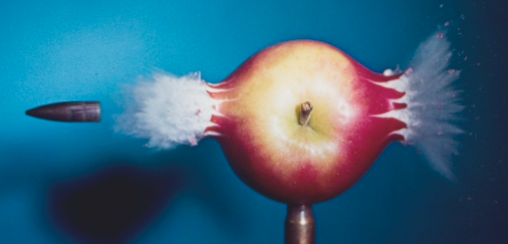
Dr. Edgerton, invents the stroboscope and uses it to capture photographs of rapid motion. Pictures that seem to stop time. His first photos include a bullet shot through an apple, and a milk drop above a splash wave, followed by many more.
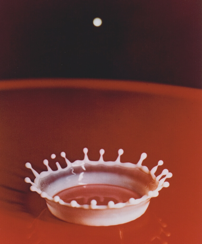
Bell writes the spooky action at a distance theorem
John Stewart Bell’s equations, now known as Bell’s theorem, explains how entangled particles exhibit stronger statistical correlations than any local hidden variables theory can explain. Experiments in the 1970s confirmed Bell’s findings, confirming the existence of spooky action at a distance.
1963
Treaty to ban atmospheric nuclear testing to eliminate radioactive fallout as a source of pollution is signed.
First live instant replay on TV is run in the third quarter of the Army v Navy football game, December 7, 1963.
Valentina Tereshkova is the first woman to orbit Earth
Ermal Cleon Fraze invents the pull-tab opener. First used on beer and soft drink cans.
Diane Fossey begins her life long study of gorillas. See her story
1962
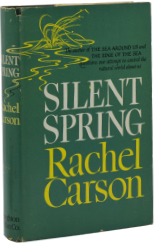
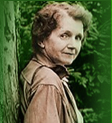
Rachel Carson publishes Silent Spring
In it she claims everything is connected, we all share the same molecules, and humans have the capacity to destroy nature.
Source
PBS Rachel Carson video 2017 (1:53:11) and Life & Legacy of Rachel Carson
- Creates the environmental movement
- At 10 she wins a prize for her story published in St. Nicholas Magazine 1918.
- Graduates Parnassus, PA High School 1925
- Graduates Pennsylvania College for Women (Chatham University) 1929
- Employed at Woods Hole Marine Biological Laboratory
- Earns an MA in zoology at Johns Hopkins University in 1932.
- Writes 52 short radio programs on marine life: Romance Under the Waters in 1935.
- Undersea Atlantic Monthly article in 1937
- Works at the U.S. Fish and Wildlife Service as a fish & aquatic marine biologist 1939-1951
- Notes the subartic growing season is longer, growth rings are fatter, and cod are migrating farther north. She concludes: "The long trend is toward a warmer earth." 1951
- Reader's Digest turns down her article on DDT effects on the environment because it is thought to be too controversial. Chemical companies claim it is only harmful to bugs.
- The Sea Around Us becomes a prize winning book, published in 1952, a study of the oceans. Followed by The Edge of the Sea in 1955.
- Japanese seamen on board the Lucky Dragon die of radiation exposure 1954. She asks: How much radiation does it take to harm life? How much to kill? Strontium 90. leukemia, birth defects ...
- Help Your Child to Wonder. 1956
- Our Ever-Changing Shore. 1957
- Silent Spring published 1962 Relates pesticide effects to radioactive build up. What is a wise use of pesticides?
- CBS Reports with Eric Sevareid airs The Silent Spring of Rachel Carson on national television 1963 in spite of the fact all sponsers with draw commercial support.
- Who does the land, air, forest, water belong to? What is the commons?
- She set out to save a species ... Us.
Big box store architecture
The big box stores arrive when Walmart, Target, and Kmart open their first stores a few months apart. Stores with huge areas of undivided retail space for customers to purchase large supplies of retail goods and outside big parking lots with easy access to highways to attract shoppers.
Two Telstar communication satellites are launched
- The first in July 1962 and
- the second in May 1963.
They enable the first TV signals, telephone calls, fax images and live transatlantic feed to be relayed from space.
1961
President Kennedy authorizes the use of defoliants in Vietnam, December 1961.
1960's
Earth' s human population reaches 3 billion
The Green Revolution, and Norman Borlaug develop new strains of wheat and rice for developing countries to produce higher yields. He first developes a short strain of wheat and other varieties for Mexico, which increases wheat production three times.
Later, India and Pakistan ask him to help their countries with their agricultural revolution.
He developes techniques to create mutations for finding new hybrids, which he uses to develop different strains of wheat, rice, sorgum, millet, cassova, triticale, maize, and tubers.
It is estimated these varieties were able to save billions of people from starvation. The down side is the large amounts of chemical fertilizers and pesticides required to maintain high yields. Source
Also helping is M. S. Swaminathan who breeds dwarf genes into wheat and rice to produce shorter and stronger plants to stand tall without breaking under heavy grain yieds.
Jane Goodall begins her life long study of chimpanzees. See her story
Over 90% of homes in the USA have a television
Laser (light amplification by stimulated emission of radiation) is invented
Laser, a device based on Einstein’s quantum mechanical processes, emits narrowly focused beams of light at a single wavelength. It amplifies this coherent light with energizing electromagnetic radiation (light, heat, or electricity), which excites the atoms in the medium, raising them to a high-energy state.
The first laser is built by Theodore H. Maiman at Hughes Research Laboratories, based on ideas by Charles Hard Townes and Arthur Leonard Schawlow.
Later applications include: laser pointers, laser surgery, tatoo removal, cutting materials, welding, fiber-optics, optical disc drives, laser printers, barcode scanners, DNA sequencing instruments, instruments to mark targets, instruments to measuring range and speed, chip manufacturing, surgery, laser lighting displays ...
First SETI (search for extraterrestrial intelligence) experiment
Frank Drake turns the telescope at the National Radio Astronomy Observatory toward Tau Ceti and Epsilon Eridani (close stars) to search for interstellar communications (project Ozma). A high altitude plane signals a false alarm. However, it demonstrates such a search is reasonable and feasible.
1958
America enters space age
ARPA launches America's first communication satellite (SCORE) into orbit with an American Atlas rocket. A previously recorded meassage is onboard and on December 19, 1958, on the second attempt a radio signal from Earth, turns on a pre recorded speech by President Eisenhower's and it is broadcasted on a short-wave radio frequency from outer space. Message below: Source
This is the President of the United States speaking. Through the marvels of scientific advance, my voice is coming to you from a satellite circling in outer space. My message is a simple one. Through this unique means, I convey to you and all mankind, America's wish for peace on earth and good will to men everywhere.
NASA launces its first satellite, Explorer 1, into space on January 31, 1958 aboard a Jupiter C rocket developed by the team headed by Dr. Wernher von Braun. The primary scientific purpose is to measure cosmic ray radiation in Earth orbit.The experiment, conducted by Dr. James Van Allen, measures a lower cosmic ray count than expected. This leads to the discovery of the Van Allen Belts of charged particles concentrated in space by Earth's magnetic field. Source
Alan Shepard is the first American to reach space on a suborbital flight on May 5, 1961. Three weeks after the Soviet cosmonaut Yuri Gagarin.
In 1962 astronaut John Glenn orbits the Earth three times in the Mercury spacecraft Friendship 7, re-enters the Earth's atmosphere, and splashes down in the North Atlantic Ocean.
Female mathematicians, or human computers, support the engineers. Among them is Katherine Johnson. She develops precise trajectory calculations for human spaceflights and lunar orbits. Margot Lee Shettelry writes about her in the book Hidden Figures, on which the movie of the same name is based.
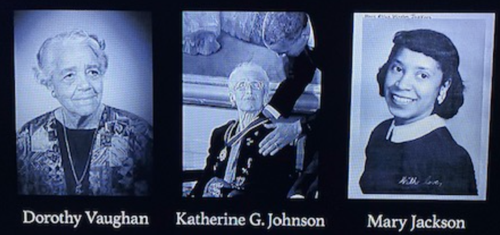
See Apollo program 1969
Nuclear research
ARPA funds research to investigate the possibility of creating an electron shield, to destroy enemy intercontinental ballistic missiles (ICBM), by exploding atomic bombs in the atmosphere. The funding includes an actual ICBM launch with an atomic bomb that is exploded in the atmosphere to test feasibility (ARGUS test). Source
Investigate the creation of a space vehicle powered by hundreds of nuclear bombs (Orion).
Lego bricks are invented by the family company found by Ole Kirk Kristiansen in 1932. The word Lego is shortened from Danish leg godtz - meaning: play well. In 2018 the company moves to make environmentally responsible bricks with a small environmental footprint. Source
Anthropocene Epoch? (present - .01 mya)
Anthropocene Epoch (present - .01 mya) can be identified by the measurement of radioactive traces in organic materials that was alive during the atomic bomb tests of the 1950's and 60's. Might be considered a sign post, along with the introduction of plastic into the environment, for the extinction of many species. Will humans be among them?
1957
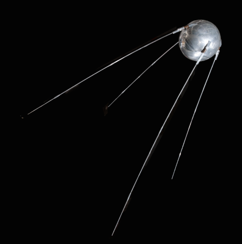
The start of the Space Age
The Soviet Union launches Sputnik 1, the Earth's first artificial satellite, on October 4, 1957
Shortly after, two more Soviet satellites are launched into space, one with a dog.
The satellites orbit Earth approximately once every 90 minutes. See America enters space race 1958 & V2 rocket
Strategic Air Command (SAC) south of Omaha, NE is under the command of General LeMay.
It employs nearly a quarter of a million men and its hangars contained over 2,000 strategic aircraft, including over 700 B-52's.
Many Worlds Interpretation of quantum mechanics
Hugh Everett suggests that for each every possible outcome of a quantum mechanics measurement, that there are equally real and distinct universes. This view is later popularized by Bryce DeWitt as the Many Worlds Interpretation of quantum mechanics.
Bardeen-Cooper-Schrieffer (BCS) describes the Superconductivity theory
Superconductivity theory describes how materials lose all electrical resistance and expel magnetic fields (Meissner effect) when cooled below a critical temperature. It involves electron pairing (Cooper pairs) mediated by lattice vibrations (phonons).
1956
Federal Aid Highway Act passes Congress
Construction of the U.S. Interstate Highway System, with controlled access highways, proposed by Dwight D. Eisenhower, starts.
Shipping container is invented, designed, and patented for more efficient and faster intercontinental trade by Malcolm Mc Lean, a trucker who owns and operates a large fleet of trucks.
1955
AI (artificial intelligence) is used by John McCarthy and Marvin Minsky extending the questions: Can machines think?
Later explored in films such as: 2001: A Space Odyssey and The Terminator.
They coined the term to focus discussion on the programming of machines as opposed to the philosophical ideas associated with the term used in the 1948 book Cybernetics by Norbert Wiener.
1954
Solar cell
On April 25, 1954, Bell Labs announces the invention of the first practical silicon solar cell. Based on the photoelectric effect that light generates an electric current, first described by Aleksandr Stoletov in 1894. Source Timeline solar cells
See article on how variation of Sun angle, duration effects the amount of Solar radiation energy (insolation).
1953
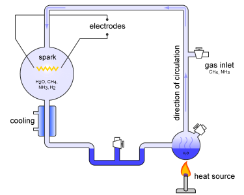 Stanley Miller creates amino acids
Stanley Miller creates amino acids
His experiment puts an electrical charge in a flask with methane, ammonia, hydrogen and water.
The results may explain how organic materials were created on Earth billions of years ago.
Source: The original uploader Carny at Hebrew Wikipedia (Transferred from he.wikipedia to Commons.)
DNA first identified
James Watson and Francis Crick demonstrate a structural model for deoxyribonucleic acid (DNA) as a double helix twisted ladder. Which is essential to understanding how genes control the chemical processes in living organisms.
They are assisted when Maurice Wilkins shows James an X-ray crystallography image of DNA made by Rosalind Franklin. Watson recognizes a double helix, he and Francis Crick publish it, and win a Nobel Prize for it in 1962.
Dorothy Crowfoot Hodgkin spends years perfecting the X-ray crystallography technique, for which she wins a Nobel Prize in 1964. She also determines the structures of penicillin, vitamin B12 and insulin.
The application of DNA can help us understand human conditions is beset with inherent errors for those who may resort to simplistic explanations to address intricate scenarios or situations that are not governed by genetics.
The 4 Level Freeway Stack opens in Los Angles. It is 32 lanes of traffic to change directions 8 ways.

Engineering moves from artisan and design to use of mathematical functions
The Grinter Committee recommends that engineering programs should:
- Eliminate all practical and artisan courses that provide vocational content and skill.
- All programs should include each of six engineering sciences: mechanics of solids, fluid mechanics, thermodynamics, transfer and are mechanisms (heat, mass, momentum) electrical theory, and nature and properties of materials.
- All courses should integrate engineering analysis, design, and engineering systems to stimulate creative and imaginative thinking that makes full use of engineering sciences.
1952
Maria Tharp discoveres the Mid-Atlantic Ridge from mapping data.
When Maria transfers data from a 5000 foot scroll onto sheets of white linen to map the bottom of the Atlantic Ocean, a long rift valley appears.
Such a ridge is suggested by Wegner's theory of continental drift & plate tectonics.
However, most people believe continents are permanently attached to the surface of the Earth or they are too massive to drift so she is told by her superior to redo her work. After she does, the results are compared to another map by Bruce Heezen, and both maps describe rift valleys in the mid-ocean ridge. The results are published in 1957.
The article is read by the ocean explorer, Jacques Cousteau. He doubts Tharp's conclusions. Determined to prove her wrong he tacks her map to the dining room wall of his ship. However, when he views film he takes of the Atlantic Ocean floor, he sees a deep valley ridge where Tharp had mapped it. Source "Connect the Dots: Mapping the Seafloor and Discovering the Mid-ocean Ridge" by Marie Tharp, Chapter 2 in Lamont-Doherty Earth Observatory of Columbia
- Check out Mary Sears, another interesting person in oceanography and her Pioneering Ocean Research …
- W. Jason Morgan presents a theory to explain the spread of the sea floor and continental drift in 1967. It explains three kinds of plate boundaries: Plates that move away from ridges, plates that move toward trenches, or plates that slide past each other to transform faults. the theory describes how to use measurement with spherical geometry of the poles rotation and triple junction analysis to predict plate motions.
Great London Fog or Big Smog
A five day air-pollution event in the United Kingdom; caused by cold weather and a lack of wind to move massive amounts of smoke created by the burning of coal and other fossil fuels for home use, transportation, and industry; is believed to have killed 12,000 and sickened 25,000. It leads to the Clean Air Act in 1956. Source
David Bohm uses Louis de Broglie and develops pilot wave theory (The de Broglie-Bohm theory)
The de Broglie-Bohm theory uses quantum mechanics to describe how particles follow precisely defined paths, even when unobserved.
First amino acid sequence of a protein
Frederick Sanger finds a protein is a genetically created sequence of amino acids. He uses this ideas to determine the complete amino acid sequence of two polypeptide [protein] chains - bovine insulin A (1951) and bovine insulin B (1952). Next he determines how amide groups are distributed, and the location of the disulphide linkages which complete his deduction of the structure of insulin, in 1954. Source
1951
Henrietta Lacks dies of cervical cancer on October 4, 1951, at age 31
Her cells are taken from her body and used to create the HeLa cell line. These cells are found to grow quickly, are very hardy, and survive longer than usual human cells. They became widely used in thousands of medical research experiments (cancer, polio vaccine, HIV, effects of toxins and radiation on cells, gene mapping, testing sensativity of cosmetics and other substance on cells, invitro fertilization, ... ). Since the cells were taken without her or her families permission their use and ownership eventually began discussions on ethical and legal use of peoples cells and genetic material. Source
Jack St. Clair Kilby invents an integrated circuit
Turned down by MIT to study electronics. He later says: it was because he didn't know it wasn't supposed to work that he tried it and found that it did. Serendipity?
First protein structures (myoglobin & hemoglobin) are determined with X-ray crystallography.
Later Christian B. Anfinsen Jr. suggests that since a protein is thermodynamical stable it will make it possible to predict the structure of a protein based on the the sequence of its amino acids. Which will be solved in 2021
January 1, 1950 is designated as BP (before present) or YA (years ago)
Willard Libby, invents carbon-14 dating around 1950.
Therefore, scientists agree to use January 1, 1950 as the reference date for before present
(BP or YA years ago) when dating.
Barbara McClintock publishes, The origin and behavior of mutable loci in maize
By observing the patterns of coloration of maize kernels over generations of plants, Barbara determines that genes can move within and between chromosomes. Her findings aren't accepted and mostly ignored so she turns her study to the origins of maize in South America.
In the 1970's and early 1980's improvements in molecular science confirms her theory and these jumping genes are found in other microorganisms, insects and even humans. McClintock is awarded a Nobel Prize in 1983.
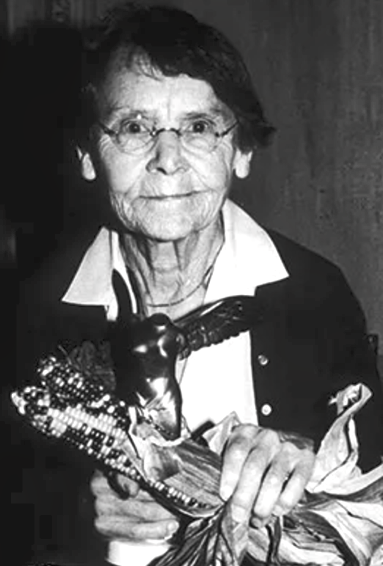
Admiral Rickover asks for a full scale model of the Nautilus so every pipe, valve, panel, and part can be tested to see if they are accessable safely to operate and repair.
1950
Quantum Field theory builds on quantum entanglement (QED).
Quantum coherence theory describes that quantum systems, such as particles or waves, maintain fixed phase relationships, or allowing them to exist in multiple states simultaneously (superposition) and make interference patterns.
1947
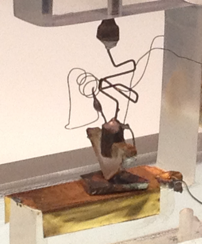 First transistor
First transistor
A crude device made with a paper clip, scrap of gold foil and a crystal of germanium that could switch electronic signals.
1946

First Bikini swim suit made
French textile engineer fashion designer Louis Reardé designs a two piece swim suit, the bikini. Named for the Bikini Atoll where atomic bombs were tested. It is modeled by Micheline Bernardini on July 5, 1946.
Previously,
- Bikini like clothing is carved on a statue in Turkey about 5,600 BCE . and
- Paintings and other artifacts from Greece and Rome also show bikini style clothing.
1945
Manhattan Project's Trinity test is successful with the detonation of the first atomic bomb in Alamogordo, New Mexico on July 16, 1945, at 5:29:45 a.m.
Views of photos and videos of atomic test explosions. Compiled by Gregg Spriggs, at Lawrence Livermore National Laboratory in California for the public to see the destructive power.
See First use in war Hiroshima
The largest H-bomb explosion ever recorded is a test called Tsar Bomba detonated in the Barents Sea in 1961. It creates a three mile fireball and mushroom cloud 59 miles wide. Ten times more powerful than all the conventional explosives used in WWII.
Richard Feynman, Julian Schwinger, & Shin'Ichiro Tomonaga develop quantum electrodynamics theory
Quantum electrodynamics theory explains how light and matter interact. It is based on quantum mechanics and Einstein's theory of special relativity.
First computer ENIAC
It has 18,000 vacuum tubes and can do 300 operations a second. Built at the University of PA.

George Polya studies & identifies a heuristic to systematically solve problems
His classical book: How to Solve It, has been been found by students and educators as an authority for solving problems. In it he suggests four steps for solving mathematical problems:
- Understand the problem
- Make a plan
- Carry out the plan
- Look back on your work and ask, How could it be better?
1944
Frozen food developer Clarence Birdseye learns from the Inuit that trout caught through holes in the ice can be frozen instantly in the air (which is 30 degrees below zero) tastes like fresh trout when it is cooked later. Unlike when food is frozen in the more usual slower way.
This leads him to develop a flash freezing method to create better tasting frozen meals and vegetables, which changes the way the world eats, and provides people with quality food when it isn't in season. Source and more.
Erwin Schrodinger publishes What Is Life? In it he seeks answers to
... how can the events in space and time, which take place within the spatial boundary of a living organism be accounted for by
physics and chemistry?
This book is credited by many of the pioneers in the study of genetics and DNA as inspiring their work.
1943
First digital speech encryption system, SIGSALY or The Green Hornet
is developed by Bell Telephone Laboratories and built by Western Electric. It is used to communicate from Washington to London during WWII.
Communications such as confidential talks between British Prime Minister Winston Churchill and US President Roosevelt. The system uses the highly-secure One-Time Pad (OTP) encryption. Source
1942
Space age
The V-2 rocket or missile fires successfully from Peenemund Island off Germany's Baltic coast. Directed by German rocket scientist Wernher von Braun.
1941
Penicillin
Howard Florey and Ernst Boris Chain isolated, purify, and create an injectable form of penicillin to use as an antibiotic.
Blood banks
Charles Richard Drew Drew worked with Scudder and E. H. L. Corwin to plan how to safely collect, process and store large amounts of contamination-free plasma and ship it safely to Britain during WWII. Later he organizes America's first large-scale blood bank. Source
1940
Bacteria resistant antibiotics
A study shows bacteria could develop a resistance to penicillin even before penicillin is used to treat infections. However, the idea of killing bad bacteria and an increase in the discovery of antibiotics would accelerate the use of antibiotics in ways to contribute to resistant microbes rather than considering a more targeted and efficient use of antibiotics to reduce the evolution of drug resistant organisms.
1939
DDT is found to kill insects
It begins to be used extensively as an insecticide. Sprays attached to mowers to spray yards before picnics, shelf paper with DDT embedded, paint, varnish, there were no limits on its use. Thought it would raise the standard of living, rid the world of malaria, fire ants and other pests that caused disease and harmed crops.

1938
Circadian rhythms discovered
Nathaniel Kleitman and Bruce Richardson experiment with themselves and other subjects trying to change the normal 24 hour sleep-wake cycle, but fail when they tried to create both a 48 hour and 12 hour cycle. And find that the temperature rhythm, physical irritability and exhaustion wouldn't adjust. So they headed underground… where there is no sunrise or sunset to influence the normal day night cycle.
They discover Circadian rhythms ... but don't recognize it as a biological property of protoplasm, and stick with the idea that the sleep-wake cycle is based on choice, behavior, and sensory inputs.
1936
Tasmanian tiger becomes extinct
1936 - 1938
City planning for green space and community ...
Greenbelt, Maryland, is constructed from 1936 to 1938 by thousands of laborers, through the New Deal programs.
Clarence S. Stein is a consultant and creates design guidelines. Later Stein works to preserve the town as an example of a socially and environmentally responsible community design that can be used as a prototype for future desgins. Designs that combine superblocks of houses and apartments with pedestrian walkways through communal green space which join to a central area with commercial and recreational structures separate from roads for automobile travel.
In addition, the federal government promotes cooperative enterprises and associations in Greenbelt as a way to foster affordable housing and an enduring sense of community. While the cooperative nature of the towns are deemed a failure, the physical layout of the town is replicated by private developers. Source
More information related to the political aspects of this social experiment.
1935
Albert Einstein, Boris Podolsky & Nathan Rosen, publishes a paper describing the EPR paradox
The paper, lays the groundwork for entanglement with its quantum entanglement theory.
Einstein is skeptical of entanglement, calls it spooky action at a distance. He argues quantum mechanics is incomplete.
1932
Sulfa drug and antibiotics
Sulfa, also called sulfonamide, a synthetic antibiotic with a sulfanilamide molecular structure is the first chemical substance systematically created to treat and prevent bacterial infections in humans.
These effects are first observed in 1932, by Gerhard Domagk who notices that red dye Prontosil kills Streptococcus infections in mice.
Later researchers find the active agent is sulfanilamide, or para-aminobenzenesulfonamide, a metabolic product of Prontosil.
1930
Leo Szilard patents the nuclear fission reactor
Thomas Midgley invents Chloroflurocarbons (CFCs)
Dichlorodifluoromethane is odour-free, nontoxic, and nonflammable refrigerant gas to use in residential refrigerators and air conditioners. It is commercially produced as Freon-12. It will later be found to destroy the Ozone layer that protects Earth from harmful radiation.
1929
Edwin P. Hubble's measurements of shifting spectral lines of light emitted from distant galaxies supports the expansion of the universe.
Hubble identifies 11 Cepheid variables in NGC (New General Catalogue) 6822, applies Leavitt's Law, and gets a distance to it of about 214 kpc (kiloparsecs or 3,260 light years).
Evidence to suggest an explanding Universe and the Hubble constant, slope of the linear velocity- distance plot, for the rate of expansion.
1928
Penicillin
Alexander Fleming accidentally (serendipity) contaminates colonies of bacteria with mold, penicillium, and notices there is no bacteria growing around the areas of the mold. He isolates the mold, grows it, and finds it contains a substance capable of killing many bacteria that infect humans.
Later Gladys Hobby, Martin Henry, and Karl Meyer relize the importance of this and perfect penicillin ( See 1941) and later Hobby perfects Terramycin.
Max Born uses the square of Schrodinger's wave equations to predict the loation of electrons
and that probabilities are truly random.
-------------------------------
Dirac presents to the Royal Society of London a relativistic wave equation for the electron
The relativistic wave equation for the electron requires four wave functions and introduces spins. It includes an extra set of solutions with negative values of energy. The equation represents the unification of special relativity and quantum mechanics applied to the electron.
Source - The Dirac equation as a path to the concept of quanta, and its role in quantum electrodynamics. by Mario Bacelar Valente
--------------------------------
Paul Dirac proposes the existence of a positron or antielectron
Paul Dirac uses quantum mechanics to show that a particle just like an electron, but with a positive charge, could exist. The positron or antielectron. It is the first antimatter particle to be studied and will be detected in 1932.
--------------------------------
Carl Anderson discovers the positron in cosmic rays.
1927
Holland Tunnel opens
It is the first vehicle tunnel, under the Hudson River, between Lower Manhattan in New York City and Jersey City, New Jersey.
Plans to bridge the Hudson River are first suggested in 1906.
However, in 1919 it is decided to build a tunnel under the river. Construction starts in 1920 to build, what is at the time, the longest continuous underwater vehicular tunnel in the world.
Clifford Milburn Holland is the chief engineer until his death in 1924. The problem of supplying breathable air to motorists in a closed system with running gasoline engines is solved by Ole Singstad, who designs the first mechanical ventilation system and supervises the tunnel's completion after Holland's death.
1926
Erwin Schrodinger proposes the Schrodinger equation as the fundamental equation of quantum mechanics
It describes the evolution of matter as waves in space and time.
1925
Werner Heisenberg, Max Born, & Pascual Jordan develop matrix mechanics for quantum mechanics
Matrix mechanics is a way to describe the energies of electrons in atoms using matrix algebra. This approach makes it easier to represent the behaviour of particles at the atomic level, with quantum mechanics as particles.
It is mathematically equivalent to Schrodinger's wave mechanics but emphasizes discrete states, whereas wave mechanics uses continuous differential equations to describe wave functions.
It becomes a basis of quantum field theory (QFT) by providing the operator based framework for representing physical quantities as matrices of observables and vectors for quantum states.
Matrix models (or M-theory) specifically apply this to gravity.
1924
The Origin of Life is published
The Origin of Life is published. Aleksandr Oparin writes life began spontaneously in the ancient oxygen free watery environment with organic compounds forming gel-like droplets that survive by ingesting complex organic substances.
First, evolutionary explanation of life based on physics and chemical properties of proteins and protoplasm capable of metabolic and hereditary functions.
And the belief that organic compounds form under abiotic conditions as necessary but insufficient condition for the emergence of life.
Counters a belief in the spontaneous generation of life and supports a chemical and biochemical origin of organisms.
Louis de Broglie shows that particles of matter, like light, can be described as waves
The heavier a particle, the shorter its wavelength, if the velocity is constant. This wave-particle duality is central in the development of quantum mechanics.
Hans Berger invents the EEG (electroencephalograph).
It records brain waves. He also discovers the alpha wave. These brain waves or oscillations are later found to involve our memory and recall. Flowing waves travel through the brain when we work with our memories. They seem to support the selection of information for storage as they travel from the front of the brain to the back or back to front. During memorization waves travel from back to front and during recall they travel front to back. If a person looks at a word and forgets it, the waves are scattered. It is likely a wave means neurons are communicating.
Source
1923
Patent for three color traffic signal is given to Garrett Morgan. His is not the first traffic signal made or used, but first patent. Source
1920
Earth' s human population reaches 2 billion
Thomas Midgley invents Lead gasoline
Lead additives to gasoline reduces the knock in combustion engines. However, it makes the exhaust more toxic with the addition of lead. Which Thomas is aware of as he suffers from lead poisoning at a point during his experimenting.
1919
First evidence to support Einstein's Theory of General Relativity
May 29, 1919, during a solar eclipse, the path of star light is measured as it travels past our Sun. The measurement finds that the star's light bends by the amount predicted by Einstein's Theory of General Relativity, for how light interacts with mass, which warps time and space.
By viewing background stars in Taurus and noting that the Sun's gravitational pull shifts the apparent position of those stars.
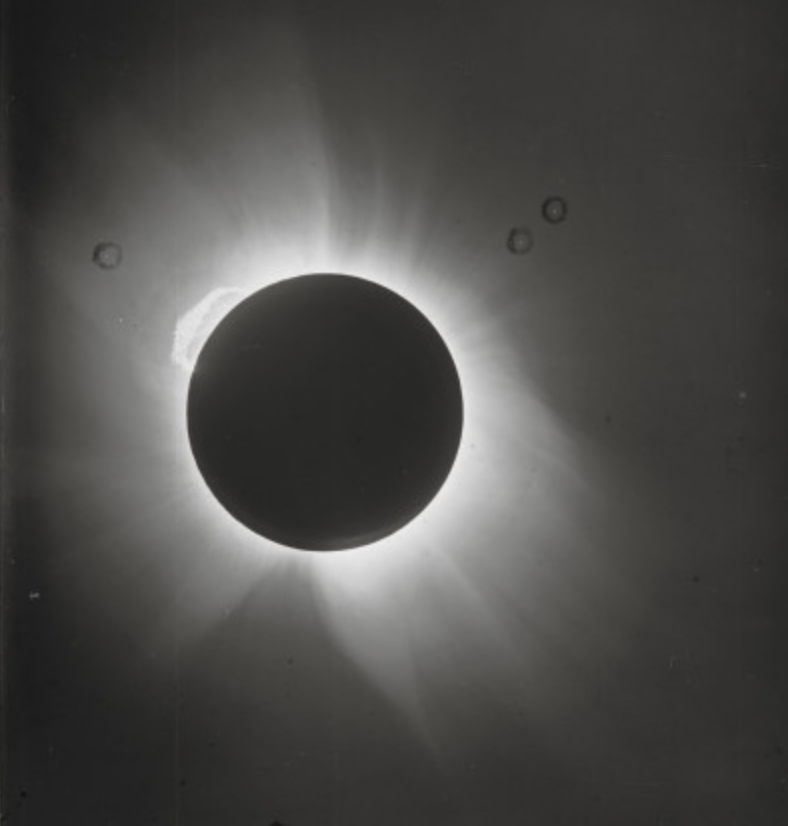
Atomic (1920 - 1860)
1918

Influenza pandemic of 1918-1919
An influenza (Spanish flu H1N1) pandemic from 1918-1919 becomes the deadliest in modern history. It infects around 500 million people worldwide (one-third of the Earth's present population) kills 18-20 million in India, 40 million in Japan and between 50-100 million worldwide. In Nebraska 20,000 people were infected and 1,500 died The Chautauqua Reader 2018.
The first case is identified at the U.S. Army infirmary in Fort Riley, Kansas on March 4 and by the end of the month there are 1,100 cases. The point of origin is a farm in Haskell County, Kansas.
Troops embark to Estaples, France and take the virus with them. The virus spreads quickly through Europe and to the rest of the world.
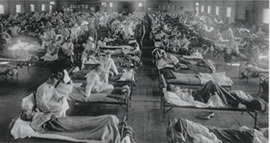
The story of how this epidemic changes the world is in Pale Rider.
More people died from this epedemic than died in World War I.
It is the most devastating epidemic in recorded history. See vaccination fact sheet
See also Pandemic related Pod casts with first person accounts and more: Going Viral: The Mother of all Pandemics
1915
Chemistry: fertilizer, chlorine gas, & zyklon B gas
Fritz Haber and his team weaponized chlorine gas, with the first large scale use in, Ypres France, in 1915.
Haber and Jeroen Bosch creates the Haber process, which makes ammonia fertilizer (NH3) from atmospheric nitrogen and hydrogen gas (1909). It is the first agricultural fertilizer not from animal sources. This process increases the food supply and saves millions of people from starvation and earns Haber the Nobel Prize in Chemistry in 1918.
Haber left Germany for Switzerland and died in exile in 1933. Nazi scientists found his notes that describe a gas called Zyklon B, which Haber's team developed as a pesticide. The Nazis use this gas to kill millions in the Holocaust. Source
A commercial video on the social and ethical consequences of scientific work related to Haber's decisions. (35:00 minutes)
Later, in early 1920's when the Geneva Convention considered a ban of chemical weapons, General Amos Fries looked for other uses for these chemicals and the use of tear gas on civilian crowds is popularized to maintain the production of these gases. Source
1914
The passenger pigeon becomes extinct
The Panama Canal is completed
Ferdinand de Lesseps (Suez Canal fame) advocates, plans, and begins construction in 1881. However, in 1898 due to bad plans, engineering design, and yellow fever epidemics his company gives up and offers to sell their interests.
The United States purchases them, Panama declares its independence from Columbia, and a different design by Adolphe Godin de Lépinay is used to compete the canal in 1914.
Source Britannica
1913
Niels Bohr theorizes the Quantum theory
The Quantum theory states electrons circle a nucleus in unique orbits, depending on their unique energy levels, which are proportional in size to the frequency of the radiation it represents. Electrons jump from one level to another when they absorb or emit photons (a packet of energy) called a quantum. These particles only exist at a level, never in between, and move instantaneously and randomly with quantum leaps from level to level.
Los Angeles Aquaduct is complete
Chief Engineer William Mulholland oversees construction of the 233 mile long aquaduct that brings water from the Owens River to Los Angeles. It is an engineering feat comparable to the Panama Canal. Source
X-ray crystallography
William Bragg and his son William Lawrence Bragg. Design a process that uses X-rays to reveal the crystal structure of salt and diamonds. Later, in late 1951, the process is extended to discover the structures of proteins and later protein complexes.
1912
Blood vessel suture
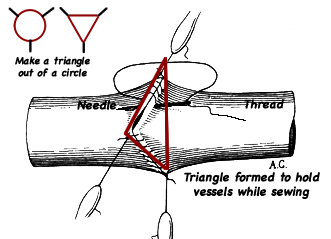
Alexis Carrel and Charles Guthrie solve the problem of how to sew (suture) two blood vessels together.
Blood vessels being tubular are difficult to sew together for several reasons, which they solved by their triangular suture method. Source
Critical discovery to measure the size of the universe with variable stars
Henrietta Swan Leavitt observes Cepheid variable stars in the Small Magellanic Cloud and discovers their brightness is greater, the longer it takes them to complete one cycle. This periodic luminosity function of Cepheid variable stars provides a way to move beyond the use of parallax to measure distances to stars.
And pave the way for Hubble to expand the universe.
1910
Hudson & Manhattan Tunnel opens
The construction of these tunnels are engineering marvels. Tunneling under the river, providing breathable air, and of course tunneling. The tunnel system lets railroads travel under the Hudson river to Pennsylvania Station in New York City.
Previously, all rail service terminated on the west shore of the Hudson River, in Weehawken, New Jersey. To go to Manhattan everything is transfered by ferries, weather permitting. Source
Also 1927 Holland Tunnel
Vitamins, as essential for health, is recognized by Casimir Funk, who collects information about human diseases: beriberi, scurvy, and pellagra. His information leads him to conclude they are caused by a chemical deficiency of amine compounds. Thus, he called them vital amines. Which is later shortened to vitamin, when it is found not all vitamins contain amines. See the discovery stories five vitamins:
Forest management and forest fires and the Big Burn
The summer found the mountains hot, dry and highly combustible, which feed more than 1,000 fires in northeast Washington, northern Idaho, and western Montana, with most created by lightening.
On August 20, 1910, winds that exceeded 72 mph spread the small fires into big ones. 36 hours burnt an area the size of Connecticut (3 million acres). Kills at least 85, changes forest management, and leads to the creation of Smokey the Bear (voice by Sam Elliot). Other American devastating fires.
1908
Ford assembly line
Henry Ford uses standardized parts and an efficient assembly line to create an affordable car for the common man. A car every 22 seconds rolls off the line and sells for $850. By 1920 he is selling millions a year.
1906
The pure food and drug act is the first consumer protection law to protect the American food supply. American women, doctors, and editors work together to convince Congress to pass the bill.
The Jungle by Upton Sinclair keeps public attention on the importance of food inspection laws to insure a safe meat supply from meat packing plants.
Later congress creates the Food and Drug Administration (FDA) to ban foreign and interstate traffic in contaminated and mislabeled food and drug products. To achieve this:
- It directed the U.S. Bureau of Chemistry to inspect products and refer offenders to prosecutors.
- It required labels to identify active ingredients.
- Required products to be within purity levels established by the United States Pharmacopeia or the National Formulary.
- Today the FDA is responsible for protecting and promoting public health through the control and supervision of food safety, tobacco products, dietary supplements, prescription and over-the-counter pharmaceutical drugs/medications, vaccines, biopharmaceuticals, blood transfusions, medical devices, electromagnetic radiation emitting devices, cosmetics, animal foods & feed, and veterinary products. Source FDA
The Poison Squad is a book that tells the story of how its first chief chemist: Harvey Washington Wiley, citizens, and government can work together in meaningful ways for consumer protection.
1905
Nettie Stevens discovers the male chromosome determines sex
Stevens observes a difference between female and male mealworm sex cells. She notices the sperm has two versions of their 20th chromosome: a smaller version and a largeer one. She then concludes the spermatozoa, which contains the smaller chromosome, determines a male mealworn, while spermatozoa that contains 10 equal sized chromosomes determines a female mealworm. She did not call them X and Y chromosomes. That terminology was coined later. Source VOX
Albert Einstein discovers the photoelectric effect
The photoelectric effect is the emission of electrons from a metal surface when a photon (light particle) strikes it. The energy released is determined by the energy of the light and the electron position in the metal.
Conveyor belt
Thomas Robins gets a patent for an improved conveyor belt when he starts a company to move coal for the Thomas Edison Ore-Milling Company.
A previous patent for a modern industrial conveyor belt is given in 1896.
1903
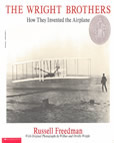 First flight
First flight
Orville Wright pilots the first heavier than air craft to fly over 120 feet in 12 seconds. Orville and Wilbur Wright design, build, and fly a propeller driven biplane powered by gasoline at Kitty Hawk, NC.
For a fast good read about them, their lives, building their planes, creation of the aerospace industry, and government involvement, read: The Wright Brothers: How they invented the airplane by Russell Freedman.
Roald Amundson maps the northern coast of North America.
1902 +
Chemical fertilizer (Nitrogen)
Haber develops an economical process that uses nitrogen (N2) and methane (CH4) gas to make ammonia (NH3).
Bosch conducted more than 20 000 experiemnts to find a catalyst and industrialize the process. It has been used to produce so much fertilizer that about 50% of all nitrogen atoms in humans today come from the Haber-Bosch process.
Wilhelm Ostwald used the ammonia (NH3) from Haber's process and developed an additional process to produce nitric acid (HNO3).
Nitric acid ammonia can be mixed to make a more neutral compound ammonium nitrate. It is a high concentration of nitrogen and can be stored and blended with other fertilizer components. Source How products are made
Mt. Pelee on the Caribbean island of Martinique erupts and kills around 30,000 islanders within minutes, leaving two survivors. A citizen group meets a few days before the eruption and decides the smoke and ash does not require an evacuation.
1901
The era of big oil begins ( January 10, 1901, ) when a well at Spindletop (Beaumont, Texas) struck oil at a depth of 1,139 ft. The Lucas Gusher goes 150 feet in the air and blew 100,000 barrels (4,200,000 gallons) per day for nine days before it was capped. Beaumont becomes a boomtown as its population grows from 10,000 to 50,000 in three months.
Marie Curie studies radiology and her work leads to the discovery of the new elements: polonium and radium.
When World War I begins, she realizes that X-ray technology could play an important role in the care of wounded soldiers. She raises money to develop a fleet of mobile radiology labs, teaches herself to drive, maintain cars, learn human anatomy, and how to operate the X-ray machine. Then she teaches others, among them her daughter Irène, and they drive to the battlefront and help X-ray wounded soldiers.
Wilhelm Conrad Roentgen discovers x-rays in 1895.
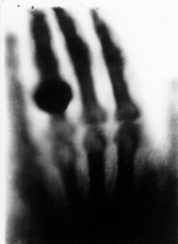
First medical x-ray is taken in Birmingham, England on 11 January 1896 by John Hall-Edward of the hand of an associate with a needle stuck in it.
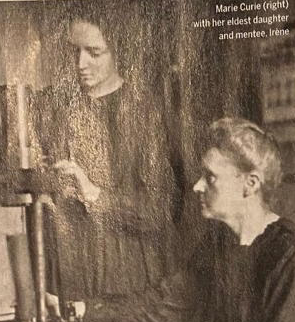
Marie Curie and her daughter Irene
Source
Forty-five female researchers passed through her lab in her lifetime. Check out some biographies!
1900
One in 38 railroad employees are injured on the job and 1,399 die this year. Source Doctors Derailed: How Railway Surgeons Advanced Medicine. Discover Magazine. July/ August 2016.
Energy as quanta
Max Planck suggests energy is transferred in tiny discrete bundles as quanta, rather than continuously.
Chicago River is reversed
As Chicago, IL grows its sewage and industrial waste flows into the Chicago River, which flows into Lake Michigan. As Chicago grows, this becomes a problem since Lake Michigan is the source of the cities drinking water.
The pollution carries diseases like typhoid and cholera, which enters the water supply.
Ellis Chesbrough, engineer, suggests to reverse the flow of the river, so it flows south into the Mississippi River and towards St. Louis. The job is the largest earth moving project by any city government.
1899
The Chlorine Revolution starts in Jersey City, NJ
When the water supply from the Passaic River is contaminated, the city contracts Patrick H. Flynn to find a new source for a clean water supply. Twenty-three miles west of the city, on the Rockaway River, a dam is built to create a reservoir.
However, after the contstruction there are several times a year when rain would cause the sewage system to overflow and contaminate the water. The city claims the engineer should have planned better and refuses to pay for the construction.
Flynn consults with Dr. John L. Leal who believes bacteria is contaminating the water and suggests it could be treated with chloride of lime (chlorine).
The water is treated succesfully, the judge accepts the soution, and orders the city to pay for the construction. Source The Chlorine Revolution: Water Disinfection and the Fight to Save Lives, by Michael McGuire, 2013.
Purified water has saved millions of lives and raises life expectancies by some estimates, forty years.
Sources for
1898
 America's food supply is expanded
America's food supply is expanded
David Fairchild is a botanist, financed by Barbour Lathrop who convinces James Wilson, the Secretary of Agriculture, to accept seeds and plant cuttings that David ships to DC to distribute to farmers to diversify American food production.
He ships magoes and dwarf oranges from Jamaica, avocadoes from Santiago, Chile, fava beans and broccoli from Venice, Italy along with seedless grapes: purple sultanina, and light-green varieties to become raisins. Kale from Croatia and hops from Polepy, Czech Republic. He also brought Cherry trees from Japan as ornamentals for his garden that became the inspiration for the DC tidal basin cherry blossoms that is a gift from the city of Tokyo.
Source The Food Explorer: The true adventures of the globe-trotting botanist who transformed what America eats. by Daniel Stone
First T-shirt
The U.S. Navy issues slip-on white cotton undergarments with no buttons a crew-neck and short-sleeves to wear under uniforms.
Sailors ware them without their uniforms in submarines and tropical climates. Later T-shirts became popular for workers in industries, agriculture, and young boys because they are easily cleaned, inexpensive, and fit well.
T-shirt appears in the Merriam-Webster Dictionary in 1920 and becomes more popular in 1947 when Marlon Brando wears one in A Streetcar Named Desire. After which it becomes a fashionable garment.
1897
Military bicycles
The 25th Infantry Regiment Bicycle Corps, composed of Black buffalo soldiers, rode bikes 1,900-miles from Montana to Missouri to test the use of bicycles for military transportation.
Source Smithsonian Magazine
1895
First Ecology book
Eugene Warming visits the Brazilian savanna between 1863-1866 and later writes several books about plant communities. Including, Plantesamfund (Oecology of Plants). It's the first book with a title specifically about ecology.
Radio waves
Guglielmo Marconi, an electrical engineer explores long-distance radio transmission, and develops Marconi's law and a radio telegraph system.
Often credited as the inventor of radio, an entrepreneur, businessman, and founder in Britain in 1897 of The Wireless Telegraph & Signal Company. Later the Marconi's company, built on the work of previous experimenters and physicists, and becomes a commercial success in radio.
Wilhelm Conrad Roentgen discovers x-rays
1891
First fiber glass.
Charles V. Boys uses a cross bow, with a hot glass rod as an arrow, that he heats to the point of melting, and then fires it. The result is a few microns diameter thread 30 m long. He finds it to be very strong and uses it to build devices to measure radiation and gravity. Unknown to him it was the first fiber glass. Source
1889
Suzanne LaFlesche Picotte becomes the first female Native American doctor.
First book on soap bubbles: Soap - Bubbles and the Force which mould them
An insect, Icerya, is killing orange trees in California and threatening the existence of the orange industry
Charles Valentine Riley sends Daniel Coquillett and Albert Koebele to Australia to find a natural enemy for this invasive pest. They return with a ladybug variety. It is studied, released, and controls the infestation. The introduction of the Novius ladybug to California becomes the standard against which all biocontrol efforts will be measured. Source
1888
Maurice d'Ocagne creates nomograms
A nomogram is a graphical method to solve mathematical equations such as using a scale to convert a temperature in Fahrenheit to Celsius. Books with hundreds of them are published and used before digital computers.
1887
Germ theory
Louis Pasteur a chemist and microbiologist discovers the germ theory of disease, the principles of vaccination, microbial fermentation, and pasteurization (named after him).
Germ theory explains the causes and preventions of diseases, which becomes the foundation of modern medicine, hygiene, and public health. He, Robert Koch, and Antonie van Leeuwenhoek (1670) are noted for their early work in bacteriology and microbiology.
Pasteur's works are credited with saving millions of lives through his development of vaccines for rabies, cholera, and anthrax.
1886
American Bison number decline to about 300
William Temple Hornaday, a taxidermist, travels to Montana to collect American bison to display in the National Museum. He is shocked to learn that the large herds of bison he saw years before are gone.
He collects his specimans, and also some live bison, and ships them to Washington, DC. Where he displays them at the Smithsonian Castle.
His exhibit is very popular, but the live animals are more popular, which become the star of the Smithsonian National Zoological Park. His work helps save the species. Source
Carl Benz patents a Motorwagon
It has a four-stroke internal combustion engine. His wife drives it 65 miles to visit her mother refueling with solvents bought at local pharmacies.
1883
First use of the term scientist
The British philosopher, William Whewell, at the British Association for the Advancement of Science, suggests that since the practitioners of art are called artists, then the practitioners of science ought to be called scientists. Suggesting they should no longer be called philosophers.
Eugenics
- Eugenics is the ideas of nature vs. nurture and concludes nature can be used to improve a population.
- Francis Galton believes eugenics can be used to increase the amount of people deemed desirable and to reduce the number of undesirable or defective people.
- Desirables could be increased by encouraging physically and mentally superior people to choose partners with similar traits. And reduce undesirable births through sterilization of undesirables.
- This belief in humans as malleable prompts attempts to engineer a better society by segregating populations, engineering others either out of existence, or genetically engineering them to create better people or groups of primate hominids as a working caste.
- Others believed that since we are all one common human population group and fundamentally equal, despite our variations in our appearances; and if we would accept all our differences as inconsequencal, we should be able work together and achieve whatever we desire together.
First modern vending machines
- First vending machine see 50 BCE
- 1883 In England Percival Everitt invents a machine that dispenses postcards, envelopes, and paper in railway stations and post offices.
- 1884 In the U. S. William Henry Fruen patents an Automatic Liquid-Drawing Device that dispenses drinks.
- 1888 the Thomas Adams Gum Company build machines to sell gum at New York City train platforms.
- 1897 Pulver Manufacturing Company adds animation of small figures to encourage people to buy gum from their machines.
Ringer's solution is created
Sydney Ringer explores saline solutions and finds a combinatin of sodium bicarbonate, potassium, calcium and chloride ions, that work like blood, to keep a frog's heart beating.
In 1930 Alexis Hartmann replaces sodium bicarbonate with sodium lactate to make lactated Ringer's or Hartmann's solution which will be used to replace blood in IV bags for people who have lost blood, suffered burns, or are severely dehydrated.
1882
Arthur Schuster photographs a comet and corona during a solar eclipse May 17, 1882.
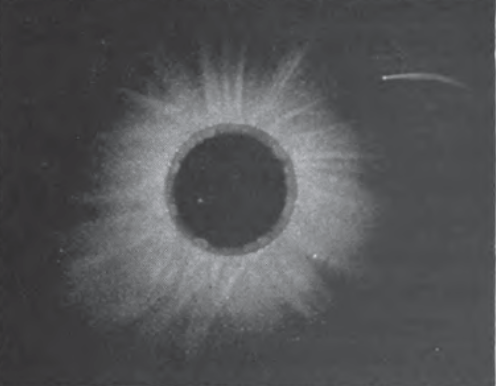
1880
Pullman Company town
George Mortimer Pullman's philosophy is, happy workers make more productive workers so the quality of his company owned and maintained houses is very good for worker housing, compared to typical worker housing. As a result the majority of Pullman employees live in his houses, which contain two to seven rooms with each having direct access to a private yard, woodshed and paved alley. A variety of housing types are designed and available in each block throughout the town to meet different income, status, and family makeup. Source
Light bulb and electrical systems
Joseph Swan instals light bulbs in homes and landmarks in England in the early 1880's. His house is the first in the world to be lit by a lightbulb and the first house in the world to use hydroelectric power.
Others who worked on the light bulb include: Henry Woodward, Matthew Evans, William Sawyer and Albon Man.
The home of Lord Armstrong at Cragside is also among the first houses to be lit by electricity. He starts his company and lit the Savoy Theatre in the City of Westminster, London making it the first public building in the world to be lit entirely by electricity.
Around the same time Edison found how to make longer burning light bulbs using:
- a more effective incandescent material,
- creating a higher vacuum in the bulb, and
- using a high resistance. Higher resistance also allowed power to be distributed from a central source, making an economical sytem.
This lead to a completly integrated system of electric lighting with a centrally located massive generator and a parallel-distribution system. All built by the Edison Illuminating Company of New York that could supply electricity to 59 customers in a square-mile area of lower Manhattan. Thus Edison's genius was not only the light bulb, but the system to make it work in a community.
Electrical power stations are built around the world to power electrical systems:
- London 1882
- New York 1882
- Milan 1883
- St. Petersburg 1883
- Berlin 1884
1876
Birth of modern bacteriology
Heinrich Hermann Robert Koch is a doctor and microbiologist who builds on Pacini's discovery of bacterium and advances the theory that bacteria is a group distinct species, each species with unique properties. This is counter to current popular belief that bacteria have different properties, but they are derived from the same species.
With the discovery of bacteria he establishes that specific bacteria cause specific diseases, such as tuberculosis, cholera and anthrax, he becomes one of the main founders of modern bacteriology along with Louis Pasteur. By proving the germ theory of diseases and a scientific basis for public health.
The American Chemical Society is found by John William Draper
First internal combustion four-stroke engine
Nicolaus August Otto makes his engine to use to pump water and for other factory jobs. He builds 30,000 until he loses his patent.
1875
Treaty of the meter in Paris, May 20, 1875
is attended by 17 countries who create the international bureau of weights and measures, which adopts the metric system internationally. See also metric system history and U.S.
First American steel mill
Andrew Carnegie returns from England in 1872 having learned about the Bessemer process for making steel. He increases the scale of the furnace and builds his first steel mill, Edgar Thomson Steel Works, in 1875 in Braddock, Pennsylvania, (near Pittsburgh).
For the first time steel is mass produced inexpensively; making it so successful Carnegie is able to use the profits to buy other Pittsburgh steel mills and create the Carnegie Steel Company in 1892.
Telephone
Thomas Watson is freeing a spring on the transmitter and causes a click that is heard by Alexander Graham Bell at the receiver in another room. A serendipity discovery which leads to the telephone.
Twin studies
Study of History of Twins is published.
- In it Francis Galton coins the term nature versus nurture.
- The study provides strong evidence for genetic heritability of many traits.
- He writes:
- Unfortunately Galton uses his findings for the basis of his theory of eugenics.
Provides strong evidence for the importance of twin studies for understanding development.
Twins have a special claim upon our attention; it is that their history affords means of distinguishing between the effects of tendencies received at birth, and of those that were imposed by the special circumstances of their after lives.
1874
Barbed wire
Joseph Glidden is granted a patent for barbed wire on November 24, 1874.
He goes into partnership with a merchant, Isaac Ellwood, and they form The Barb Fence Company. Read How Joseph invents his wire and the history of barb wire by the Kansas Barbed wire museum.
Barbed wire is first used to enclose cattle and other domesticated animals.
Later it is used to enclose private property, prisoners within prisons, battlefields, and stop migration.
DDT is synthesized in 1874. However, it is not until 1939 when it is discovered that it could be used as an insecticde.
First bridge across the Mississippi River, south of the Missouri River, opens
The Eads Bridge, named for James Buchanan Eads, the bridge's designer and builder, is a highway and railway bridge that connects St. Louis, Missouri and East St. Louis, Illinois, near the present day Gateway Arch.
A caison is build in the river to construct a 100 foot deep pier anchored to bed rock. Air is pumped to workers who must take precautions to avoid the bends.
The structure is the longest steel arch bridge. When it was finished some people are afraid it will collapse so 14 locomotives were lined up across it to show its strength.
1870
National Weather Service is established
1869
Transcontinental railroad is open for through traffic on May 10, 1869 with the ceremonial driving of the last spike. The spike, referred to as the golden spike, is driven with a silver hammer, at Promontory Summit, Utah.
Suez Canal is completed through the leadership of Ferdinand de Lesseps, French developer and diplomat. See Panama Canal
Periodic Table of Elements is created by Demitri Mendeleev.
Source Royal Society of Chemistry
Demitri Mendeleev presents to the Russian Chemical Society in March, 1869 his Periodic Law.
He states, ... elements arranged according to the value of their atomic weights [today atomic mass or number is more accurate] present a clear periodicity of properties.
His version has 70 elements with gaps where he believes unknown elements belong. Using the properties of periodicity he successfully predicts properties for three of the gap elements. Source This Day in History
1868
First Planned suburb
Riverside, Illinois is the first planned commuter suburb. It is a suburb of Chicago Illinois accesible by train.
Although at the time it isn't known as a suburb, but as a town near the downtown. While towns were designed in a familiar checker board fashion, Riverside is the first where roads were curvalinear and didn't meet with 90 degree angles. Designed by Frederick Law Olmsted. Source PBS wttw
First Canned meat
Deviled ham meat spread is first canned in 1868 by the Underwood Deviled Ham company. The company is found in 1822 by William Underwood who was packing food in glass containers.
In 1836 he changes to steel cans coated with tin.
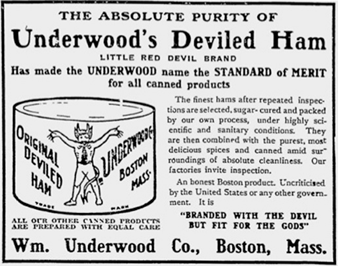
Discover spectral line for Helium
Pierre Jule Cesar Janssen and J. Norman Lockyer independently discover an unknown spectral line during an eclipse in August 18, 1868. Believing it a new element, they name it helium. 27 years later it is found on Earth.
Henry T. Brown publishes the book Five Hundred and Seven Mechanical Movements it has samples of mechanisms from the industrial nations.
1866
John A. Roebling Suspension Bridge opens
Across the Ohio River connecting Cincinnati, Ohio and Covington, Kentucky. It is the longest suspension bridge in the world at 1,057 feet (322 m) main span made from the first iron rope cable. Later in 1883 Roebling's most famous, Brooklyn Bridge is longer at 1,595.5 feet.
1864
Rebecca Lee Crumpler becomes the first Black woman in the U. S. to earn a medical degree
- She was raised by an aunt in Pennsylvania
- Worked as a nurse and community healer.
- Publishes, A Book of Medical Discourses: In Two Parts, in 1883. I
- t is part memoir and an effort to share both clinical advice and her experience as a Black woman physician.
- She writes,
Having been reared by a kind aunt in Pennsylvania, whose usefulness with the sick was continually sought, I early conceived a liking for, and sought every opportunity to be in a position to relieve the sufferings of others.
- It is these kinds of experiences that inspire her to pursue a life as a doctor of medicine.
1863
First car with an internal combustion engine
Jean Joseph Etienne Lenoir makes and drives his seven miles out of Paris. It is very heavy and slow.
1862
is measured as 298,000 km/s by Leon Foucault who designs a more accurate method to measure the speed of light.
First American use of balloons in war
In the American Civil War the Intrepid and Union balloons for the Union and the Gazelle for the Confederate are used for reconnaissance. They could reach 1,000 feet and communicate reconnaissance information with signal flags or telegraphs. Thaddeus Lowe is named chief aeronaut of the newly created Balloon Corps. Source Earlier use in Europe see 1794
1861
Maxwell's electric and magnetic equations:
James Clark Maxwell's publishes equations to describe how electric and magnetic fields are generated, interact, and are changed by each other and their charges and currents.
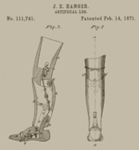
First movable prosthetic
At the Battle of Philippi, Virginia, an amputation is performed on James Edward Hanger (18). Since his leg is removed just below his hip, a solid prosthetic makes walking cumbersome and nearly impossible.
James invents a hinged limb that revolutionizes the field of prosthetics. He goes on to patent his invention and start the J.E. Hanger Artificial Limbs company. Source
Industrial 1860 - 1500
1860
The spark plug is invented
However its use is limited until the invention of the ignition magneto, an early form of an alternator that generates and delivers sparks in pulses, in 1902. Source
Karl Culmann develops a system to calculate stresses in a truss for roofs and bridges graphically with a force polygon.
1859
Oil well
The first successful oil well is drilled in northwestern Pennsylvania. Known as the Drake Well, after Colonel Edwin Drake. It begins an international search for oil and energy use. Source
Charles Darwin publishes: On the Origin of Species.
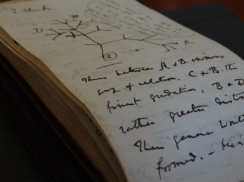
He and Alfred Wallace share their ideas on how life changes and adapts: evolution. Darwin writes his ideas before Wallace, but did not publish them.
Ideas related to Darwin:
- Evidence for Darwin's ideas on evolution go back to at least when he draws a sketch of the Tree of life in his notebook in 1837.
- His only statement in On the Origin of Species that relates to humans being shaped by evolution is the statement: Light will be thrown on the origin of man and his history.
- Ten years later, he publishes two books: The Descent of Man and Selection in Relations to Sex, and The Expression of the Emotions in Man and Animals does he focus more on humans and evolution.
- In Descent he makes statements at one point that are racist, when he claims differences are based on race. However, he also claims natural selection does not differentiate between the races. And supports it by writing, that any traits used to characterize any racial differences appear to be unrelated to any capacity for success.
- The text also includes sexist statements.
- Unfortunately instead of his ideas on evolution being used to support how fragile life is, because each organism is dependent on a sustainable ecosystem for survival. Evolution is used to focus on survival and fitness and will be use to justify colonialism, monopolistic economics, racism, and other ideas that benefit individualistic sources of power at the expense of communities, families, other groups, and a sustainable world.
By mistakenly elevating the idea that power is most important for survival; devaluing the importance of living in harmony in a caring community with kinship to maintain an interdependence to sustain a healthy environment. - Complete library of Charles Darwin's writings
- Scopes trial 1925
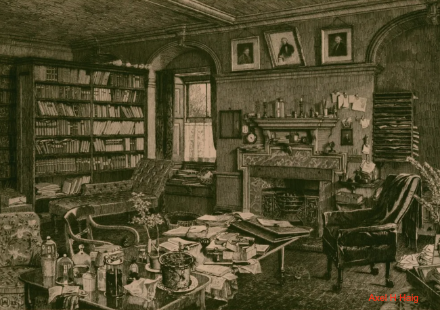
1858
First Trans Atlantic Cable completed ...
It connects N. America to Ireland. The first message is sent by Queen Victoria to US president James Buchanan congratulating him on the successful completion of this great international work. The message travels through 2,500 miles of cable and takes 16 hours. It's Accomplished by Cyrus Field with grit, determination, and persistence for over ten years.
Can opener invented
Ezra J. Warner invents and receives a patent for the first can opener in 1858. It used by the US military in the civil war.
In 1866 William Lyman improved it with a wheel that rotates along the top rim of the can and receives a patent for it in 1870. Source
1856
First Neanderthal skill found
Workers in the Neander Valley, along the Dussel River, are quarring limestone. When they remove five feet of mud from the cave's floor, they discover a skull and fifteen other bones. The discovery opens exploration into how old the bones (later found to be fossils) are, if they are human, and what abilities Neanderthals have. See many more entries on Neanderthals in this timeline to find answers for your questions.
1855 + -
Elevator
A lifting devices with ropes and pulleys is described and used by Archimedes, in the Roman Colosseums, Louis XV, and others. However, they were slow and unreliable with the use of ropes, which could wear out and fail.
In 1852, Elisha Graves Otis invents a safety break that changes that. If there is a cable break, a spring would push pawls on the car into position racks on the sides of the shaft and hold the car in place. Such a devise is installed at a five-story department store in New York City in 1857.
Commercial passenger elevators allow the building of the world's first skyscrapers opening cities to an explosion of population and real estate value as building rose literally hundreds of floors. The Otis Elevator Company, is a subsidiary of United Technologies Corporation, the world's largest manufacturer of vertical transport systems. Source
1854
Filippo Pacini discovers bacterium. Particularly the cholera bacterium Vibrio cholerae.
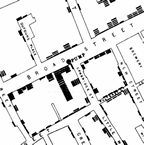
Cholera source identified with data analysis
Dr. John Snowinvestigates the death of over 500 people, in the Golden Square neighborhood of London.
He collects data on where the dead people had lived, maps it, and his analysis leads him to discover a geographic relationship that indicates the source of the cholera epidemic as a local well.
He recommends the removal of the pump handle, which the St. James Parish orders done and the epidemic abates.
1853
Invention of potato chip
George Crum (born George Speck of Native and African American descent) is a chef at Moon's Lake House in Saratoga Springs, New York.
When Cornelius Vanderbilt, unsatisfied with his order of fried potatoes returns them to the kitchen because they were too thick. Crum, as a joke, slices a batch of potatoes as thin as he can, fries them to a crisp, and serves them to Vanderbilt. Vanderbilt is overjoyed. Crum continues to make the chips, puts them on every table, and the potato chip is invented.
1852
Great Auk extinct in the Falkland Islands
1851
Ice making machine
Dr John Gorrie, finds that when yellow fever patients were cooled with ice, they had a better chance of recovering. Being in the south ice is only available when it was imported from New England. To make ice available all year he explores how to make ice with refrigeration and cool rooms with air conditioning. His invention is granted a patent for a machine that made ice by compressing and cooling air. Source
1850
1848
The American Association for the Advancement of Science is found
1847
Germ theory
Dr, Semmelweis is mystified by the fact that maternal death rates are three times higher in obstetric wards than for home births delivered by midwives. He connects a janitor's comment about washing with bleach to kill the stink with the idea of dirty hands being related an increased rate of deaths. When hand washing with chlorinated lime solution is introduced, deaths are reduced from 10% TO 1%. The idea of microorganisms isn't yet accepted and he is committed to an insane asylum and dies from an unwashed wound. See 1887 germ theory
1846
Modern sewing machine
Elias Howe receives a patent for the lockstitch sewing machine which joins thread from a needle with its hole in the tip where it goes into the fabric and joins thread from a bobbin below the material. Also added an overhanging arm, and an automatic feed for the fabric for a modern day sewing machine. Out of the box thinking. Reduced the time for making a shirt from fourteen hours to one hour.
Source
1843
First complete computer program
Ada Lovelace publishes an algorithm or sequence of steps to perform a computational task with a computing machine designed by Charles Babbage, which is never made, to calculate Bernoulli numbers. Source
1840+
Guano (bird droppings) as fertilizer
Europe and other countries, with depleated soils, seek ways to keep their soils fertile. One is to add manure to the soil.
On Peru's Chincha Islands explorers find mountains of bird excrement hundreds of feet deep. The guano deposits are high quality. And with a high demand for manure, the idea that a fortune could be made sends investors to the region to mine and sell the guano as fertilizer. Soon countries are exploring the world for other areas rich in guano and claim mining rights. Wars and territorial disputes develop.
1838
Friedrich Wilhelm Bessel uses parallax to calculate the distance to star, 61 Cygni, and concludes it is 10.3 light years away from Earth.
1837
First iron plow is made
John Deere, a blacksmith in Grand Detour, Illinois picks up a broken steel saw from a mill and uses it to make a plow.
1831
The British Association for the Advancement of Science is found
Cyrus McCormick invents the threshing machine
The machine increase the rate of harvest by five times.
1830
First passenger railroad opens between Liverpool and Manchester. England
As the train approaches the some of the awaiting crowd misjudge the speed of the engine and get ran over.
1827
Browning motion
Robert Brown, looks at plant pollen (Clarkia pulchella) placed in water and sees particles jiggling randomly in the water. Claims subatomic motion causes the pollen's movement.
1820
England deliberately exterminates beavers in the Oregon Bridge Creek area to keep trappers (particularly U.S.) from going into Oregon and claiming the Territory for the United States.
Antarctica is probably first seen in 1820, by Fabian Gottlieb von Bellingshausen and Mikhail Lazarev.
- The first confirmed landing is by a Norwegian team in 1895.
- In the early 1900's, there are several expeditions inland.
- Douglas Mawson, Edgeworth David, and Alistair Mackay are the first to reach the magnetic South Pole in 1909.
- The geographic South Pole is first reached in 1911 by Roald Amundsen.
1817
Erie Canal
Construction begins to create a water route from the Atlantic Ocean to the Great Lakes. It is created as the New York State Canal System. It begins in Albany, New York and extends 363 miles to Buffalo, upstream of Niagra Falls, on Lake Erie. Before rail travel, 60% of all goods traveling east and west travel on the Erie Canal. Source Britannica
So noteworthy Thomas S. Allen wrote a song for it: Erie Canal - five verses worth (3:53) YouTube. More history on the song by Dave Ruch.
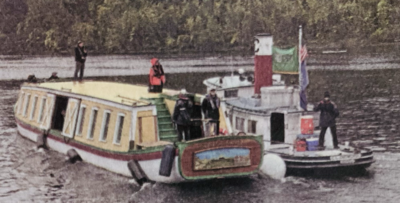
1816
Stethoscope
Renѐ Laennec is a muscian and doctor who invents the stethoscope. He records his first observations of the heart as musical notation and pioneers listing to chest sounds to diagnose various medical conditions.
1807
Alexander von Humboldt publishes: Views of the Cordilleras
He links science with the human experience to include science, art, culture, geography, history, and linguistics. His ideas include:
- All diverse people of the world are one species.
- No one group of people is superior to or dominant over others.
- Opposes colonialism, imperialism, & slavery.
- Claims science is not perfect, but necessary, but not sufficient to develop a healthy relationship with the living world and its environment.
- Introduces the concept of isotherm: a region defined by its average mean temperature of 6 degrees C for its growing season, which matches the global tree line. An area that supports more diverse life than any other terrestrial system.
1806
Preservation of food
Nicolas Appert investigates the peservation of food and discovers: that boiling and storing fruits, vegetables, meats, soup, and milk in airtight glass containers preserves them. It is developed so Napoleon can feed his troops in the field. Source Britannica
1805
Francis Beaufort develops the Beaufort scale.
It classifies wind on a scale from 0 (calm) - 12 (hurricane). Mostly determined by watching wind interact with objects.
Other wind related discoveries ... not yet dated.
- The Saffir-Simpson scale uses Category 1 (caution) to category 5 (catastrophic).
- Enhanve Fujita (EF) scale to classify tornados, EF0 (weakest) EF5 (strongest).
- George Hadley describes a circulat pattern for winds in the tropics where warm air, moist air rises, travels to the poles, cools, descends in the subtropics, and returns to the equator.
- William Ferrel described a Ferrel Cella cirucar patter in the mid latitude atmosphere.
- Rossby waves form across the globe and affect the movement of the jet stream.
1799
The Conservatoire des Arts et Métiers includes several three dimensional workshops that created the plates for Diderot's Encyclopedia for the Duke of Orleans' children.
1798
Robert Malthus publishes An Essay on the Principle of Population.
He argues population will increase at a rate greater than food production. He bases his conclusion on a finite limit of land for crops, a geometric rate of population growth, and an arithmetic rate of increasing food production. His theory influences Darwin and his theory of natural selection; and years later Keynes and his Keynesian economics.
1795
The metric system
To standardize measurement across France, the metric system is adopted on April, 7, 1795.
Jean-Baptiste-Joseph Delambre & Pierre-Francois-Andre Mechain spend more than seven years of extensive research to create the metric system. As they traveled across France they face extreme weather, inhospitable terrain, hyper inflation, epidemics, and constant threat of violence from skeptical citizens and their curious endeavor.
They create a system based on the decimal system, use the meter for length, liter for volume, and the kilogram for mass. It is later dropped by Napoleon in 1812, but readopted in 1840. Source
- See 1875 for international conference.
- See metric system history and U.S. - When considering changing to the metric system, Thomas Jefferson asks John Quincy Adams … Shall we mould our citizens to the law, or the law to our citizens?
1794
The first recorded use of balloons by military forces
Balloons are used for reconnaissance during the French Revolutionary Wars by the French Corps d' Aerostiers. See later 1862
1793
British citizens board the Hankey and two other ships and set sail to West Africa
They want to start a colony to undermine the Atlantic slave trade by hiring, rather than enslaving Africans. Poor planning and tropical diseases, especially yellow fever, decimate the colonists. They give up their efforts, depart, and return to England by way of the Caribbean Islands. Taking yellow fever with them, which creates an epidemiological tragedy, transforming North America, Europe, Africa, and the Caribbean islands. See more at NYAM history.
Eli Whitney invents the cotton gin and effects slavery
Whitney had a genius ability to reconize and develop innovations. In South Carolina he observes how hard it is to remove seeds from cotton so he invents the cotton gin, a machine that could clean ten times as much cotton as a slave by hand. Source PBS Who made America
1790
United States Patent Office begins to require a model for every invention. Each is to be no larger than 12 inches square. The public has free access to the collection. This requirement continues until 1880.
1787
James Madison recognizes that a census could be a scientific method to decide how to distribute political power. If a census is conducted every ten years, the data can be used to determine how many representatives each state would have. Therefore, a way to guarantee the House of Representatives would equably represent future population changes.
- His idea is mandated by Article I, Section 2 of the United States Constitution.
- The first census of the United States records the population of the United States as of Census Day, August 2, 1790.
- A scientific accurate census can provide information to make wise social, economic, health, medical research, technological, and other important decisions.
- If conducted well it becomes a valuable source to create representative samples for quality research.
1780
Immanuel Kant (1724-1804) Philosopher
Kant claimed that everything we know is a construction by our perceptions, which are shaped by our minds abilities and lack of abilities, of what we percieve as our observations of the world. It is our empirical intuition and subjective reasoning about these perceptions that we synthesize and recognize as our consciousness and existence and understanding of the world with our observation and reasoning.
That pure reasoning (rationalism) without observable data would lead to illusion about the world. Understanding is a function of imagination that bridges thought and perception of observable data to allow us to believe our consciousness exists and there are objects and events in our world which we can discover and understand with our reasoning.
Critique of Pure Reason (1781).
Automated flour mill invented
Oliver Evans uses buckets and screw conveyors to move grain and flour through the milling process and eliminates the need for human lifting or carrying of grain and flour. Source Jeremy Norman's History of information
1772
James Cook explored the Pacific Ocean and added Tonga, Easter Island, and Hawaii to the map. He is killed in Hawaii.
1769
Nicolas-Joseph Cugnot builds a steam powered car
With a huge boiler in front, it travels at 2 mph. It is created to move canon.
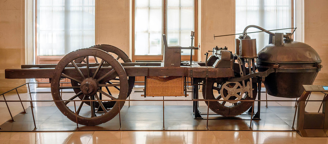
Source Musée des Arts et Métiers, Paris
1768
First English language Encyclopaedia Britannica published in Edinburgh, Scotland Source
1766
Joseph Priestly discovers many gases
- Hydrogen, 1766, and shows water is a compound of oxygen and hydrogen.
- Hydrochloric acid, 1772.
- Laughing gas, 1772
- Oxygen, 1774
- How to make carbon monoxide and ammonia.
- Worked on combustion and photosynthesis.
- Nitrogen is credited to first be discovered by Daniel Rutherford in 1772, who called it noxious air. However, Scheele, Cavendish, Priestley, and others worked with it also.
1765
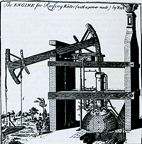
Steam engine
James Watt improves Thomas Newcomen's version of the steam engine, created in 1712 to pump water from coal mines. He adds a separate condenser so the cylinder can be kept heated with each stroke, a shaft that rotates instead of moving up and down, and other improvements to make it available to work for many practical uses and begin the industrial age.
In 1780 he adds a mechanism to move a piston rod in a straight line (parallel motion).
It changes our understanding of energy, economics, and our social institutions by speeding production. It leads to an increased standard of living, consumption, and waste that affects all life systems necessary for survival for the benefit of some and at the expense of others.
1762
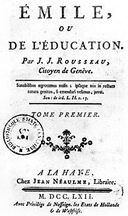 Jean-Jacques Rousseau - (1712 -1778)
Jean-Jacques Rousseau - (1712 -1778)
Wrote and published Emile or a Treatise on Education.
The book is considered the first educational philosophy book as well as the first child psychology book.
Rousseau claims children have a natural goodness and can become critical life long learners and educated citizens if they can survive a corrupted society.
Rousseau is sometimes referred to as the father of modern child psychology.
Also: Education timeline - Rousseau
1760
George Washington experiments with crop rotation at Mount Vernon.
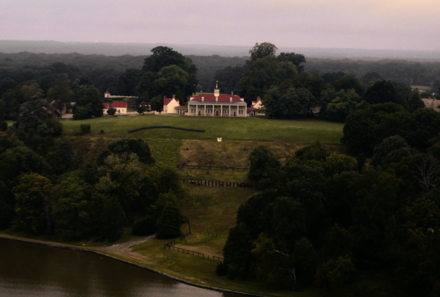
He explores a three year and five year cycle. He draws elaborate charts that show how he divided his fields and the amounts of crops is equalized with flax, hay, clover, buckwheat, turnips, and potatoes being rotated through different fields. Later he expands to a seven year cycle as shown in this table.
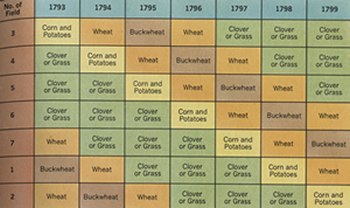
See also Townshend crop rotation.
1758
Classification system - Father of taxonomy
Carl Linnaeus creates a systematic framework for the classification of animals and plants based on visual observation of related properties among organisms.
Any classification system, opens debate to how general or specific the differences between the relationships used for classification should be. Deciding if properties should be widened or narrowed to include more or less species of organisms in a group.
1752
Ben Franklin flies a kite
An American polymath, Founding Father, writer, printer, philosopher, politician, postmaster, scientist, inventor, statesman, and diplomat.
- Experiments with electricity and demonstrates it has positive and negative charges in experiments with Leyden Jars and a kite. The kite is not struck by lightning but it drew electricity to the key and Leyden jar.
- It appears that he knew enough about grounding to protect himself from being electro shocked. Source
- Uses his knowledge that clouds have electric charges and combine to create lightening leads him to create lightening rods to protect buildings.
- Claims the Aurora borealis are created with electrical charges.
- Collects weather data.
- Maps the Gulf Stream.
- Ben Franklin is an anti-vaxer until his child dies of smallpox, then he became an advocate for vacination and made sure his family and friends got vacinated.
- Claims colds are passed from person to person usually within close contact.
- Links the metal lead to health problems.
- Makes a flexible urinary catheter.
- Invents bifocals.
- Creates the Franklin stove. Franklin's stove is freestanding cast-iron, designed for heating efficiency and reduces smoke by rducing the amount of wood used. It takes a bit over an acre of woods to provide one family a winter's supply of fireplace wood. In a time of the Little Ice Age (1300 - 1850) the cold climate, growing population, shrinking woodland, and an inefficient fireplace with a polluting chimney prompts; him to create his stove in 1738. In 1741 sales take off partly due to a very cold year. He works on it and revises it for 50 years, 1738-1786 with five different designs, the first two to burn wood and three in Europe to burn coal.
- Experiments with swim fins. Finds they work on his hands, but ones for his feet aren't as successful, Finds wood doesn't make good swim fins.
- Invents the armonica a musical instrument made with glass and works with vibrations by rubbing glass.
- Opens the first hospital in the U. S. - Pennsylvania hospital in 1751 in Philadelphia. Later it opens the first School of Medicine, in 1765. And, in 1874 the nation's first teaching hospital.
1751
The first modern encyclopedia, is published in 17 folio volumes of text and 11 plate volumes between 1751 and 1772.
1749
First women doctor in the United States
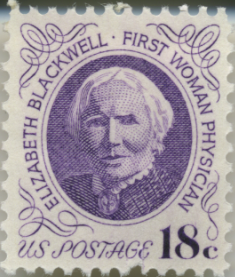
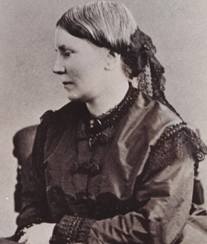 Elizabeth Blackwell becomes the first woman physician in the United States. Her sister, Emily Blackwell, becomes the second. Together the sisters open the New York Infirmary for Indigent Women and Children, the first hospital with an all women staff.
Elizabeth Blackwell becomes the first woman physician in the United States. Her sister, Emily Blackwell, becomes the second. Together the sisters open the New York Infirmary for Indigent Women and Children, the first hospital with an all women staff.
- They add a Women's Medical College with a rigorous progressive curriculum.
- Elizabeth writes, lectures, and promotes medical education specifically for women.
- Emily becomes a very qualified: obstetrician, gynecologist, surgeon and also professor.
- Read more in The Doctors Blackwell.

1735
Graphs theory as topology is first introduced
Leonhard Euler, of Switzerland, solves the Konigsberg bridge problem with graph theory.
Graph theory, is the study of the relationship or connection between things. The things, are represented as points, vertices, vertexes, or nodes; and their connections are represented with lines or edges. Source Mathematical Association of America
John Harrison invents the chronometer that is accurate enough to measures time on a moving ship.
1733
The flying shuttle is invented by John Kay
Videos of operation - see handloom with a flying shuttle. The shuttle runs in a shuttle race attached to the front of the (bottom-mounted) beater bar. (1:36)
It weaves fabric faster and wider pieces.
1724
Jacob Leupold publishes Theatric Machinarum with 500 engraved plates of mechanical devices in 10 volumes, the last released in 1739.
1700
Earth' s human population reaches 600 million
Population changes coming in three species: American bison, Caribou, & Salmon
Change of buffalo or bison nomads after the introduction of the gun and horse. 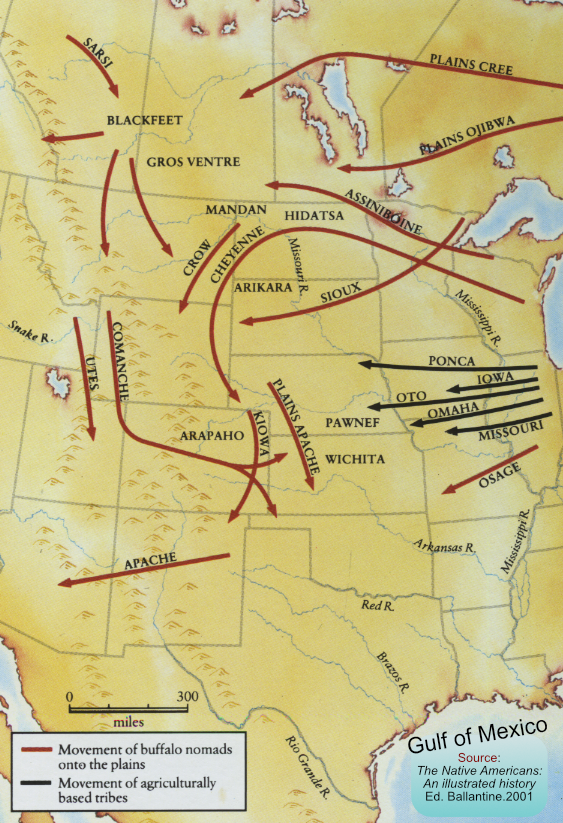
Charles Townshend, investigates a crop rotation based on Dutch and Flemish farming practices. His experiments find crops grow better with fewer weeds, fewer pests, and return nutrients to the soil when he rotates crops through four years: wheat in the first year, clover (or ryegrass) in the second, oats or barley in the third, and turnips or rutabagas in the fourth. See also Washington crop rotation
1688
Louis XIV of France has models of forts build (1:600 scale) for his officers to study how to protect and besiege. They survive and more models are added over the years and today they are displayed at the Les Invalides museum in Paris. Source Musée de l'Armée
1686
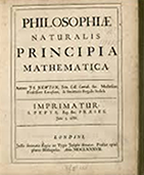
Isaac Newton
- Published Principia Mathematica
- Principia at the Project Gutenberg in Latin
- Principia at the Project Gutenberg in English
- First claimed ... Forceg = G * ((M1 * M2) / d2)
- 1660's demonstrated white light is all colors.
- Newton's laws of motion
1683
Joseph Moxon publishes Mechanick-Exercises or the Doctrine of Handy-works, which describes the trades of printing, smithing, joinery, turning, and bricklaying.
1679
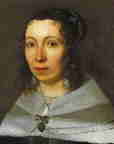
Maria Sibylla Merian publishes first proof a butterfly, caterpillar, & larvae; are one organism
Maria Sibylla Merian, a German naturalist and illustrator observes insects from a young age. She raises silk worms as a teenager, learns illustration from her stepfather, and publishes her first book in 1675. In 1679 she publishes the first of two volumes on caterpillars and the second in 1683, where she documents metamorphosis and life cycles of 186 European insect species. Source Wikipedia
1670
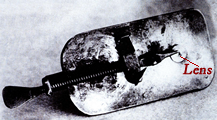
Antonie van Leeuwenhoek uses a simple magnifying glass to observe the quality of fabric. He later grinds lenses and refines his method for better magnification.
He left 247 microscopes and 172 lenses, nine microscopes are known to have survived with a magnification of up to 200 times. The best microscopes of the time. He is the first to observe and take notes about: protozoa, bacteria, red blood cells, spermatozoa, and close observations of other organisms. The microscope provides the technology necessary for microbiology and cell biology. Thanks ... Antonie van Leeuwenhoek Source Brian J Ford
1669
Boyle's Gas law and a vacuum
Robert Boyle and Charles Hooke use a vacuum pump, invented by Otto von Guericke (1649), to investigate the properties of air and properties of a vacuum. Finds: sound does not travel through a vacuum, but magnetism does, liquids vaporized quicker in a vacuum, animals died in a vacuum (see famous public bird demonstrations), and animals could be frozen in a vacuum. The importance of the relationship of temperature and pressure isn't realized until much later with refrigeration and heat pumps.
Their first discovery of air properties is Boyle's Law. They use a glass tube and fill it with different amounts of mercury to vary the pressure on a fixed weight of air. They discovere that pressure times volume equals a constant (p * v = c), if temperature is constant. In other words, when you increase the pressure on a gas, the gas's volume shrinks proportionally. A few years later, 1787, Charles discovers the next gas law.
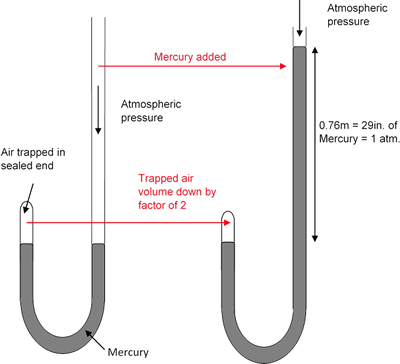
1666
The Academic des Sciences in Paris hires model makers to create a collection of models of many widely used machines: floating bridges, clocks, cranes, grain mills, sawmills, dredges, mathematical instruments, and more.
1662
Dodo extinct in the Mauritius
1661
Robert Boyle publishes The Skeptical Chymist in which he claims everything (matter) is composed of bound atoms (corpuscular, particles, atomism) of a single kind of matter, distinguishable only by their motion and shape.
1656
Christiaan Huygens invents the pendulum clock
It is the most precise time piece until mid 1900's.
1651
William Harvey mistakenly claims: all living things come from an egg.
1650
Cartesian (comes from the Latin form of Descartes - Cartesius)
Rene Descartes develops a system for a graphical representation (Cartesian coordinates) of quantities by locating a point on a plane by its distance from a pair of intersecting lines or axes. Ideas lead to using:
- Intersecting lines or coordinate system with a scale for distance.
- Graphical representing curves (including straight lines) as visual representations of changes and relationships between variables and equations.
- Instantaneous slopes of curves to represent differentials.
- Integrals as areas under curves.
1643
First vacuum & first barometer
Evangelista Torricelli uses a suggestion by Galileo and fills a 4 foot glass tube with mercury and inverts it into a dish of mercury. He observes some mercury flow out of the tube and leaves a space in the tube above the mercury. Being sealed he concludes the empty space is a vacuum.
From his day to day observations, and observations from moving it up a moutain side, he concludes the variation of the height of the mercury is caused by changes in the amount of air above the dish of mercury pushing down on it, atmospheric pressure.
His experiments on air and vacuums explain why water pumps, at the time, are unable to raise water more than about 33 feet. His ideas would related to Boyles Gas law and engines.
1642
Abel Tasmand sails around the continent of Australia and maps the north and west coast.
1638
First printing press in the American Colonies is assembled at Harvard College
1620
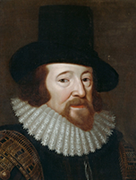
- Publishes Novum Organum, where he describes a system of logic he believes is superior to Aristotle's syllogism (360 BCE ) or deductive reasoning. It becomes known as the Baconian method, inductive reasoning, and the scientific method. Bacon may have been inspired by Ibn al-Haytham's Optics (Kitab al-manazir).
- He believes this new logic is the best way to draw conclusions about the natural world. An inductive approach of skeptical observation and experimentation with facts and explanations leading to conclusions. Because of this he has been called the father of empiricism and the father of the scientific method.
- Bacon asks for a writing of a history of trades to serve as a foundation of his new science.
- In 1624 he plans for Salomon's House (a research center) where different groups of people can decide, at different points of time, what to research and what to develop. For example, what experiments to discover the true nature of things, what discoveries are valid, how to use them, what are best practice for man's life and knowledge, and how to deliver to the public the stuff of progress.
William Oughtred invents the slide rule by arranging two Gunter logarithm scales (straight lines of numbers scaled by distance apart) that slide past each other so they could be added or subtracted easily for multiplication and division.
Slide rules can give numbers that are good enough for engineer work.
1614
John Napier invents logarithms, an exponent, to multiply and divide by adding or subtracting exponents.
Henry Briggs calculates the logs of 30,000 numbers to 14 decimal places and arranges them in tables, which are used until the invention of computers.
1610
Galileo Galilei (1564-1642) Publishes Starry Messenger
- Turns his telescope upward and observes the mountains of the moon, additional stars, planets orbiting the Sun, and four moons orbiting Jupiter; then wrote about it in Starry Messenger.
- His stance, that facts should govern life, not belief; and support of the Copernican theory (Earth orbits the Sun) got him put under house arrest, forbade him to write any more, and wasn't allowed visits by mathematicians. 1633. Source
- Drops different sized canon balls off the Tower of Pisa and demonstrates that heavy and light objects fall at the same rate.
- Explores inertia and friction. Source
Pre industrial revolution (1600 - 1 000)
CO2 (carbon dioxide) in atmosphere is 270 parts per million
1588
Agostine Remalli publishes Le Diverse et Artificiose Macine (Divers and Ingenious Machines)
It includes 195 copper plate engravings of grain mills, sawmills, cranes, water-raising machines, siege devices, military bridges, and hurling engines.
1585
Pope Sixtus asks for proposals to move the 100 foot high, 330 ton, Vatican obelisk.
Domenico Fontana makes a proportional model with lead, timber, rigged with ropes and pulleys to demonstrate his method, and wins the job.
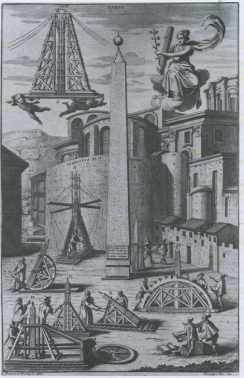
1582
The Gregorian calendar or Western calendar or Christian calendar, is named for Pope Gregory XIII, who introduces it in October 1582.
1578
Sir Francis Drake maps Tierra del Fuego a the southern tip of South America. See History timeline
1565
Pedro Menendez de Aviles lands on the shore of Matanzas Bay and founds the city of St. Augustine, Florida.
See History timeline
1556
George Agricola publishes his studies of mining and metallurgical processes in De Re Metallica with over 250 odd engravings to illustrate and describe tools, vessels, sluices, machines, and furnaces. Among the engravings some include exploded views to show how to assemble parts.
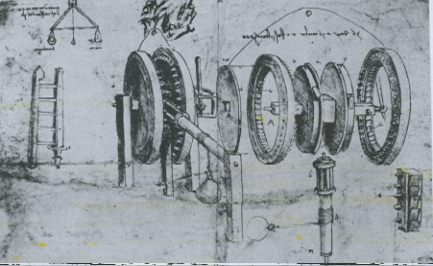
1550
Copper-plate or Intaglio printing begins to dominate printmaking
Intaglio printing cuts the image into a surface (copper plate). The deeper surface area cuts hold the ink. Later zinc plates are used and is popular until 1850's. Source Wikipedia
1543
Nicolas Copernicus uses his calculations to support the idea: the Sun is the center of the solar system with planets orbiting around it.
1540
Biringuaccio publishes Pyrotechnic with 85 wood engravings of mining, smelting, refining, and founding.
1539
Hernando de Soto explores Florida & beyond
See History timeline
1528
Albrecht Durer uses three views to draw human figures
Face from front, side, & top
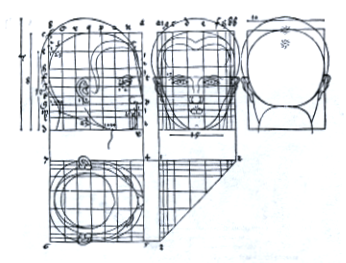
Face turned forty-five degrees
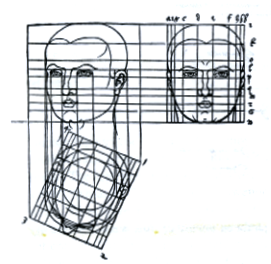
Sketches are like thinking outload. Like Leonardo's notebooks. Instructional like directions on how to construct something, communicating with a drawing to explain something with oral conversation while drawing or adding written comments to a drawing.
Panfilo de Narvaez explores Florida and west.
See history timeline
1524
Giovanni da Verrazano explores the North American coast looking for a westward passage to Asia from North Carolina to Nova Scotia. He concludes the entire East coast is not connected to China and there is no passage.
1519 - 1522
Magellan sails around the world.
- Magellan first went to sea in 1505 on an expedition to India. He couldn't convince the King of Portugal to send him to the spice Islands so he moved to Spain to get permission for a voyage for Charles I of Spain.
- He met Ruy Faleiro, a mapmaker who agrees with Magellan that it would be possible to use his route to sail around the world. When he approaches King Charles and the king asks what he would do if he didn't find a strait, Magellan says he would turn around and go around the Cape of Good Hope. He got his ships.
- Magellan did not confide his plans to any of his officers, which cause him problems the whole voyage. His stubborness and inflated belief in his abilities leads to his death in the Phillipine Islands.
- Pigafetta, a reporter records the incredible trip and writes the book, The First Voyage Round the World.
1519
Horses arrive in America since their extinction
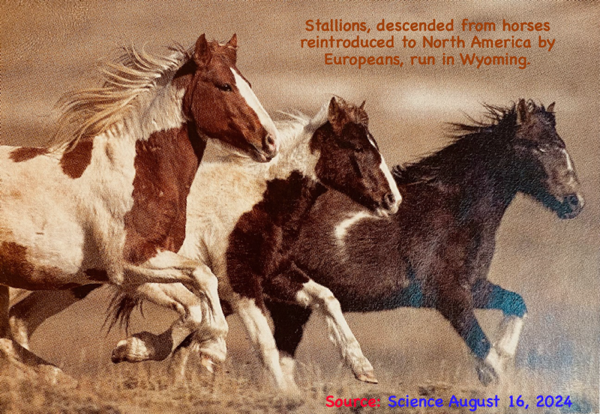
Hernan Cortes reintroduces horses to America after their extinction about 14 000 YA, along with other megafauna saber-toothed tigers, mammoths, camels, by hunting and climate changes.
In 1540 Francisco Vasquez de Coronado has hundreds of horses on his expedition through New Mexico and into Kansas.
In the next 100+ years horses will range across the southwest and north into Nebraska and change where indigenous people live. Arriving most likely with indigenous trade before other Europeans introduce them. This dispersal is efficient enough that around the mid 1650's horses are an integral part of the culture of the Pawnee, Comanche, Lakota Sioux, and others. Source Science March 31, 2023.
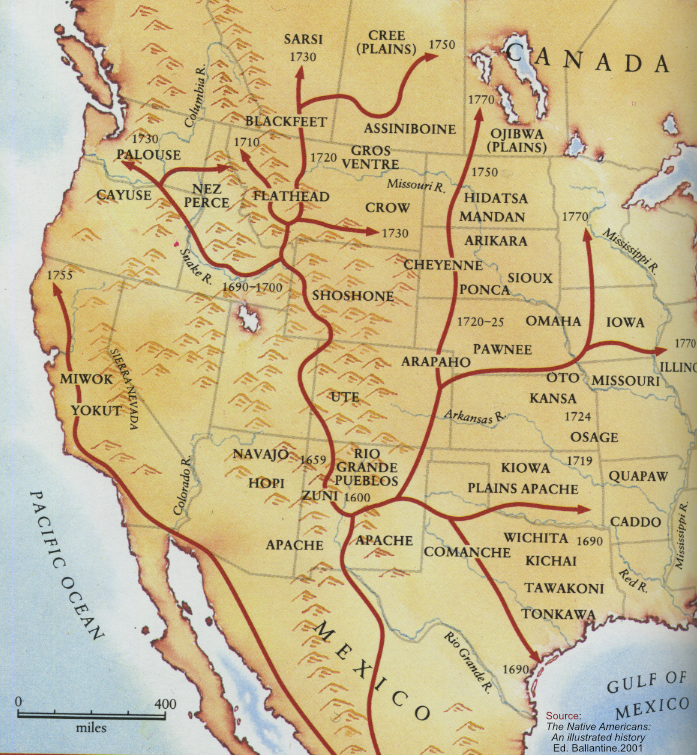
Alonso Alvarez de Pineda explores and maps the shore of the Gulf of Mexico from Florida to Cabo Rojo, Mexico, takes note of the Mississippi, and determines Florida as part of the mainland. He is killed, scalped, and skinned by indigenous people in Texas.
1513
Juan Ponce de Leon reaches Florida
He is recognized and documented as the first European to visit and map Florida. He believes the climate and land are too difficult to live there.
- He had been living in Hispaniola since arriving with Columbus in 1493.
- He is appointed by the King to conquer Puerto Rico.
- In 1513 he sails with 3 ships to Florida. Looking for gold, treasure, and a fountain of youth. He should have known it wasn't there as there are old people in the villages.
- 1521 he goes back to start a colony, is attacked, wounded, retreats to Cuba, and dies of an infection from is wound.
Vasco Nunez de Balboa leaves Spain in 1500 in an expedition led by Rodrigo de Betides, who saw Columbus's charts of 1498, and learned of the Isthmus of Panama, with pearls and gold. They loaded their ships with this treasure and return to Hispaniola where they are ship wrecked on the rocks. They save the treasure, but not the slaves. Balboa didn't want to return to Spain so he became a settler.
After othe unsuccessful and successful adventures, Balboa leads a group across the Isthmus and sees the Pacific Ocean in 1513.
As Spanish leaders of the time go, Balboa is pretty good, but the bad leaders are jealous and worry he will take power from them. Francisco Pizarro arrests him. De Avila accuses him of treason for which he is tried, convicted and beheaded in 1519.
1507
In the late 1400's on the Murano island, (Venice) glassmakers develop cristallo, a transparent colorless plate glass, that is polished, and backed with lead and antimony to make a rough surface with a dim reflection (mirror).
In 1507 Andrea & Domenico d'Angelo del Gallo brother glassmakers on Murano improve the method by applying a mercury-tin amalgamon to the backside of the high quality transparent glass. This revolutionary technique is so valuable the Republic of Venice forbids any glassmaker from leaving the island. Eventually the technique makes its way to France and beyond.
The production of high quality mirrors leads to study and experimentation with light in new ways as well as by artist who can study their own images and create, for the first time, self-portraits.
Martin Waldseemuller draws a map with a continent between Europe and Asia and labels it America. He says, he ended it with a, because he thought that made a good continent name like Africa and Asia.
1506
Contarini–Rosselli map, the first printed world map showing the New World, which includes representations of Cabot's voyages.
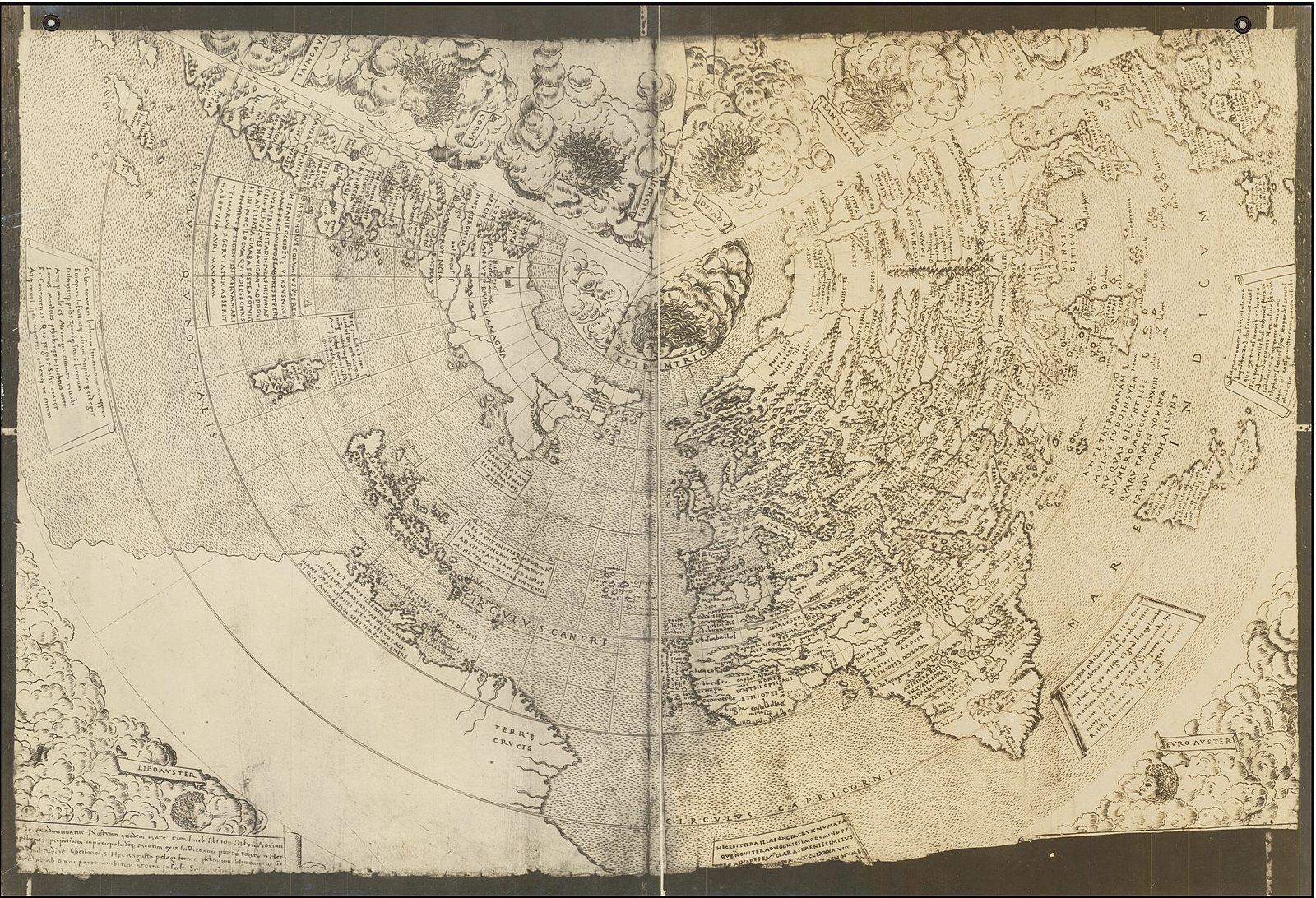
1501
Amerigo Vespucci in leaves on his first of four trips west to explore and map the Caribbean and first arrive at Brazil (1501). In Brazil he finds wonderful plants and animals and lives with the native people to observe their ways. Being interested in maps and navigation, he wants to find a star south of the equator like the North Star so sailors can use it to determine latitude south of the equator. However, he doesn't, but his searches along the coast, leads him to believe its length makes it a continent.
1500
Juan de la Cosa navigator an cartographer
Captain of the Santa Maria on Columbus's first trip, went with him on his second, and explored the north coast of South America in 1499. He uses information from Cabot's explorations along with informationhe knew about Cuba as an island (which he was sworn to secrecy by Columbus not to do, or he would cut out his tongue) to draw the first map of the world with the American continent.
1497
King Manuel the Fortunate outfits four ships for a three year journey and sends Vasco da Gama to follow Diaz's route around the Cape of Good Hope and across the Indian Ocean to India.
He sails and uses the cirular trade winds to make it around the cape and lands on the East coast of Africa where Diaz left a marker, and up the coast to find an Arab pilot to guide him. He is unable to untill he took a hostage of a local Sheik who traded a pilot for the hostage. He lands in India 1498 where he does not have enough quality trade goods to impress their King, so he traded a little and when ready to leave the King told him he had to pay taxes on what he had. Not able to he takes hostages and leaves. Deciding the only way to trade would be to return with enough armed forces to enforce hiw will. Loosing two-thirds of his men, most to scurvy he burnt two ships and returned with two.
He keeps his promise and returns in 1502 with twenty ships, enough power to capture, kill, terrorize, and send the King a message to get rid of the Muslims. He them sailed south and established better relationships, filled his ships with goods and returned to Portugal. 1524 the King of Portugal appointed him Viceroy to get India in order. Three months after his return he dies.
John Cabot can't get funded in Spain so he heads to England and Henry VII, who promises five ships, but is given one and a crew of 18 in 1497. He sails west and locates New Foundland. He doesn't land as he sees inhabitants and has such few men. Henry is excited and provides six ships for a return trip. He left in 1498 and is never heard from again.
Juan de la Cosa was a navigator an cartographer. He was Captain of the Santa Maria on Columbus's first trip, went with him on his second, and explored the north coast of South America, 1499. He used the information from Cabot along with informationhe knew about Cuba as an island (which he was sworn to secrecy by Columbus not to do, or he would cut out his tongue) to draw the first map of the world with the American continent.
1492
Spanish, Christopher Columbus, arrives in Santo Domingo, which is inhabited by Taino Indians. Today, Hispanola Island includes the Republic of Haiti and the Dominican Republic.
His expeditions are best known for mapping the lands where he travels, obsessed with finding gold, and killing indigenous natives.
1487
King John the Perfect, wants spices to trade, but the Turks closed the land routes to the far East in 1453.
In 1487, he sends Bartholomew Diaz to find a route around Africa. Diaz sets sail south with three ships. After sailing south for days he runs into a storm that lasts for 13 days and in which they lose their supply ship. Realizing they were on the east side of Africa Diaz wants to sail east to India, but his sailors have had enough, and he yields to their demands, and returns to Portugal in 1488. The King is not happy.
Diaz wants to set sail again, but the King is busy until 1500 when he puts Pedro Cabral in commmand of 13 ships to head to India.
In route Cabral takes the large loop westw to avoid the cape storms and lands at Brazil. Excited he sends a ship back to Portugal to tell the King. However, ten days later, disaterous storms cause him to loose six ships. One ship commanded by Diaz and three others go down in a storm off the Cape of Good Hope and Diaz is among those lost at sea.
He makes it to India, where he engages in a fierce battle with Muslim's in Calicut. After which he is permitted to establish marginal trade, fill five ships with spices and other goods, and head home with seven ships, two empty, in 1501.
King Manuel told him he could return, but sends Vasco da Gama instead.
1455
Printing with movable type
Johannes Gutenberg, invents the printing press with movable type. It uses small metal prisms (lead) that are precisely cast in large quantities so they can be set into a grid, used, reset, and used again.
He also uses a new press, similar to those used in wine making, new papermaking and bookbinding techniques, and an oil-based printing ink. All improvements to Chinese, Korean printing, and current European printing of stamping letters on a surfaces or woodblock. Source
He just wanted to make money printing Bibles, yet his invention changed the world and became the greatest threat to the Catholic Church.
1441
First use of decimal point
Giovanni Bianchini, a Venetian merchant, uses a decimal point while calculating the positions of planets between 1441 and 1450 in his manuscript, Tabulae primi mobilis. Source
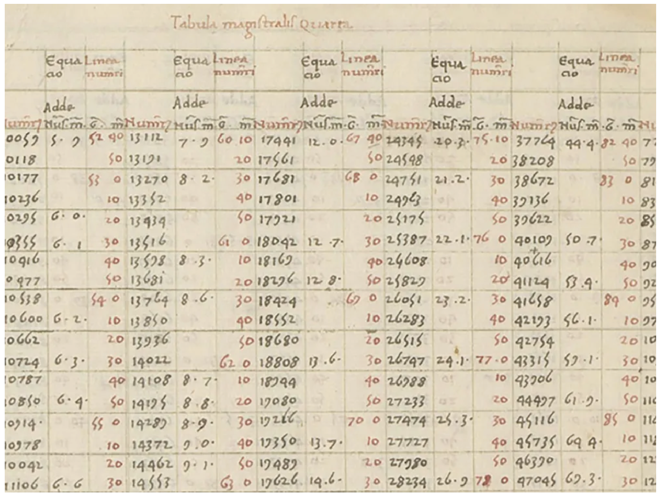
1433
Leon Battista Alberti publishes De Pictura (On Painting)
It is the first theoretical text written about art in Europe and describes the use of perspective in drawing, light and shadow to create bodies that look three-dimensional, and figures in varied poses to create a compelling narrative. Source Khan Academy
Cheng Ho, Chinese navigator, explores lands bordering the China Sea and Indian Ocean as far west as the Persian Gulf and Red Sea with 317 ships, 37,000 men, and with the largest ship being 444 feet long and having 9 masts.
After seven expeditions the new Emperor proclaims China the center of the world with everything they need, so stay home.
1430
Henry the Navigator, prince of Portugal, son of King John I and Philippa (1390-1460).
Begins his career as he and others capture the Moroccan city of Ceuta, a trading hub between Europe and the far East, in 1415. He gains fame and financial rewards from the plunder of spices and other trade goods stored there. This along with his position as Prince enables him to settle in southern Portugal and outfit explores and gain geographical information and open trading centers along the northern coast of Africa and its coastal islands.
While he is noted for organizing systematic exploration along the coast of Africa his development of trade is less successful except for his development of trade in slaves. His importance as a legendary figure of the early stages of European exploration and discovery, is promoted by him himself, Portuguese nationalism, and Eurocentric thinking. Source - Britannica
The high demand and tremendous price for spices and other goods from the far East complicated by the distance, difficult geography, hostile empires, and tribes on the routes encouraged many to explore novel ways to bring goods to Europe.
The importance of his influence and contributions compared to the many other European's who sought to acquire these goods can be questioned.
However, the following events contribute toward increasing trade and happen during his life time.
- The Sagres School is founded in 1419 for skilled navigators, astronomers, mathematicians, and cartographers, to foster a culture of learning and innovation.
- Exploration along the African coast is promoted.
- The astrolabe, quadrant, cross-staff, are developed and compasses are refined and utilized by Portuguese navigators.
- The caravel is created. It has a combination of square and triangular sails, allowing it to sail efficiently both with and against the wind to navigate shallow waters, withstand rough seas, and undertake long-distance voyages.
- Geographic knowledge expands. Numerous expeditions are formed and explore along the African coast significantly increasing European geographic knowledge.
- Introduction and expansion of the African slave trade.
- Encouragement of scientific inquiry through the Sagres School that attracts scholars in geography, mathematics, astronomy, and navigational techniques to conduct studies, experiments, and calculations to advance maritime knowledge.
- Development of a maritime infrastructure for resources and support for Portuguese explorers and traders, along with the construction of shipyards, docks, and warehouses.
- Establishment of trade routes and posts.
- Inspiration of explorers.
First cut-away drawings
Mariano Taccola commpiles a notebook with machines, some drawn with cut-away views to see the internal assemblies. Source Wikipedia
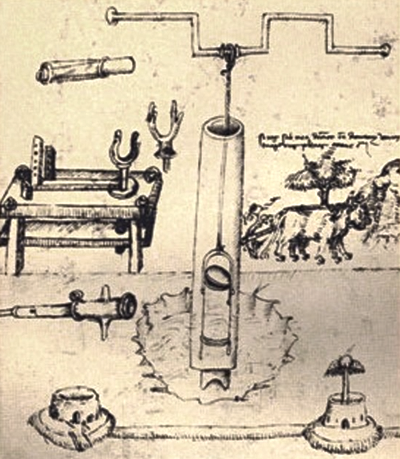
1418
Brunelleschi uses a model to build the great dome (140 feet diameter and over 100 feet in the air) of the Florence cathedral. U.S. capitol dome is 85 feet diameter. Source National Geographic
Brunelleschi's training is as an artisan, how to draw, paint, sculpt. All based on his sensual observations and ability to visualize and construct with his hands. No mathematical use of forces, loads, bearing, to calculate stresses.
1400
First European artifacts are brought to North America via Alaska
Blue glass beads, from Italy, travel west along the Silk Road and across the Bering Strait before being dropped in North Alaska. Twine found with them dates to 1397 - 1488. Source Smithsonian Magazine
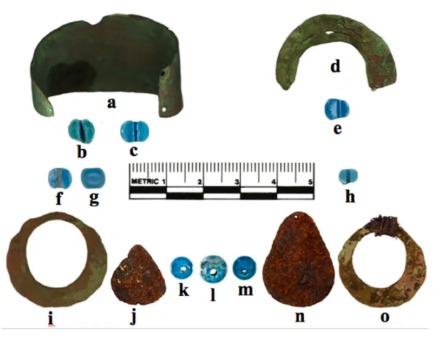
1393
Hugh Herland, Richard III carpenter, uses models to design the 68 foot arched trusses used for Westminster Hall.
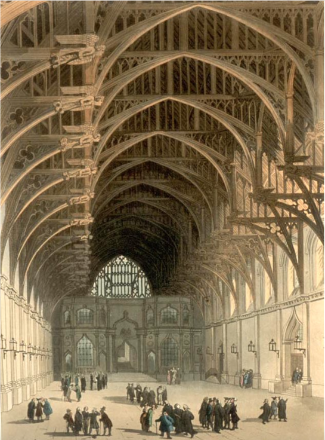
1349
Black Death wipes out half of the Europe population
The Black Death or bubonic plague, is caused by the bacterium Yersinia pestis that is transferred from wild rodents to humans.
1291
Glass making becomes industrialized when the Venetian Republic, thought the 1,000 degree furnaces might be a fire hazard for the cities mostly wooden buildings, To prevent the city from buring down, the glassmakers are ordered to move their foundries to the small nearby island Murano. The move brings many glassmakers together and Murano becomes a hot spot for glassmakers to develop and maintain their craft and art of quality glass making through today. Source
1250
European Little Ice Age spans roughly 1250 to 1860 when the average global temperatures drops by as much as 3.6 degrees Fahrenheit. Possibly caused by volcanic eruptions and reduced solar activity. Source
1230
First pictorial perspective with three-dimensions
Sawmill by Dillard de Honnecourt. Is later redrawn in the book: Theater of Machines in 1578 by Jacques Besson along with 60 engraved plates of instruments and mechanical devices
Notice the difference in the kinds and amounts of information each communicates. Source ecommons.cornel
Saw mill mostly 2-D drawing
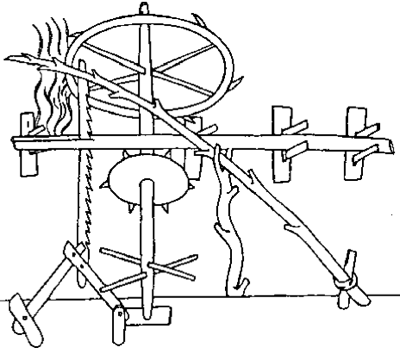
Saw mill 3-D drawing
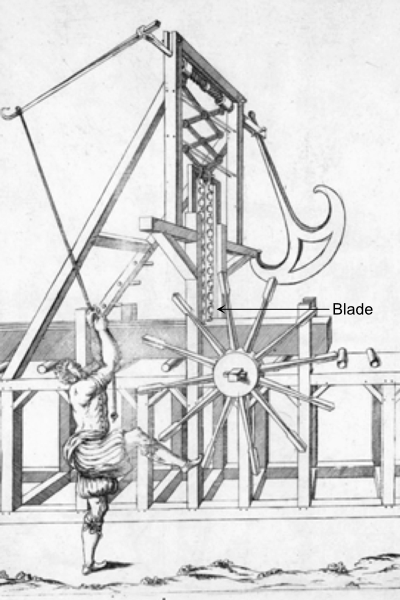
1202
Fractional notation
Leonardo of Pisa (Fibonacci) is the first to use a horizontal fraction bar to write a fraction like three-fourths on three lines.
In 1748 Manuel Antonio Valdes is the first to use a curved line to write a fraction on one line (3 curved line 4) in his book Gazetas de Mexico. In fact, it is the Spanish mathematician Antonio y Oliveres who first uses a straight oblique line like (3/4). This makes it possible to write a fraction on one line instead of three lines.
Source
1134
Infinity
Bhaskaracharya (Bhāskara means the teacher) an Indian mathematician and astronomer who introduces the mathematical concept of infinity with the idea:
If any finite number is divided by zero, the result is infinity.
He writes the Siddhānta Shiromani, which has four sections: arithmetic, algebra, mathematics of the planets and spheres. Also writes the Karna Kautoohala. Source - Books facts
1179
Microscopic contaminants
Hildegard of Birgen is a nun and humanitarian in Germany who teaches and believes microscopic organism contaminate water and food. Long before the invention of the microscope and discover of microbes. She works to find ways to purify water and food.
1040
Magnetic compass
Chinese scholars discover a needle could be heated till red, held in a north south orientation, cooled, then floated in liquid or suspended on a silk thread, and it would point north and south. Therefore, it is valuable for navigation and used by the Song Dynasty, China, for military navigation around 1040 and for maritime navigation around 1111.
Earlier, around 206 BC, magnetic devices are used to divine wisdom in the Han Dynasty. Source Smith College Museum of Ancient Inventions
1030
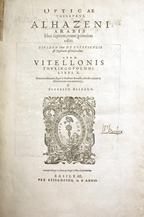
Optics is written between 1028 & 1038
Ibn al-Haytham's most important work: Optics (Kitab al-manazir).
- Described scientific discovery as observation reasoned with induction in a cautious manner to make conclusions without being swayed by opinion. Later influences Roger Bacon
- Combines experiments with mathematical reasoning.
- Includes an accurate model of the eye and vision, laws of reflection, refraction with the relationship between angles of incidence and refraction, and describes motion in mediums with different densities.
See: 1001 Inventions and the World of Ibn Al-Haytham and A Journey of Science from Darkness into Light.
1021
Vikings arrive at L'Anse aux meadows, Newfoundland
They bring bronze and iron artifacts and build a longhouse using fir and juniper.
1000 C.E.
Vast fields for agriculture
Native Americans in Hulburt Creek, Wisconsin build raised ridged garden beds 1-1.5 meters wide, 20-50 meters long, and up to 0.5 m tall and cover acres of fields. The beds extent the growing season, enhance soil fertility, regulate temperature, and maintain moisture. They are used to grow maize, beans, squash, melons, and sunflowers on the planting surfaces atop each mound. The fields will be maintained for six hundred more years. Source Science June 5, 2025.
Mississippi culture begins in North America
Cities are built with mounds in the center and surrounded by defensive barriers.
Cities like Holly Bluff (Lake George), Mississippi and Toltec in Arkansas, and Cahokia (east side of Saint Louis with a population of 10,000 plus with another 20,000 plus in its suburbs), Mississippi, Spiro, Oklahoma, Aztalan, Wisconsin. Also includes Muskogee, Caddo, Crow, Pawnee, and Ho-Chunk.
Large corn fields to feed the large populations along with pigweed, and sunflowers. They forage for other plants, fruit, and nuts and fish and hunt. Their networks of trade provide copper, shells, pearls, stone, mica, and wood. They make jewelry, pipes, textile, pottery, stone, and shell art. Large amounts of art with statues of humans and animals. Two famous pieces are the Piasa a mythical animal painting and the Rattlesnake Disk carved stone. They last till European contact by DeSoto in 1539.
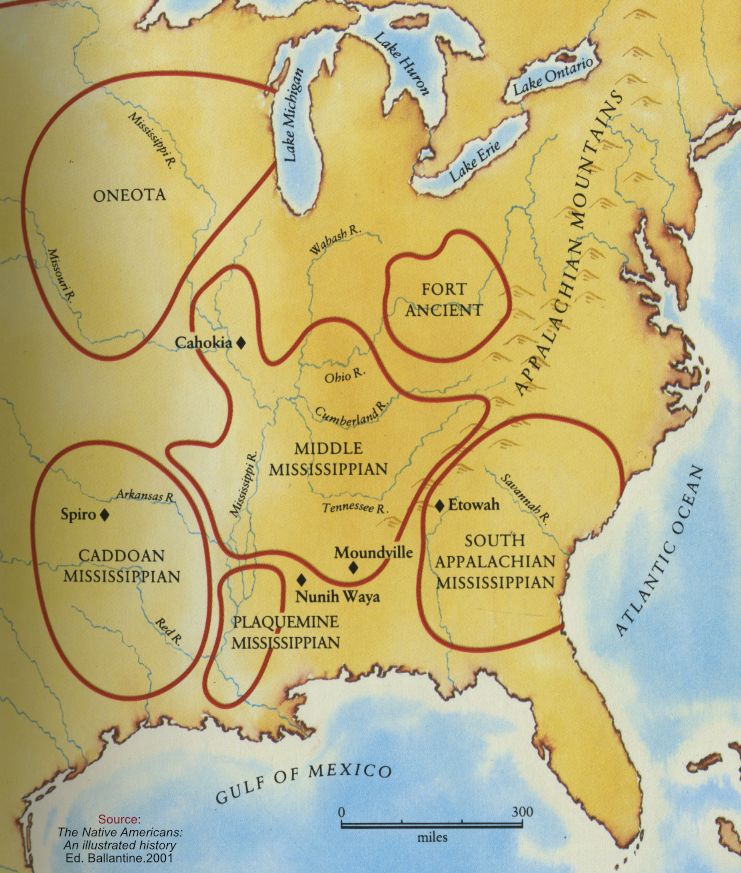
In Canada's Wanuskewin Heritage Park the Indigenous culture create petroglyphs
Some convey the feminine, fertility and renewal with a little tailed spirit figure in the center of a ribstone. It is thought the surface of the rock acts like a curtain or a screen between the physical and supernatural. With the figure's tail going into the crack in the rock to portray a passage from this world to the supernatural world.
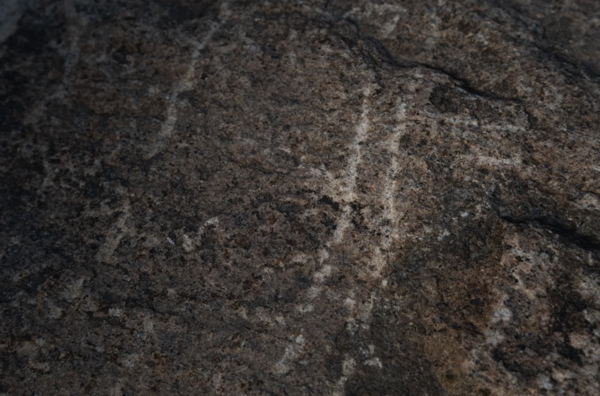
820
Soap making
Workshop, in Israel, makes soap by mixing olive oil with ashes from saltwort plants, heat for seven days, pour into shallow pans, let harden for ten days, slice it into bars, and left it dry for two months. Source Smithsonian Magazine
800 C.E.
Algorithm Muhammad ibn Musa al-Khwarizmi invents algebra in Arabia
His most noted work is: Hisab al-jabr w'al-muqabala. In it he introduces natural numbers, focuses on how to solve equations: linear or quadratic, with units, roots and squares. He explains the solutions with words and uses no symbols of algebraic notation.
In Latin his name is Algorismus, therefore, he is given credit for inventing the algorithm.
Before the algorithm merchants and scholars use the abacus for calculation. The new system, along with a dust board, made computation more accessible. In the Renaissance, in Europe, those who know how to multiply and divide with algorithms are guaranteed a professional career.
- In 1621 the first slide rule is made.
- The first mechanical calculator in 1642 by Pascal and
- The first handheld calculator 1967.
750 C.E.
Stone fortifications are built at the 2100 meters in Uzbekistan and called Tashbulak and Tugunbulak along the Silk Road. Along with a large urban area that is supported by herders and metal and craft workers in an area without fertile farmland and abundant water thought necessary to support urban areas.
600 C.E.
Canals in North America
In the Middle Woodland period among the many waterways and footpaths cross Southeast U.S. are a few canals:
- One in Alabama from Oyster Bay to Little Lagoon,
- Another at Pine Island, in southwest Florida, and
- Another at Mound Key, Florida.
These transportation canals are different from irrigation canals such as those built by the Hokoham culture in Arizona and northern Mexico.
City state and Agriculture: 1 000 C.E. - 10 000 BCE
536
Mysterious fog plunges Europe, the Middle East, & west Asia into darkness for 18 months.
For the sun gave forth its light without brightbness, like the moon, during the whole year.
- Temperatures fall and lower temperatures cause snow in the summer, crop failure, people starve, Irish record wheat failure from 536-539. Later in 541 a plague in Pelusiam, Egypt (known as the Plague of Justinian) kills 33-50% of the eastern Roman empire population, contributing to its collapse.
- Tree ring research in 1990 supports that summers around 540 are unusually cold.
- In 2018 ice from Swiss glaciers suggest a cataclysmic volcano erupts in Iceland in 536 and two more massive eruptions in 540 and 547. It is believed these eruptions cause economic problems that reduce trade and manufacturing until around 640, where ice samples indicate an increase of airborne lead from silver smelting. Source Science 11-16-2018
320
Mouth harp is lost in the Altai Mountains in Russia. It measures about 4.3 inches long and 3.3 inches wide and will still make music in 2018. Source National Geographic
300 - 400
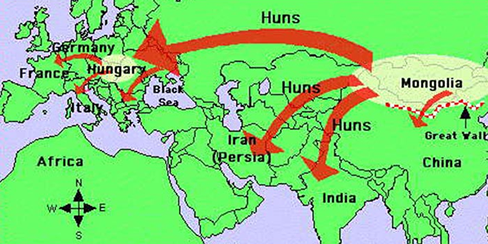
Nomadic tribes of Northern Asia invade China, eastern Asia, and Europe. With their superior horse skills and the stirrup; they destroy villages, the current political structures, and change peoples lives.
150
Ptolemy makes map of the world
Claudius Ptolemy's world map is of the world known to Greco-Roman societies in the 2nd century. It is is published in his book Geography.
He experiments with how to draw a sphere on a flat surface. Many of his calculations are inaccurate. He had the circumference of the Earth at 18,000 miles and the equator about 400 miles too far north. Although he did create a systematic picture of the Earth and identified 8,000 places.
100
Earth' s human population reaches 200 million.
Very cold periods (mini ice age) are occuring between 160 and 180 C.E., and between 245 and 274 C.E. and after 500 C.E. which coincide with high incidences of plague. Food shortages, confinement, unhealthy animals and people, make them more susceptible to illness. Source
Decimal system
The most commonly used positional decimal numeral system for the symbolic representation of numbers is invented by Indian mathematicians. It is known as the
- Base ten number system
- Hindu–Arabic numeral system
- Indo-Arabic numeral system
- Arabic numeral system
- Hindu numeral system
It is invented between the 1st and 4th centuries by Indian mathematicians. The system is adopted by Arabic mathematics by the 9th century. It becomes widely known through the writings of the Persian mathematician Al-Khwārizmī.
79
Mount Vesuvius is active
Mount Vesuvius, near the Bay of Naples in Italy, erupts and buries Pompeii in ash preserving artifacts to be found later to discover how Romans lived during this time. Source History channel
The ancient Roman town of Baia, a fashionable resort for Romans, on the shore of the Gulf of Naples, sinks into the sea, also as a result of Vesuvius volcanic action.
71 C.E.
Plutarch is the first to write a description of the corona during an eclipse March 20, 71 C.E.
Even if the moon, however, does sometimes cover the sun entirely, the eclipse does not have duration or extension; but a kind of light is visible about the rim which keeps the shadow from being profound and absolute.
C.E. (current era) -------------------- BCE (before current era)
37 BCE
Cement - Romans make cement and use it to make concret for water pipes, docks in harbors and more ... Source History channel
50 BCE
First vending machine in recorded history is in Alexandria, Egypt.
It dispenses holy water at Egyptian temples. See 1880's
It is invented by Hero of Alexandriato, a Greek mathematician and engineer.
Hero also writes about mathematics, engineering, physics, and pneumatics. Some topics include:
- The first record of a wind powered machine (a windwheel).
- Steam powered machines.
- Machines that use sound and light.
- Syringes for liquid and air.
- A fountain.
- How to calculate square roots.
- Identifies five powers as: the lever, the wedge, the screw, the pulley, and the winch.
200 BCE
Xiongnu combine their horse technology with military skill and become fierce mounted archers. They roam the Mongolian steppes for hundreds of years and engage civilizations from Iran, Central Asia, and China. Collecting artifacts from these areas as well as Roman glass, Persian textiles, and Greek silver. They are so successful China builds the Great Wall to try to stop their raiding.
Source Archeological evidence supports this as well as DNA evidence that shows multiethnic DNA in their remains from all the empires they raid.
240 BCE
Eratosthenes measures the Earth with shadows, figures out Earth's tilt, & seasons
And becomes known as the father of geography
Eratosthenes, hears of a well in Syene, Egypt that on summer solstice (June 21) the Sun shines on the water at the bottom of the well and casts no shadow on the sides (meaning the sun is directly overhead [zenith]). On the same day, in Alexandria, the Sun is 7 degrees off the zenith (point directly overhead).
He uses observation, logic, and geometry to calculate the Earth's diameter as 12,800 km or about 28,ooo miles around the poles and equator.
He also calculates the tilt of the Earth, at 23.5 degrees, and uses it to explain the seasons.
Math & science activity to measure and calculate Earth's circumference
300 BCE
Hopewell culture ranges from Kansas to New York and Florida to Canada after the Adena.
They trade, art, jewelry, ceramic, and stone figures. Construction uses horizon based astronomy and circle square combinations. Between 400 C.E. - 500 C.E. they stop mound building and their trade network collapses.
Around 450 C.E. the bow and arrow arrives from Canada and corn from the southwest, but probably not a common crop until 700 or 800 CE. They build small farmsteads and villages with a central plaza. Evidence of violent deaths increases and palisades are build around villages. Build effigy mounds in the shapes of animals (birds, panthers, lizards, turtles) for burials till 1 000 C.E. when Mississippi culture begins
Euclid writes his Geometry book, Elements
Euclid lives in Athens, Greece and Alexandria, Egypt. He is known as the Greek mathematician who found geometry. It is said that King Ptolemy I of Egypt told him he wants to learn geometry. Euclid replies, he would have to study long hours and memorize a large book of information. The King demands a shortcut, to which Euclid replies, "There is no royal road to geometry."
Earth rotates once a day
Heraclides Ponticus proposes the Earth rotates on its axis, from west to east, once every 24 hours.
310 BCE
Sun centered solar system
Aristarchus of Samos, built on Herakleides Sun centered theory and describes accurate orbits of Earth and the Sun's other planets encircling it and the orbit of the Moon around the Earth.
This symbolically marks the end of Greek scientific philosophy, because those who come after stick to the myths that claim the Earth at the center of the solar system and universe.
331 BCE
Alexander the Great founds Alexandria, Egypt as a pharaonic town
It is the capital of Egypt, until Muslims conquer Egypt in 641 AD, and move the capital to Fustat, later Cairo.
350 BCE
Babylonians use a trapazoid to predict Jupiter's motion across the sky.
Numbers are inscribed in a clay tablet to calculate the distance Jupiter travels by charting the plantet's motion (velocity) over 60 days. The results form a right-angled trapezoid with a downward slanting top and the area equal to the distance Jupiter travels. See Babylonians Tracked Jupiter with Fancy Math. By Megan Gannon, February 1, 2016: Scientific American.
360 BCE
Aristotle - 380 - 322 BCE
Explanation with rhetoric and logic. While Socrates and Plato use reasoning, Aristotle develops a system of rules and strategies or syllogism.
It is the begining of logical deductive reasoning (as opposed to inductive reasoning). Reasoning in which a conclusion is drawn (validly or not) from propositions (premises) that share an idea not present in the conclusion, for example. Categorical syllogism, uses two premises and a conclusion:
- All humans are vertebrates; no insect is a vertebrate, therefore, no humans are insects.
- All dogs are mammals, all mammals are animals, therefore, all dogs are animals.
Aristotle believes.
- There is a natural order to the world that could be determined with logic without observation.
- Objects would naturally come to rest (without a force acting on them).
- Solid objects would fall to Earth, because that is their natural place to be.
- Believes forces are requird to keep things moving. Had no concept of inertia. See Galileo and Newton.
Aristotle observes.
- Interactions between high and low pressure systems and begins to understand they cause wind and influence its strength and directionality.
Aristotle claims.
- Heredity needs a message and material to explain how traits are passed from parent to children to grandchildren and beyond.
- He recognizes Pythagoras ideas need to be extended to include information being passed from the mother and ancesters from both sides of the parents to the baby.
- He claims there is mutual contributions of information to a baby that passes from the male in the semen and from the female in the blood.
- Claiims the Earth is a sphere, because the shadow of the Earth on the Moon's surface during an eclipse is curved.
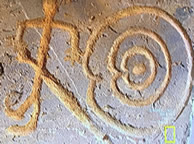 Atlantis
Atlantis
Greek philosopher Plato writes about Atlantis in 360 BCE in his dialogues where he describes it as an island city by the straits of the Pillars of Hercules, today the Straits of Gibraltar. Over the years people have searched for this lost city. Recent research suggests it might have been located near Spain.
Image is symbol for Atlantis.
380 BCE
Petra is an acient city carved into rocks by the Nabataeans in the desert of southern Jordan. See - Nova video (53:05)
Nabataeans create an irrigation system for their city's water needs. To do so they solve several problems for water to be moved over a long distance.
- Discover an optimal shape and size of pipes so sediment wouldn't clog the flow.
- Discover how smoothly pipes need to be set so the flow rate delivers appropriate amounts of water. For example, rapid flow creates ripples and reduces water volume compared to a smooth flow.
- They conclude: shape, size, smoothness, and slope of pipes affect flow (2.5 degree slope works best for an efficient water flow).
- Excavations show how the Nabataeans create their water supply system for their desert city. It includes: an artificial oasis, flood controls, multiple dams, storage in cisterns, and water transported in conduits from sources miles away. Source for detailed descriptions of Petra's Water supply and distribution.

400 BCE
The idea of atoms
Democritus (470 - 370 BCE ) considers all matter is made of atoms, which are small, invisible particles surrounded by space, that can not be subdivided, and last forever. There is an infinite number of them that make up the physical world. They are different in shape, arrangement, position, and magnitude. He also believes space is a void or vacuum that is infinite. Source Wikipedia
Metrodorus explores the idea of alien life
to consider the Earth the only populated world in infinite space is as absurd as to assert that in an entire field sown with millet, only one grain will grow."
Metrodorus is a Greek philosopher who studied and taught in what is modern day Turkey.
Horse technology
A horseshoe is essential to protect the foot of horses if they are to be used productively for agriculture and transportation. They protect the foot from repeated wear and cracking in dirt, mud, and on rock.
Early protection is created with leather or other materials wrapped around the foot and fastened with thongs. Sometimes metal or other materials were inserted inside the boot shaped material. Literature includes early reports of shoes of bronze, silver, and gold being on horses of important leaders.
The development of iron provides a much better material and along with the idea of fastening it to the foot with nails. Since iron is valuable and could be melted and reused, it makes discovery of it in archaeological digs unlikely.
Sculptures of horses with shoes are rare, but a few are known.
Four bronze horseshoes with nail holes were found in an Italian tomb dated around 400 BCE More on domestication of horses.
Consider the pros and cons between horses, mules, and oxens for what is best based on strength, speed, health, food requirements, care, and ...
Thonis-Heracleion, an ancient island city on the mouth of the Nile River
After Carnac, it is the legitimate capital of Egypt where Pharaohs receive the divine rights to rule. It is a major trading port until Alexander the Great conqueres Egypt and builds Alexandria in 331 BCE and makes it the capital.
Later the Nile changes course, the land liquifies, and the city sinks into the Mediterranean Sea. It is lost to history, until archeologist find its ruins in 2000. The find includes many everyday artifacts, temples, statues of gods and pharaohs, a Stele with a record of tax rates for imports and exports, and over 64 ship wrecks. Source The National
415 BCE

Hippocrates is a Greek doctor regarded as the father of medicine. Around 60 medical writings have survived with his name, many probably not written by him.
- First written information about the flu 412 BCE
- Best known for the Hippocratic Oath, which bears his name, but he may not have written, and the high ethical standards it sets.
- Hippocrates believes mental illness is caused by either something wrong with the brain or factors in the environment.
407 BCE
Plato and Socrates 427 - 347 BCE
Develops a philosophy of education - learning happens when the teacher asks key questions. Socratic Method. Source The Republic. Key beliefs and ideas.
Education is based on interests, abilities, and stations in life.
Utopian ideal is to produce philosopher kings or guardians rule to the State.
Built on Greek rhetoric: the art and process of effective public speaking. First taught by the sophists (480 BCE ).
Dialectic reasoning or dialectics (Socratic method, Hindu, Buddhist, Medieval, Hegelian dialectics, Marxist, Talmudic, and Neo-orthodoxy), and modern debate. All involve conversations between two or more people arguing different points of view for the purpose of establishing truth with reasoned argument.
Socrates valued truth as the highest value. Truth discovered through conversation with reason and logic (dialectic reasoning). Logic, not emotion, to discover truth for persuasion and make choices to guide one's life. To Socrates, truth, not art, was the greater good to guide one's life. Therefore, Socrates opposed the sophists and their teaching of rhetoric as art and as emotional oratory requiring neither logic nor proof.
Dialectic method, rhetoric, and debate can have fundamental differences. In theory debate may be considered as unemotional and committed to rational argument. However, in practice debaters can present emotionally charged ideas to suppress rational thought, hoping to persuade others to their point of view. See rhetoric and sophist (480 BCE )
Plato wrote about how all civilizations will fail and includes the destruction of a city he called Atlantis in his Dialogue. Is this Atlantis tale based on history, or is it fiction?
480 BCE
Sophists - 480 - 390 BCE
The first teachers of rhetoric (the art (arte) and process of effective public speaking) in the Greek world are known as Sophists (wise men). They teach by example, skills of civic life and explore a wide range of human experience about Greek culture. Not being Athenians, they often clash culturally and philosophically with Athenians.
Sophists teach: art and thought have the highest value in life.
Therefore, art should be used to make choices and we should seek it out in all things. To them the artistic quality of a speech or oration is its power to motivate, influence, and please people.
Thus, oration is taught as an art form, used to please, motivate, and influence other people through quality speaking.
Likely, the historical basis for Declamations, which are student's interpretations of famous speeches regiven to demonstrate the student's ability to understand and apply the purpose and power of the speech and skill in public speaking. An integral part of a clasic eduction. Samples knowledge AB
Rhetoric is a method or art of speaking or discourse/ conversation to persuade, inform, or motivate an audience. Concepts of rational appeal (logos), emotional appeal, (pathos), and ethical appeal (ethos) are all intentionally used to persuade and convince people of a particular idea or argument.
440 BCE
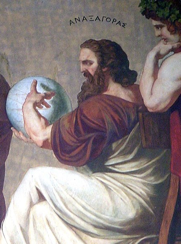
Anaxoragas is a Greek philosopher
- He discovers the cause of eclipses.
- Proposes the sun, moon, and planets are not gods or goddess, but physical bodies.
- Claims the seeds of life (spermata) are distributed everywhere throughout the universe (Panspermia).
- He is banished from Athens for heresy.
500 BCE
Buttress Source Wikipedia
Parmenides, (515-430BCE ) Greek philosopher, is known to use logic with extended arguments for his views, rather than just a view of reality. However, he never systematically studies or forms logical principals, proofs, for valid arguments.
530 BCE
Pythagoras lives in Croton, Greece
- He makes famous a theorem for the area of right triangles.
- Explains similarities between parents and children are caused when semen travels throughout a male body, where it absorbs mystical vapor from all parts of the body to create a blueprint to build a baby so when the semen is transported to the mother it provides a message with instructions for the female who provides the matter to build and nourish the fetus. Which he wrongly thought is the only purpose of a female in reproduction. This became known as spermism. See Aristotle
570 BCE
Thales of Miletus (620 BCE - 46 BCE ) creates theorems (by exhaustion) as logical proof for general geometric ideas. He visits Egypt and observes Egyptians using geometry while building. He is credited for five:
- A circle is bisected by its diameter,
- Angles in a triangle, which are opposite two sides of equal length, are equal
- Opposite angles, formed by intersecting straight lines, are equal.
- An angle inscribed inside a semicircle, is a right angle.
- A triangle can be determined if its base and the two angles adjacent to the base are given.
597 BCE
Early science experiment with control group
Jerusalem is captured by King Nebuchadnezzar II and some citizens of Judea are rounded up and sent to Babylon as hostages. The young are raised and educated in the King's court. Daniel, among them, a devout Jew, did not want to eat non kosher meat and drink wine. Thus, he asks his overseer, Melzar, for a vegetarian diet and water. Melzar, afraid for his life if David doesn't thrive and learn, did not want to grant this request.
David suggests an experiment: for ten days he and nine others are given a vegetarian diet with water (experimental group) and another group of ten are given the King's meat and wine (control group). At the end of ten days, if they weren't healthy he would eat the King's meat. At the end of ten days David's group was fairer and fatter in flesh (Daniel 1:15), than the meat group. Thereafter, Melzar allows their diet.
600 BCE
Circle divided into 360 degrees
King Nebuchadnezzar (605-562 BC), in Babylon, divides a circle into 360 degrees, because his dynasty used observation and calculation to infer a complete year has 360 days.
750 BCE
The Great Dam of Marin on the Wadi Adhanah watershed, near the ancient city of Ma'rib the capital of Saba (a prosperous trading nation, with control of the frankincense and spice routes in Arabia and Abyssinia) is built in the eighth century BCE may be the oldest dam. Source Britannica
1000 BCE
Adena culture east of the Ohio River build year round villages in North America
It's inhabitants make pottery and develop agriculture. Build burial shell mounds, then earth mounds, then no mounds. Hunt, collect nuts, farm, and grow: sunflowers, pumpkins, squash, goosefoot, maygrass, pigweed, and tobacco. Make pipes, loincloth, jewelry, trade for copper (Great Lakes), shells (Gulf of Mexico), mica (North Carolina), and other trade goods. Their pipes travel from Canada to the Gulf Coast. They thrive till Hopewell culture 300 BCE .
Native inhabitants of Wisconsin craft a canoe out of a white oak tree to use for transportation, trade, and commerce. Source Discover magazine
Copper mining
In the Timna,Valley in the Arava Desert, miners extracted copper from green veins of malachite and chalcocite from some 9,000 mines with vertical shafts sunk into the ground, with miners toiling underground chiseling the greenish ore from rich veins on edge of the valley, hauling the ore to the surface, where other workers load it onto donkeys or their own backs and take it to knee-high charcoal burning clay urn furnaces connected to bellows to increase the temperature and push plumes of smoke up from the mining complex. When smelted, the miners smash the furnace and molten slag flows out, with precious lumps of copper. left in the urns.
1450 BCE
First artificial hand?
Bronze and gold artifacts that resemble a movable hand are made. Maybe used for rituals. Source National Geographic
1500 BCE
North America's first city in Poverty Point, Louisiana,
Late Archaic people build, what most archaeologists consider, the continent's first city with 4,000 – 5,000 inhabitants. It has a central plaza, earthen pyramids, concentric platform mounds, and hundreds of houses. They eat clams, oysters, fish, reptiles, pecans, acorns, and walnuts. Had earth ovens, pottery, cooking balls, and fishing nets.
The city is occupied till about 700 BCE .
Water and sewer system
Minoan plumbing, sewer, and storm drainage is well developed and the Minoan civilization flourishes on the Isle of Crete, in the Mediterranean Sea, from 2600 to 1600 BCE . Source The History of Plumbing - Crete - Plumbing supply
First measurement of angles and degrees
Stone tablets in Egypt, are marked with gradients (degrees) to represent the Sun's shadow. Source History of Angle Measurement David A. Wallis
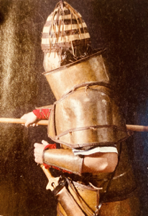 Bronze armor is being forged and crafted in a Mycenaean village of Dendra
Bronze armor is being forged and crafted in a Mycenaean village of Dendra
This armor provides protection to wearers in close combat, safeguarding them against arrows and slingshot projectiles. Its construction is meticulously designed to ensure that wearers maintain their mobility and agility during battles.
Source: Discover Magazine. May/June 2025. Marine Tested, Archaeologist Approved.
1620 BCE
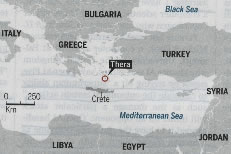 Volcanoes, earthquakes, and tsunamies destroy towns in and around the Mediterranean Sea.
Volcanoes, earthquakes, and tsunamies destroy towns in and around the Mediterranean Sea.
- Pavlopetri - sinks into the Mediterranean Sea from multiple earthquake events. 1700-1500 BCE
- Mycenaean is destroyed by an earthquake
- About 1620 BCE a Volcano on Thera, Wikipedia, an island in the Mediterranean produced and exported saffron trading with Europe, Africa, Asia. The Thera volcano destroyed all civilization on the island with Pyroclastic flows. It causes earthquakes and tsunamies that severely impacted Minoan settlements in the Mediterranean and
- creates tsunamis that destroy Konos on the Island of Crete. The Konos are the origins of the Minoans who influence the Mycenaean civilization from the 15th to the 13th century BCE throughout the Peloponnese in Greece and the Aegean.
1650 BCE
Algebra
The Rhind mathematical papyrus is written by scribe Ahmes (or Ahmose) in Egypt in 1650 BCE and includes algebraic linear equations. Source Wikipedia
Algebra
Babylonians develop a positional number system, linear interpolations, quadratic and cubic equations, flexible algebraic operations to add equals to equals and multiply both sides of an equation by like quantities to eliminate fractions, factors, and other simple forms of factoring, three-term quadratic equations with positive roots, and cubic equations (although it is not known if they were able to reduce the general cubic equation).
Beteen 1900 and 1600 BCE a Babylon uses, what will later be known as Pythagorean triples in applied geometry and calculates the division of a field and records their results in cuneiform on a clay tablet. Source Smithsonian Magazine
1754 BCE
Water regulations
King Hammurabi, writes a code to regulate water usage:
- The distribution of water is based on the acres farmed.
- Requires each farmer to maintain the canals on his property.
- Requires the collective administration of the canal by all users.
1920 BCE
China's Great Flood
China's first Emperor, Yu, is said to have tamed a great flood. Researchers have found evidence of a landslide and flood on the Yellow River around 1920 BCE . Source Finding China's Great Flood New study finds truth in an ancient myth. By Bridget Alex Wednesday, December 21, 2016
2000 BCE
Iron objects are produced at a variety of sites in Niger around 2000 BCE +- 500 years. Source
The Khaybar Oasis wall is built over four years.
It is 9 miles long, 16 feet tall and between 5.6 and 7.9 feet thick, with 180 bastions, or protrusions and encloses more than 2700 acres of land.
The building of the wall demonstrates a beginning shift away from nomadic life and towards permanent settlements in this region by groups who built fortifications to protect agriculturally viable lands. Source
2100 BCE
Corn arrives in western New Mexico and eastern Arizona rock shelters and cooking pits.
2137 BCE
First recorded Solar eclipse
Confucius views and makes the first recording of a solar eclipse.
On the first day of the last month of autumn, the Sun and Moon did not meet harmoniously in Fang. Source Shujing
Dating of this eclipse vary. Most common are:
- 2137 BCE Oct. 22 Based on details and astronomical calculations
- Others previously dated it to 2136 or
- 2128 BCE
2480 - 3 000 BCE
Stonehenge near Amesbury, UK is built. Source
25000 BCE
First bow and arrow in North America is used above the Great Lakes to hunt a variety of game.
251o BCE
Three pyramids known as the Giza pyramids, seen often in pictures and videos, are built.
- Menkaure pyramid in 2510 BCE , at the Giza Necropolis, on the outskirts of Cairo.
- Khafre pyramid in 2570BCE , also at the Giza Necropolis, on the outskirts of Cairo.
- Khafu pyramid in 2580BCE , being the largest and best built at the Giza Necropolis, on the outskirts of Cairo.
- Kush along the Nile River and Nubian Desert is a center of trade (especially: pottery & glazed ceramics, along with ivory, ebony, incense, and other exotic goods from the South), settlements become political centers and conflict between the Egyptians, Kushites, Nubians (Greek name) occure over many centuries with each conquering the other from time to time.
- First African capital city (2400 BCE ) is built in Kerma.
- Nubian structures: deffufa are made of mud bricks as early as 6000 BCE
- Construction of pyramids begins in Nuri around 670 BCE .
- Nuri after El-Kurru no longer has room for burials around 310 BCE when
- King Nastasen 335 - 310 BCE of Kush, moves the capital from Napatan to Meroe 310 BCE .
2650 BCE
First dentist Hesy-Re's tomb had panels that describe him as chief of dentist and doctor. Source
2686 BCE
Egyptians bury dead under six step pyramids built by Djoser south of Giza. Followed by the Bent Pyramid built by King Sneferu in 2613.
King Unis and other royals record texts on the walls within their pyramids at the site of Saqqara .
Part of the text (sh0wn below) is evidences that ancient Egyptians understood the extraterrestrial origin of iron-rich meteorites. Thousands of years before European scientists reached the same conclusion.
[The king] Unis seizes the sky and splits its iron.
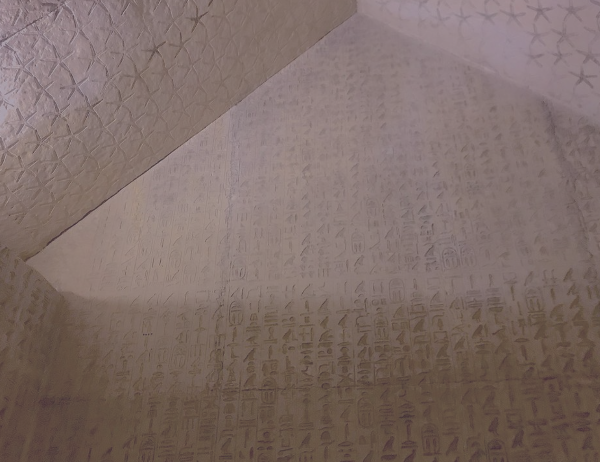
Earlier pyramids?
In Gunung Padang, West Java Indonesian a pyramid is built between 3,000 - 4,000 YA
It appears to be built on a site of another pyramid built between 7,500 - 8,000 YA
Which also may be built on an older pyramid built between 16,000 - 27,000 Y.A
Which would make it the oldest pyramid.
2700 BCE
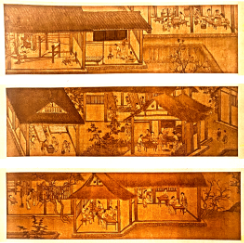
First silk fibers used to weave silk
Chinese lore says. The wife of Yellow Emperor is sipping hot tea beneath a mulberry tree when a cocoon of a silkworm falls into her cup.
The cocoon unravels into strands of silk. Upon seeing them she decides to breed silk worms and weave their silk strands together and make silk fabrics.
Archaeology suggests domestication of the silk worm started between 4,000 and 5,000 years ago. Although silk from wild silk worms may have been woven before then as traces have been found from 8,500 years ago.
Source: Discover Magazine. May/June 2025. Unraveling the Power of Silk. The article also describe how domestication has changed the silk worm and the amazing uses of silk threads in medicine and more.
3000 BCE
Egyptians bury dead under piles of dirt.
3200 BCE
Newgrange stone chamber is built by Irish farmers in Boyne Valley, Ireland
It is an astronomical site built before Stonehenge and Giza Pyramids. A mound 85 meters in diameter and 13.5 meters high over a 1 acre area. A 19 meter stone tunnel, aligns with the rising sun on the Winter Solstice and leads into a chamber with 3 alcoves. It is surrounded by 97 large stones (kerbstones) some engraved with megalithic art.
The face of a Largie Scotland Women who lived around the same time.
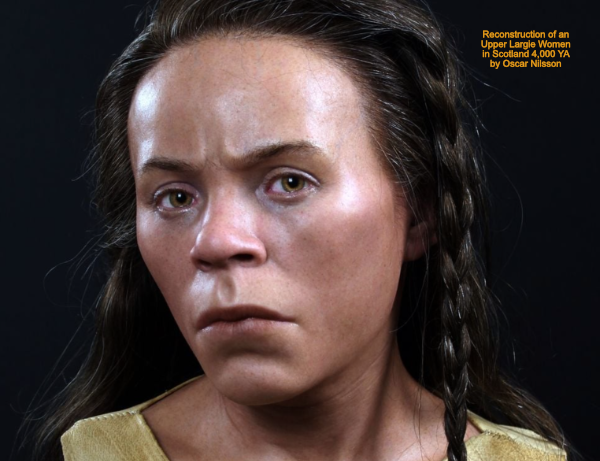
3300 BCE
Cuneiform - writing first appeaars in Uruk later Mesopotamia, in Sumer
The oldest known mathematical problems is written on a cuneiform tablet. It calculates the surface area of a rectangular shaped field.
Bronze (smelted from tin and copper) is made in Sumer
History notes the Bronze age as a historic mile stone. However, different societies learned how to make Bronze at different times:
- Greeks about 3000 BC
- British and Chinese around 1900 BCE - 1700 BCE
- Egypt 1475 BCE
3500 BCE
Domestication of the Cacao tree
Chocolate is made by the Mayo-Chinchipe in Ecuador by grinding cacao beans into a paste and then combine it with combinations of water, corn, fruit, chili peppers, and honey to make a porridge or beverage. About 1850 Europeans add sugar and cocoa butter and later in 1870 the Swiss added milk powder to make milk chocolate.
Yamnaya, domesticate the horse a second time see 3 700 BCE for first ...
3700 BCE
Horse domestication
First signs are on the Kazakh steppe with the Botai, who were mostly hunter gatherers. They create corrals, breed horses, ate their meat, tame them, milk them, put mare's milk in pots to drink, make alcohol from it, ride them, and create bridles with bits.
Bits are designed to apply pressure on a sensitive part of the horse's mouth to control them when riding.
Shortly after 3000 BCE the Botai seem to disappear and have no human genetic desendents, However, the horse's decendants return to the wild and survive today.
Later about 3500 BCE the Yamnaya, whose homeland is between the Black and Caspean Seas, are the second group to domesticate the horse, ride them, and use them to draw carts. They range north to the Arctic Ocean and east to Mongolia. Changes in two genes from earlier horses ZFPM1, relates to control of anxiety and aggression, and GSDMC associated with back pain in humans, may have contributed to their domestication.
The Yamnaya, and their genes, also become a significant contribution to present day Europeans. And their language is the base of all European languages. Proto Indo European. May have also spread Black Plague (bacteria from fleas) to Europe.
They did use the horse to migrate east into Europe. Bringing with them, in their DNA a susceptibility to autoimmune disease, such as MS. Possibly caused by diseases passed to them from being in close proximity to their domesticated animals. As they spread their DNA across Northern Europe, the number of cases of diseases like bubonic plague and leptospirosis rise. Source Ancient DNA ties modern diseases to ancestry. Science January 12, 2024.
Riding horses vastly change human civilization and as humans change the horse genome changes.
See
- When did humans domesticate the horse?
- How Domestication Altered The Horse Genome
- PBS First Horse Warriors
- Science - The Rise of the Rideable Horses
Horses in North America and Europe are extinct at this time. They may have been hunted to extinction; leaving the only surviving horses on the steppes of Eurasia, until they are reintroduced to North America in the early 1500's by the Europeans.
For more on extinction from N. America see 24 000 BP.
Donkeys are domesticated 5,500 BCE.
4000 BCE
First plow
What can be considered a plow, more than a hoe, is made in Egypt and Sumeria. Their use requires hard work to push or pull them through the ground; and they are not able to plow very deep.
- Paintings show several men pulling them and later about 2000 BCE show them connected to oxen horns. Over the years, Egyptians learn better ways to harness oxen, without choking them, to plow better and improve their agricultural yields.
- While the plow makes farming more efficient it requires more strength to plow than hoe. As a result farming becames a more male dominated activity.
- For example, early society in Pakistan, who use a plow, has only 16% of the ag workers being women. In Burundi, where they use hoes, 90% of the ag workers are women.
- John Deere is credited in 1837 to have made the first iron plow.
Irrigation 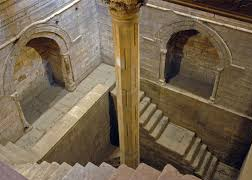
Egypt and Mesopotamia (present day Iraq and Iran) use flood water from the Nile or Tigris/Euphrates river to water crops.
The Egyptians use a verticle column (Nilometer) and a series of stairs to measure the depth of water. Several still exist and can be seen today. Source Image source: Baldiri (Own work) [GFDL or CC-BY-SA-3.0], via Wikimedia Commons
3 000 BCE The first reservoir may have been made by King Menes along with dams and canals to diverted water from the Nile into Lake Moeris. Source
4200 BCE
Cities continually inhabited
While hunters and gatherers stopped and gathered at different places, those places were temporary camps that were revisited from season to season and temporary places for hunting, gathering, trade, social gatherings, and religious ceremonies. Some would be recognized as cities, though not continuously inhabited.
It is interesting people claim to recognize a city, even if it is an ancient city or a city of today. Yet it is more difficult to define what one is in specific terms. Some characteristics of cities: allow for diversification of ideas, continual inhabitation, specialization of labor, social interactions, development of a common culture, language, and experience, more interdependence, creativity, novelty, technology, and a general scaling up until a limit of resources is reached.
Archeologist continue to discover more and earlier settlements and continue to wonder how the domestication of animals and plants and systems to move water and wastes, influence cities and how they become habitable for longer periods of time.
While people settle into larger communities they are not closed. Human historically are mobile seeking trade, ideas, mates, cultural exchanges, and unique experiences.
Some early cities:
- Sosa 4200 BCE
- Faiyum 4000 BCE
- Erbil 4000 BCE
- Kirkuk 1100 BCE
- Balkh 1150 BCE
- Bejing 1045 BCE
Thoughts about cities and sedentary life:
City states appear about 4,000 years after crop domestications, particularly cereal grains. Making it interesting to wonder why no city state develops with domestication of non cereal grain foods, such as: cassava, sago, yam, taro, plantain, bread fruit, or sweet potato.
Possibly because grains are best suited for concentrated production, easy tax because it is easy to count, appropriate, transport, store, ration, and the land is easy to survey to create ownership.
Fixed settlements are a deliberate disturbance of the ecology in which hominids attempt to control the biodiversity and create what they see as desirable resources according to their liking through domestication of animals, plants, and environments which causes a reduction of diversity as a trade off for subsistence as an insurance policy. Things which often can't survive without human attention in a monoculture. Included among this control is other humans' production, education, reproduction, class, and so on. The city state attempts to organize all variables to provide the power to control and protect. Which, often leads to a misconception that early humans desired and couldn't wait to settle down.
Why is population growth large after settling? ...
- Larger spacing between child birth for hunter gathers
- Earlier puberty, more regular ovulation, later menopause for a settled state
- Greater value of children for the labor force in settled state
- Infants can be weaned earlier on soft foods in settled state
- Miracle of compound interest in population growth!
What limitations are there for settled state? ...
- Unsustainable demands on the surrounding environment like deforestation, erosion, natural disasters as well as natural disasters: flood, drought, earthquake, fire, and climate change.
- Malaria is a disease related to civilization as it arose with land clearance for agriculture
- Virtually all the infectious diseases due to microorganisms specifically adapted to Homo sapiens came into existence only in the past 10,000 years.
- Agriculture increased salinity of the soil, exhausted soil, depletion of nutrients (nitrogen
- Citizens forget their collective wisdom learned as hunter - gatherers making them less resilient and easier to control as subjects of a settled state.
- Unlikely the central authority will reduce their revenue demands when the state has a down turn of production and hard times.
- A population is more dependent on a settled governance the more they are contained from resources (surrounded by desert, ocean, and other general lack of resources for example Egypt.
- We often misinterpret collapse which may or may not be confounded by the power of a state government
- Dark Ages should refer more to state knowledge than to a characteristic of the individuals themselves in that period of time.
- Prosperous states are ecologically confined to areas with enough water and rich soils to support a concentration of labor with grain.
Why are there always barbarians outside the gates? ...
People living outside and around the settled state are often called barbarians. It is very likely that where they live is geographically unsuitable for a state population (mountains, grasslands, forest, swamps, deserts, marshlands, salt water). Therefore, they subsist by foraging, herding, hunting, fishing, and collecting marine life, as possible on marginal land. And supplement their living with plunder and trade with any nearby state, Being a barbarian can be a lucrative form of hunting and foraging, making being a barbarian a lucrative form of hunting and foraging. Which is often the limiting factor of growth of the state while enhancing the barbarians existence.
Why trade over self sufficiency? ...
With many states limited to their agricultural economies it is impossible to provide everything a population needs, or desires, within the city. As a consequence there is a direct correlation between the increase of technology, amount of success, or increase in the quality of life and a positive value and ability for external trade. This reliance on products from outside, which can be provided by the barbarians, can create a symbiosis between the state and barbarians. Both who can live better by trading their surplus products as long as there is a balance of power so that one group doesn't gain decide it might be more beneficial to conquer the other.
4400 BCE
Cats (Feline) are domestic, as indicated by DNA, in southwestern Asia then southeast Europe about 6,400 years ago and spread from there.
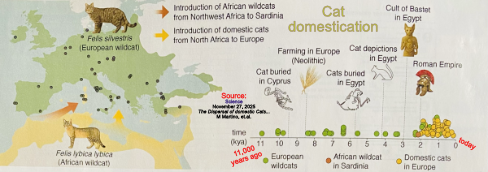
4500 BCE
Board games being played
Board game known as the Royal Game of Ur, a two-player strategy game similar to backgammon, is being played in the Mesopotamian city of Ur.
This game or similar will spread from Mesopotamia to India and east into the eastern Mediterranean by about 4 000 BCE . Evidence of flat stones with a carved grid and cup holes, for pieces, is found in a settlement in the Qumayrah Valley, (Oman).
46oo BCE
Egyptians bury royalty in underground chambers below structures of mud bricks and stones called mastabas.
See more in Egyptian tombs of Saqqara (the ancient Egytptian burial ground)

5000 years BCE
Skulls are measured and their ratios of snout height to skull length and cranium height to skull length distinguished them as dogs. Dogs were bred to be large enough to pull a sled, but not too large to overheat. Source
55oo BCE
Donkey is domesticated in Northeast Africa
Later, maybe a second domestication in the southern Arabian Peninsula around 2 500 BCE
Later Romans breed donkeys to produce mules to transport more goods. Source
5700 - 5100 BCE
Canoes travel the Mediterraniean
Italian villagers, northwest of Rome, make canoes from alder poplar, oak, beech, and lime trees. And travel the Mediterranean. They are very capable carpenters and seafarers who navigated and traded extensively in Foreign grains, animal remains, pottery, paint, tools and figurines.
Source Smithsonian Magazine
6000 BCE (8000 BP - 5000 BP )
Cave art with paint is created in the Americas
On the southern edge of the Americas in a Patagonian cave 130 generations of humans draw and redraw pigment-based cave art. Painting 895 discrete pieces which can be grouped in 446 patterns through out the site. Previously, from 11,652 to 10,204 BP, humans were also in the area and made carvings and other marked the walls with other materials, but not paint. Which following generations created paint from plants heavily stained with red ocher.
The continual use of the cave suggests it is a place that is culturally important for collective hunting, social gatherings, and rituals that help to strengthen social networks and survival by storing information for collective memories to better assure social preservation beyond oral traditions.
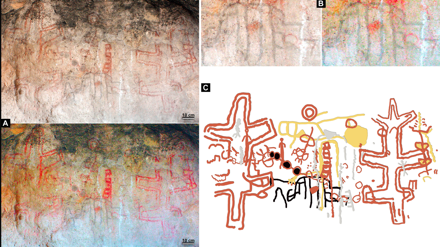
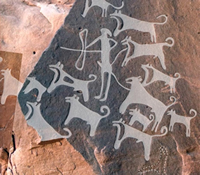 Rock art shows domesticated dogs used to hunt. Dogs on a leash are maybe being trained. Source Science
Rock art shows domesticated dogs used to hunt. Dogs on a leash are maybe being trained. Source Science
Potatoes are domestic in Peru
It is taken to Europe by the Spanish (1500's) and did not become an important food until 1800's during famines.
Catalhoyuk, Turkey citizens live in houses that are built and supplied in a manner that suggest equality of citizens with no apparent leadership. Artifacts also suggest domestication and use of clay appears to have affected the environment in harmful ways: as evidence of deforestation, extensive burning, erosion and evidence of large-scale grazing are also found. Source
Create many figurines that show senior women embodying power among a domestic maternal lineages. Source Science June 26, 2025
Copper is used in Asia
Wooden skis are being made and used in Russia
In 5200 BCE Scandinavians are making wooden skis and ski-like artifacts.
Amnya River hunters and gatherers build a fort in Siberia
Sustained by an abundance of pike, salmonids, elk, and reindeer. Which they hunt with bone and stone tipped spears. They learn to preserve and store their fish and meat in pottery, which they decorate. To secure their provisions they build a fortress on the bluffs with earthened walls several meters high topped with wooden palisades. Inside they build dwellings 2 meters deep, to keep warm in the Siberian winters, connected with trenches.
The fortress supports the idea of hunters and gatherers having settlements long before agriculture becomes dominate.
Dolmen of Menga, Megalith in Spain, is constructed
32 limestone rocks weighing 1140 tons are used to make it. A few pictures of this ancient marvel.
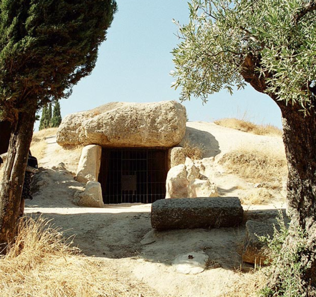
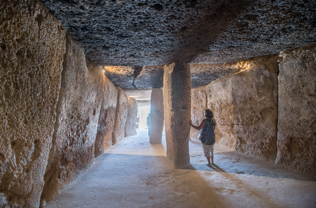
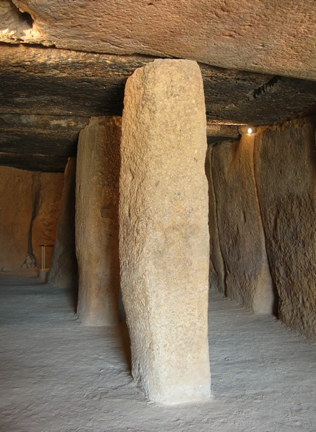
7000 BCE
Kennewick man lives in present day Washington state
His DNA relates to today's Native American tribes of the Coville Reservation as suggested by his skeleton found in Washington. A study of his DNA in 2015 finds it is Haplogroup Q-M3, and his mitochondrial DNA Haplogroup is X2a.
Olmec Domesticate maize (corn) in Mexico
Research suggests different varieties of maize are partially domesticated before being traded or spread from Mexico. These partially domesticated seeds, each with sufficient alleles to independently become modern, did so in different locations in the Americas after their dispersal. Source Did Maize Dispersal Precede Domestication. Science. December 14, 2018
Jericho becomes a city
Motza (Israel) is an 80 acre settlement with workshops, public halls, and private homes linked by roads and alleys with evidence of art and trade. Source Discover. Lots o' Motza Jan/Feb 2020 by Bridget Alex
Ritual circle is built in Peru's Cajamarca Valley
It is constructed with large stones interlocked together and covered with plaster. In a few hundred years another stone circle in Caral, north of Lima, Peru is built.
7500 BCE (9,500 BP or YA )
Carved stones of art
A shrine with two large standing stones is carved with human like figures, along with an altar, and a hearth, beside a campsite with multiple full-size desert kites (a kite is a large trap used to capture and slaughter wild gazelles) in eastern Al-Jafr Basin, Jordan. Source
It remains unclear whether the engravings are used to help plan construction of the kites, held symbolic cultural significance, are used as a map to help position hunters and coordinate capturing animals, or had some other purpose.
Copper mining begins in North America
In North America near the Great Lakes. Metal tools: projectile points, knives, axes, fish hooks, awls, and decorative beads and bracelets. Thousands of artifacts are initially made and since their technology doesn't advance to alloys. The use of copper decreases about 3000 BP or YA and returns to the harder stone and bone tools. Only copper awls, superior to bone awls, remain in use. Source Great Lakes people among first coppersmiths Science March 26, 2021.
Early humans in Michigan
have limited resources, hunt caribou to eat their meat, use their sinews as thread, their hides for clothes and tents, and make weapons or tools out of their antlers and bones.
Europe's first farmers
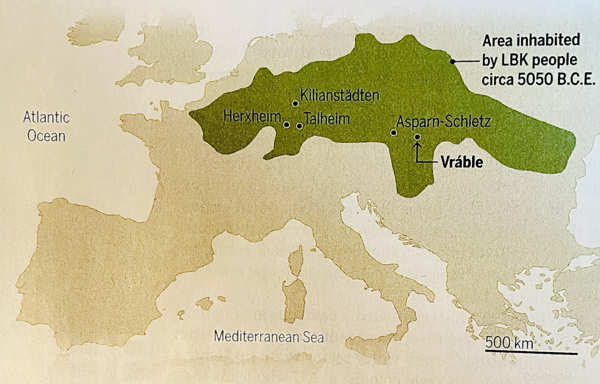
Source - A Headless Mystery: Archaeologists find evidence that a wave of mass brutality accompanied the collapse of the first pan-European culture. November 29, 2025. by Andrew Curry.
8000 BCE or 10,000 BP or YA
The Archaic period in North America
Mammoths, mastodons and bison antiques are extinct.
Native cultures are still hunters, but hunt smaller prey, deer, rabbits, turkeys, geese, and fish. If available, elk and bison. To supplement these, they ate more seeds, nuts, fruits, and fibrous plants. Inventing grinding stones, the mortar and pestle, and technology to leech acorns.
They travel in small groups of 20-30 and hunt with atlatls and spears. The climate warms, water increases, grasslands and forests grow more dense and about 3 000 BP or YA groups tend to stay in one place and diversify. Where possible they live in rock shelters. Other places, they build simple houses in shallow pits and cover them with log frames, domes, or tents.
Hunter gatherers before 8000 BCE or ≈ 10,000 years ago BP or YA
----------------------------- see 1950 -----------------------------
.01 million (10 000) BP or YA (Cenozoic Era, Quaternary Period, Holocene Epoch .01-1.8 mya )
Ice age ends. Measurements of Greenland ice packs show an increase of temperature as measured in the change of hydrogen chemistry.
Melting ice submerges the land between present day United Kingdom and Europe as ocean levels rise by about 120 feet.
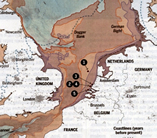
10,000 BP or YA
Evidence that Women participate in big game hunting in the Americas
Randall Haas and his team find numerous projectile points and stone tools buried alongside the skeletal remains of a woman, who was probably a great hunter between 17 and 19 years old. Astonished by the fact that she has a kit of a hunter, they review the published records of 429 burials across the Americas in the late Pleistocene and early Holocene Epoch. The team identifies 27 individuals buried with big-game hunting tools. Eleven are female and fifteen male. Therefore, it suggests the female participation in big-game hunting is very likely and non gender labor practices are likely routine. Source
Agriculture around the world
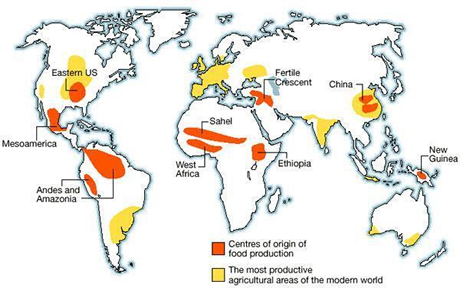
Evidence suggests hunter gatherer societies stumble upon plant and animal domestication only nine places around the world:
- Fertile Crescent,
- China,
- Mesoamerica,
- Andes/Amazonia,
- Eastern United States,
- Sahel,
- Tropical West Africa,
- Ethiopia and
- New Guinea.
History, includes many tales of hunter gatherer societies being driven out, infected, conquered, and exterminated by farming societies where farming is possible. Except the Huns 300-400 and Ghengis Khan 1225.
Hunter gatherers of the Fertile Crescent domesticated wheats, barley, peas, sheep, goats, cows and pigs to become the first farmers and herders, beginning around 8500 BCE . This led to major changes: shorter birth intervals (from four years to one year) political changes (social classes, kings, soldiers, empires, professional armies), and technology (metal tools, writing, ...). These were tools of conquest and allowed them to spread into Europe, North Africa, western India, and central Asia. However, having no other advantages, power shifted to Greece, then Italy, and then to northwest Europe. While human societies in the Fertile Crescent inadvertently committed slow ecological suicide as low rainfall caused deforestation, soil erosion and salinization.
Some advantages and disadvantages of agriculture:
- One calorie seed can grow 50 calories.
- One acre of farmed land can grow 1 000 times what hunting and gathering can provide per acre.
- A 60 lb bushel of wheat can make 70 loaves of bread.
- Early agricultural communities are more malnourished, have more famines, people are shorter, life expectancies decreases by five years, and there are more conflicts and war than hunting gathering tribes.
Source Nature, Jared Diamond
See earlier steps toward agriculture.
West Africa, Niger River Basin is the location of the continent's traditional agricultural crops:
- Yams domesticated in the Niger River Basin betwen eastern Ghana and western Nigeria.
- Pearl millet domesticated north of the Niger River in western Sahara Desert, north Mali and Mauritania.
- African rice domesticated in western Africa in north Mali.
- Sorghum domesticated in East Africa in Egypt.
Source Plant Genomics Unearths Africa's Fertile Crescent. Elizabeth Pennisi. Science, May 3, 2019.
10,400 BP or YA
Sheep are domestic in the Mesopotamian area for: food, clothing and shelter.
Anatolia, Turkey catch small lambs and kids to fatten in their settlements, which lead to the domestication of sheep and goats over time. Domestication provides milk, meat, and wool. 10,400 YA.
The use of wool develops over time as the quality of wool needs to be bred for a more dense fleece, achieved with finer fibers and less kemp. Source Sheep industry fact sheets
10,500 YA
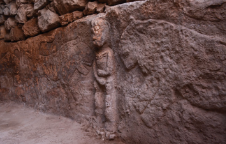 Carvings
Carvings
Neolithic hunter-gatherers carve two wild animals, a sharp-horned bull, and two human figures into stone in Sayburc, southern Turkey.
Is it the region's oldest known example of a story told in art?
Or just portraits?
11,000 BP or YA
First Stone Temple?
A temple at Gobekli Tepe, Turkey is where hunter gatherers congregate to share in spiritual celebrations. The artifacts at the site suggest religion predates agriculture and possible permanent settlements built while while humans were still hunters and gatherers. Artifacts carved on the surfaces represent images of foxes, lions, scorpions, vultures, and T shaped pilars that some believe represent humans. Findings suggest early people had beliefs and those beliefs evolved and centered on human's place in nature.
- Humans as spirits in a spiritual world among animals, weather, and other Earthly spirits.
- Humans with nature.
- Humans as master of nature.
- Humans as servants of nature.
- Three skulls were found with red ochre, grooves, circular holes that seem to be cut at time of death or near death as there is no indication of healing. Could have been suspended by cords for ritual situations. Source
11,500 BP or YA
A woman (Luzia) is living in a Brazilian cave
In 1974 a skull of Luzia Woman is found in a cave at the Lapa Vermelha archeological site in Pedro Leopoldo, in the Greater Belo Horizonte region of Brazil, by archaeologist Annette Laming-Emperaire. Supporting the idea of an earlier arrival of people in the Americas.
An infant is at the Upward Sun River in the Tana River Basin in Alaska. The infant's genetics suggest her ancestors settled Beringia and her descendants headed south into North America. The site is found in 2008. The infant's bones, date to around 11 500 year ago. Science January 5, 2018.
Domestication of grapes
While there is a split in grape species earlier, after glacial episodes 500 000 years ago. A second split happens about 11 500 years ago in Western Asia and north in the Caucasus Mountain area, which is followed by more species variation suggesting domestication and cultivation.
Source Dual domestications and origin of traits in grapevine evolution
12,000 BP or YA
Extinction of Wooly mammoth seems to be the last of the large animals to become extinct. Others include: Columbian mammoth, American mastodon, Beautiful armadillo, Stag moose, Giant beaver, Jefferson's ground sloth, Harlan's ground sloth, Flat-headed peccary, & short-faced bear. Source
Read A Mammoth's Life Story, Written in Tusk in ScienceAdvances January 1, 2024 p 249. How evidence describes the areas two mammoths traveled in their lifetime and how it suggests climate change and humans probably lead to their extinction.
Natufians settle for longer periods of time, northwest of the present-day Palestinian city of Ramallah.
These settlements include camps with stone buildings and caves. They are among human's first move to rely on agriculture and a more sedentary life, and less on a hunter-gatherer life style. Their use of a large number of artifacts include: mortars and pestles, flint sickle-blades, and other more to suggest they stayed at these sites for long periods of time. Source
Folsom culture follows Clovis in North america. They mainly hunt bison using their new invention, bison jumps. Their culture disappears 10 000 BP or YA.
Tobacco harvested
Humans twist together tobacco leaves, stems, to chew or suck on them and discard the seedson the mudflats of the Great Salt Lake Desert in Utah. Source
Rock Paintings are created in Colombia Source
Life-Size Animal Rock Engravings are carved in Saudi Arabia
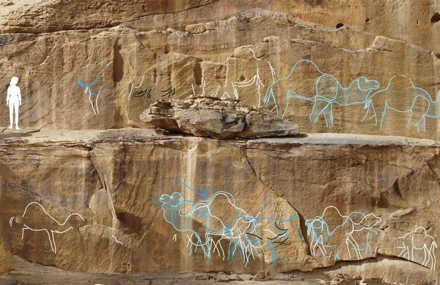
Highlighted engravings at Jebel Misma.
13,000 BP or YA & maybe earlier ...
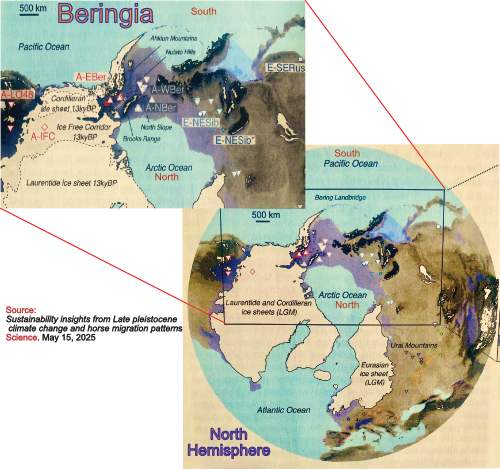
Humans in Americas
- Naia, a teenage girl, explores an underwater cave in the Yucatan Peninsula, Mexico. Her skeleton is found and dates to 13 000 years ago. Her DNA indicates she descends from early Native Americans, who likely crossed the Bering Strait. Her ancestry is Asian, from Beringia, haplogroup D. Source
Learn more about Naia on Nova First Face of America February 7, 2018. - A boy explores in Montana where his skeleton is found in Montana at the Anzick site in 1968. In 2014 his haplogroup is found to be D1, commonly found in South America.
- Arlington Springs Man lives on Channel Islands off the west coast near Santa Barbara, California. Two of his leg bones are found in 1959 and later date to 13,000 BP or YA .
Clovis stone tools are created in the Americas
- Production starts around 13 500 - 12 700 BP or YA and continues until 800 YA.
- Tools have been found in the eastern and central United States, with some of the oldest sites in Texas and northern Mexico.
- Did the Clovis people hunt mammoth or mostly forage for plants, hunt small mammals, and catch fish? Along with Clovis points, scrapers, blades, drills and needles are in their tool kits. Source
- Yellowstone, WY is a source of obsidian (11 000 YA). Obsidian which is mined and distributed across the U. S. Source
Steps toward agriculture
Some humans begin to plant and cultivate plants (farming) rather than a sole reliance on hunting and gathering. The idea farming is superior to hunting and gathering, at this time, is probably inaccurate, since farming requires more work, portrays a lower adult status, and results in worse nutritional conditions, creates poorer sanitation, and more disease. What ever the circumstances, farming causes changes in plants, animals, and human behaviour as they interacted with each other, build cities, and live in them. Source Evolution, consequences and future of plant and animal domestication, by Jared Diamond.
Steps toward agriculture may be caused as the food supply of wild animals is shrinking to an unsustainable point, as 100's of large mammals are hunted to extinction. Source Sapien
Known technology:
- Cooking, grinding, leeching, soaking
- Domestication of wheat, barley, and other seeds with non shattering seed pod or head
- Domestication of goats, sheep, cattle, chicken, and pigs
- Today's chicken DNA traces to rice fields planted by Southeast Asian farmers 3500 YA. Soon they were moved westward, where they are treated as exotic and culturally revered animals and not as a source of food. The domesticated chicken arrives in Mediterranean Europe around 2800 YA and in Africa 1100 & 800 YA.
What is the reason some species are not domesticated?
- Is it too difficulty to domesticate them? or
- Are indigenous people who live where the species are native, are not inclined to domesticate them?
13,200 BP or YA
America's oldest footprints
Ancient American West coast dwellers leave a footprint on Calvert Island, British Columbia and fish hooks on Cedros Island, Mexico. Believed to be America's oldest human footprint. Source. On the Trail of Ancient Mariners by Lizzie Wade
Human's are making stone tools in the Chiquihuite cave in the Astillero Mountains, 9000 feet above sea level. Some 1 900 stone points or tools used for cutting, chopping, scraping, or as weapons with advanced flaking skills. More than 90 percent of the artifacts are greenish or blackish stone. Most material dates between 13 000 and 16 600 years BP or YA. The cave may have been used for 10 000 years. Source
13,800 BP or YA & maybe earlier ...
A village is established off the Central Coast of British Columbia, Canada on the ancestral grounds of the Heiltsuk Nation. The archaeological evidence supports Heiltsuk oral tradition that claims the tribe lives along the coast in a land that didn't freeze during the ice age. Source
14,000 BP or YA
Humans arrive to the Americas by boat
possibly by island hopping down the west coast. Source. On the Trail of Ancient Mariners by Lizzie Wade
Lice arrive with first Americans and their genetics will be used to support the dates of the arrival of humans to the Americas and more. Source
14,300 BP or YA
Humans cook in Paisley Caves, Oregon
Hearths and extinct animal bones are found inside the caves in 1938. Fossilized excrement, (coprolites) are dated to 14 300 BP or YA .
14,400 BP or YA
First Bread
is made by hunter gathers in Jordan on stone hearths, from wild grains and tubers. Source
14,550 BP or YA
In Page-Ladson, Florida bifacial knives are being used on animals that are extinct today. Source
15,000 BP or YA
Possibly they could have been domesticated earlier, maybe 33,000 YA. Do dogs befriend humans? or Humans dogs? Source
Some suggest all domesticated dogs descend from dogs domesticated in Siberia about 23,000 years BP or YA and then divided into four groups with the genetic marker A2b. These groups travel with the humans who domesticate them eventually dividing into four groups. One group to North America about 15,000 years BP or YA . Science January 29, 2020.
There is ongoing debate about the diversity of of dog's DNA before and after domestication. Source: The emergence and diversification of dog morphology. Allowen Evin, et. al. Science. November 13, 2025.
Dog breeding and rock art 8,000 years
16,000 BP or YA
Flake stone blades
Humans at Cooper's Ferry Idaho, North America, use late upper paleolithic flake stone blades similar to those used at this time in northeastern Asia. Suggesting arrival by boat and before Clovis tools (13 000BP or YA ). The blades are not similar to the Clovis tools, which are fluted bifacial stemmed lanceolate points. Source Science August 30, 2019
17,000 BP or YA
Two bison sculptures are created in a 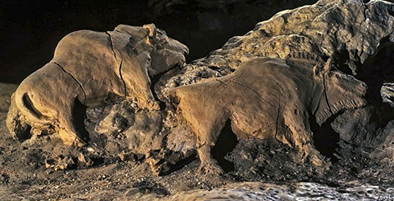 Cave at Tuc d'Audoubert, France
Cave at Tuc d'Audoubert, France
Each sculpture is about 24 x 18 x 4 inches with smooth surfaces that have finger marks from being smoothed when wet, hair carved with a tool, and jaw lines cut with fingernails. Both bison are ready to mate. (15 000 BCE )
The cave also includes numerous paintings, engravings, abstract symbols, one anthropomorphic mask and one image of a female vulva. Source
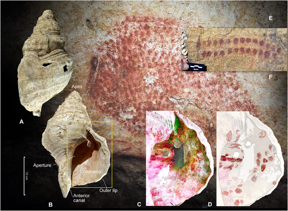
The first musical score & concert
A person may have created a song, scored it on the wall of the cave, to play it in Marsoulas Cave in Magdalenian, France.
Red pigment is placed on a conch shell, which has been crafted to play three notes: C, C-sharp, & D. The pigment on the shell matches red dots and lines on the cave walls that form a bison silhouette. Could it have been a musical score? Was it for entertainment, spiritual requests for a successful hunt, or ...
20,000 BP or YA
Whale bones are fashioned into tools
Narrow projecticles are made from whale bones along the Bay of Biscay near France and Spain. They are likely scavenged from beached whales and selected to hunt reindeer and bison because they are dense and heavy.
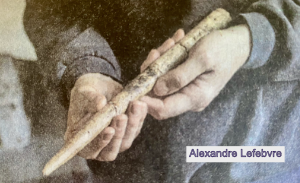
23,000 BP or YA
Ohalo II agricultural site,
on the shore of Galilee, people clear land, sow wheat and barley and harvest them.
Ehud Weiss and his team collect 150 000 specimens of plant remains from the site and date them to 25 000 BCE . The find suggests human migration to North America is along the coast instead of overland.
24,000 BP or YA
Humans are hunting and butchering horses in the Bluefish Caves of northwest Yukon
Smaller than modern horses, these furry animals likely roam in herds across Beringian and will go extinct about 14 000 YA, likley from human hunting and climate change. Source
25,000 - 27,000 BP or YA
Pendants are made from Giant sloth bones. In South America.
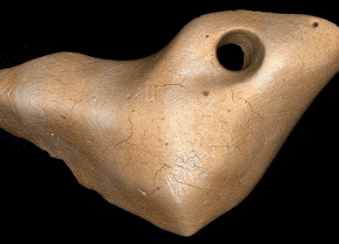
26,000 BP or YA
Solutrean stone tools are made in North East America from 19,000 BCE and 26,000 BCE
These stone tools are similar to Solutrean tools made in Spain, Portugal and southern France. How Solutreans arrive and carry their tools across North America is questionable, however, the tools are there and seem to lead to Clovis tool creation later. See 13,000 years ago.
20,000 - 30,000 YA
Hunter-gatherers travel to and from Asia & North America
Whether by walking a land bridge or traveling by boat, hunter-gatherers ventured out from eastern Eurasia some 20,000 to 30,000 years ago to become the first Americans. But the intercontinental journey wasn't a one-way trip. Several times in history, genetic studies show, Native Americans returned across the Bering Strait to Eurasia—long before Europeans began arriving in distant parts of the Americas.
Source Ancient DNA Charts Native Americans' Journeys to Asia Thousands of Years Ago
Analysis of ten Eurasian individuals, up to 7,500 years old, gives a new picture of movement across continents. by Brian Handwerk January 12, 2023.
31,000 BP or YA
First known surgical amputation
A young hunter-gatherer in Borneo has their lower left leg surgically amputated and survives.
Skeletal evidence shows a youngster's lower left leg is skillfully removed and medical care prevents blood loss and infection, while the community provides care for their convalescence and beyond. Source
24,000 YA - 34,000 YA
Ice age jewely show great diversity 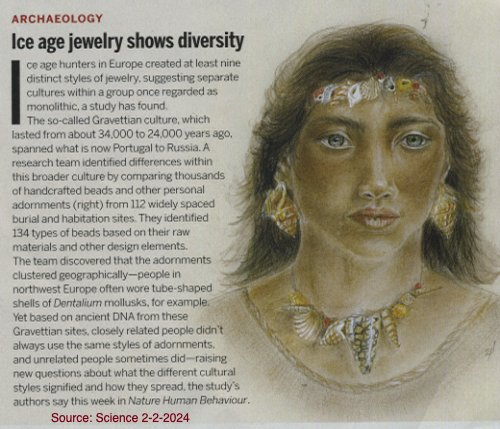
33,000 BP or YA
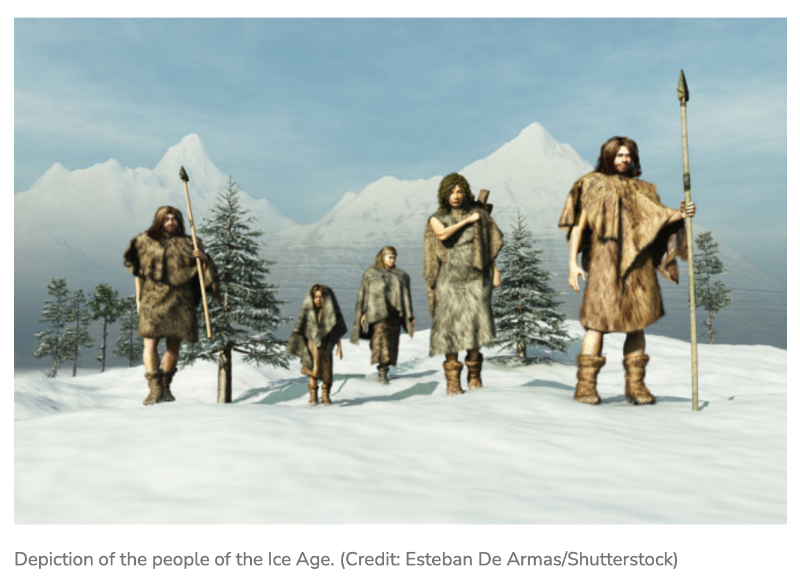
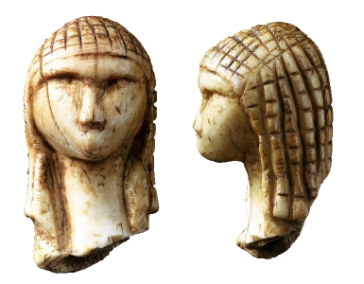 Hunter gatherers (Gravettians) congregate in two geographical areas during the ice ages of Europe
Hunter gatherers (Gravettians) congregate in two geographical areas during the ice ages of Europe
- One group in West and Central Europe who live in cave sites in France, Spain and Britain
- A second group in Central Europe and Russia who live in caves or semi subterranean round dwellings arranged in small villages.
Their tools include stone and bone tools, woven nets, and oil lamps made of stone. Tools to kill larger animals such as mammoths, hyenas, wolves, and reindeer. And nets to capture hares and foxes. They develop burial rites and art with jewelry, cave paintings, and small Venus figurines made from clay or ivory.
34 000 BP or YA
The Vogelherd Horse is carved from mammoth ivory in the Vovelherd cave in Western Europe. Source
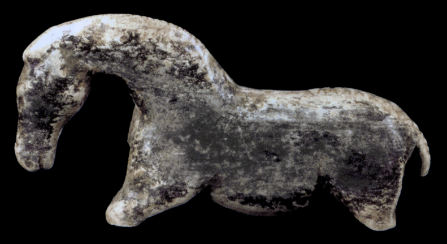
38 000 BP or YA
Beringia, a the land bridge connects Siberia to Alaska during the last Glacial Maximum
Sea levels are around 400 feet lower than today.
Humans cross it before it sinks into the ocean. See animated map.
- First group about 38 000 BP or YA
- A second group enters 16 500 BP or YA , mix with the local populations and quickly migrate south, all the way to South America.
- A third group possibly enter Beringia 15 000 BP or YA .
40 800 BP or YA
Cave art is created in the European El Castillo cave
The art indicates Homo Sapien & Neanderthals are both capable of artistic self expression. Source Discover Magazine January / February 2013
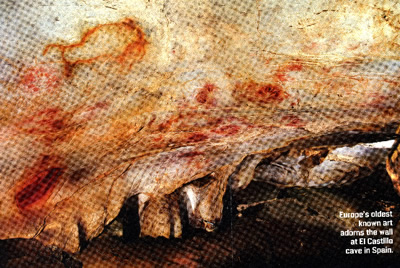
Other old drawings were found on the island of Sulawesi, in Indonesia. at least 35,400 years old. Source
42 000 BP or YA
Mungo man lives in the dunes of the long gone lake, Lake Mungo in Australia, as indicated by a skeleton found and dated to 42 000 years ago.
43 000 BP or YA
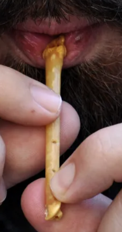
Flute, may be the oldest known musical instrument.
Early flutes are created from a bird bone and mammoth ivory.
One is left in a cave in southern Germany 43 ooo YA.
The image, on the right, shows a man playing a bird bone flute.
At least five individuals are in the Bacho Kiro Cave, Bulgaria between 43 000 YA to 46,000 YA along with their stone tools, cave bear pendants, bone tools, and other artifacts belonging to these modern humans and Neanderthals.
Homo sapiens (humans) and are living in a cave in Ranis, Germany. Overlapping with Neanderthals in the same area. Source
44 000 BP or YA
Indonesian cave painting (44 000 BP or YA )
In an Indonesian cave an artist paints a scene of hunters coraling wild hogs and dwarf buffalo with ropes & spears. Perhaps inspired by spiritual visions, the artist sketches a dynamic scene or story featuring, animal-headed hunters armed with spears cornering formidable wild hogs and small buffaloes.
Cave art (45 000 BP or YA )
Someone paints a pig on a cave wall in Indonesia
50 000 BP or YA
World's oldest needle
A needle 7 centimeters (2 3/4 inch) long with a hole to insert a thread for sewing is in use where it is found in 2016 at the Denisovans Cave where Denisovans live. Source
The needle is an important techn0logical advancement to enable humans to make clothing by joining animal hides with sinew and make strong, weather tight, and water proof seams.
Humans would not be able to migrate through and live in cold regions on Earth without it.
Neanderthals make complex tools
- Neanderthals use birch sap and a complex process to manufacture a tar to cover tool grips or handles. 50,000 BP
- Neanderthals mixed, ocher and bitumen to create glue to probably use to attach stones to other objects, like wooden handles, to make stone tools. They experimented mixing different amounts of the two substances and found a right combination that would best adhere as a tool, a 55 percent ocher to a 45 percent liquid bitumen. 40,000 BP - 120,000 BP Source
- String is made and left in a French cave by harvesting the inner fibrous part of pine bark in late spring or early summer when stripping is easier, soaking it in water for a week or two and twisting the fiber together clockwise, folding them in half and spinning them counterclockwise to make a three-ply cord. Source Discover July/August 2024.
- More than 70 elephants of an extinct species, larger than the modern African elephant, are butchered over a 300 year span in Germany. Suggesting cooperation and education to pass along knowledge. Source Discover July/August 2024.
- Also found in a Denisovan Cave in the Altai Mountains of Siberia are ornaments from bone, teeth, mammoth ivory, and ostrich shell deposits from 43,000 - 49 000 years ago. Science February 2019
All suggest Neanderthals have a social network and education to pass along information.
54 800 BP or YA
Bow & arrows in Europe
Homo sapiens are living in a cave in the Rhône Valley, France (Mandarin) are likely using archery to hunt horses, bison or deer.
Previously Neanderthals inhabit the cave and reclaim it for 12, 000 more years.
Source Science Advances
64,800 BP or YA
Neanderthals create art in three caves in Iberia, Spain
It dates to 64 800 years ago. The date implies the art has a Neanderthal origin, since humans did not arrive until thousands of years later. Source Science. U-Th dating of carbobate crusts reveals Neanderthal origin of Iberian cave art 2-22-2018
65,000 BP or YA
Humans arrived in Australia
They create stone tools, ground ochre, slabs of ochre, and ochre in crayon form. These artifacts are found at Madjebdebe, Australia and date to 65 000 years ago. Source A find in Australia hints at very early human exit from Africa
80,000 YA
Neanderthals as social beings
600 footprints are made by a group of 10 teens and children at La Rozel Beach at Normandy along side campfires, stone tools, and animal bones.
The pattern suggests Neanderthals are social and live in communities. The use birch tars to make glue by extracting it with heat and low oxygen by rolling its bark and burying it below a campfire. Again suggesting Neanderthals have a social network and education to pass along information.
Source Discover July/August 2024.
50,000 - 700,000 BP or YA
Homo floresiensis (hobbit) is alive as indicated by fossils:
- fossils dating 50,000 years ago found in Liang Bua cave in Indonesia.
- fossils dating to 70, 000 years old found at Mata Menge.
100 000 BP or YA
Homo sapien & Neanderthal roam the Earth
- Homo sapiens live in caves of Qafzeh, east of Nazareth, Israel. Bones are classified as Homo sapien and date to 92,000 YA.
- Remains are found at Skhul, on Mount Carmel, Israel and labeled as Homo sapiens Skhul and date to 115,000 YA. These remains indicate lanky slender bodies adapted to hot moist climates and unsuitable for a cooler ice age that arrives around 75,000 YA, which may have resulted in their extinction.
- Evidence also suggests Neanderthal, who are built more stocky, are better able to retain heat and survive through ice ages.
- While none of these suggest they met during this time in this area of the world, it does suggest their existence overlap. Source When Neanderthals Replaced Us by Theodora Sutcliffe.
- Comparison of ancient and modern genomes suggest Neanderthal DNA found in today's genomes originated from 47,000 - 41,000 YA. The DNA in the study also suggests this was the only time period of mixing. Source When Neanderthals met moderns. Science May 24, 2024.
Blombos Cave South Africa is a red ochre factory
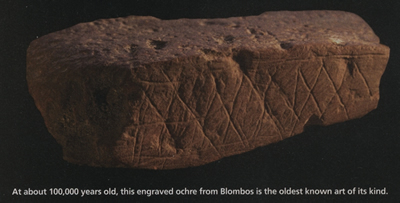
Artifacts incude: grindstones, pebbles dipped in ochre used as a stamp, abalone shells used as containers to mix ochre with bone, charcoal, quartz, and other materials to make paint. And these artifact may be the earliest pieces of art. Ochre is used as a cosmetic, sunscreen, mosquito repellent, medicine, antiseptic, and tanning and preserving hides.
Campfires are lit in a South African cave. Source
As groups can gather around the campfire they become a central hub of human life. They expand opportunities for community unity, stronger relationships, and organized labor to enable society.
120 000 BP or YA
Homo sapiens are making clothes in a Moroccan cave at the onset of an ice age
Tools are being crafted to shape and scrape hides hides to clean leather, and scrape pelts to make furs. Similar tools are still used today to process hides and fur, and have also been found in more recent archaeological sites. Source
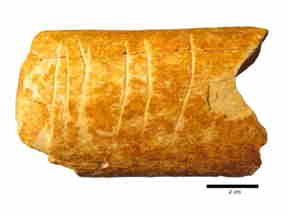
Engraving bone
An auroch bone fragment is engraved with six lines at a site in Israel.
Is it art, communication, or doodling? Source
115,000 to 130,000 YA
A Neanderthal uses a four inch long radial bone, from a juvenile bear's left foreleg, and etches 17 markings and leaves it in the Dziadowa Skała Cave in the Carpathian Mountains in southern Poland. Source
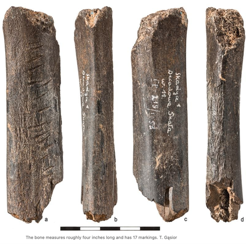
129,000 - 116,000 BP or YA
Average temperature is two degrees C above preindustrial levels
Sea levels rise 20-30 feet as a result of global tempertures, causes changes in Earth's orbit and spin, and melts Antarctic ice.
220,000 - 146,000 YA
Neanderthals social
Neanderthals live in Cova Negra Spain and care for a child with Down syndrome. Indicating collaboration to provide continuous care beyond infancy for the sick, injured, and aged.
Later 80,000 YA
170 000 BP or YA
Pre humans engineer smoke flow
In Lazaret Cave in southeast France Homo heidelbergensis, or pre-Neanderthals, position their hearths in the center of the cave, which is an ideal spot. The location limits the amount of smoke that fills their cave dwelling so the amount of smoke inhaled is minimal and maximizes the room for social activities, cooking and making tools.
This demonstrates their ingenuity, experience, spatial planning, and planned action.
180 000 BP or YA
Earliest homo sapien outside Africa?
Misliya-1, Homo sapien at Misliya Cave, at Mount Carmel, Israel. An upper jawbone with teeth is found and dated to 180,000 BP or YA . Source
While all of the anatomical details in Misliya-1 are fully consistent with modern humans, some features are also found in Neanderthals and other human groups ... ‚
193 000 - 300,000 BP or YA
Out ancestors were hunters before they were even humans. Pursuing prey has shaped our bodies, brains, and culture.
Neanderthals & Denisovans occupy Denisovan Cave in the Altai Mountains of Siberia on and off from 300,000 YA until 97,000 YA. Science May 2017
- Denisovans arrive at the cave 300,000 YA and later live in a cave on the Tibetan Plateau.
- Later Neanderthals arrive and both live here on and off over the years.
- They diverged from a common ancestor 400,000 YA while Neanderthals occupy Europe and Denisovans in Asia where they evolve 300,000 genetic differences.
- While they remain separate they did mix as they met in-between.
- One female is born 50,000 YA from a Neanderthal mother and Denisovan father.
Science July 2024
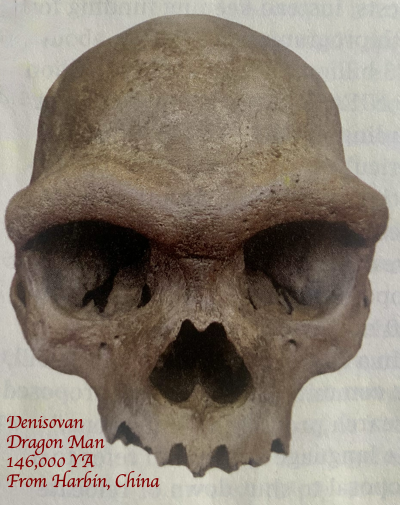
Originally named - Dragon man
lived 146,000 YA in Harbin, China
Source Science June 19, 2025
- The complete set of proteins within the skull contained 122 amino acid variants unique to hominids, and three unique to the Denisovans found in the Denisova Cave.
200 000 BP or YA
Homo sapiens evolve in Africa about 200,000 BP or YA .
Genetic similarities between Eurasians, Oceanians, and Americans indicate all non-African humans descend from a small population that left Africa about 60,000 BP or YA .
Before that Homo Erectus dispersal from Africa ebbs and flows with the ice ages until an extreem ice age about 200 000 BP or YA confined it to the Kalahari Desert where human kind nearly went extinct. After which its dispersal begins again to ebb and flow along with migrations of homo sapiens out of sub-Saharan Africa. Significant dates include: 50 000 – 45 000 BP or YA and
120 000 – 110 000 BP or YA .
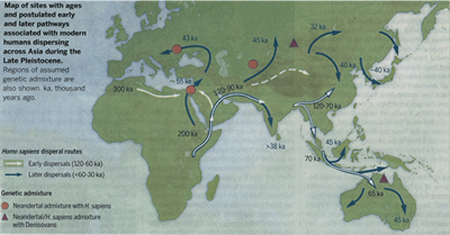
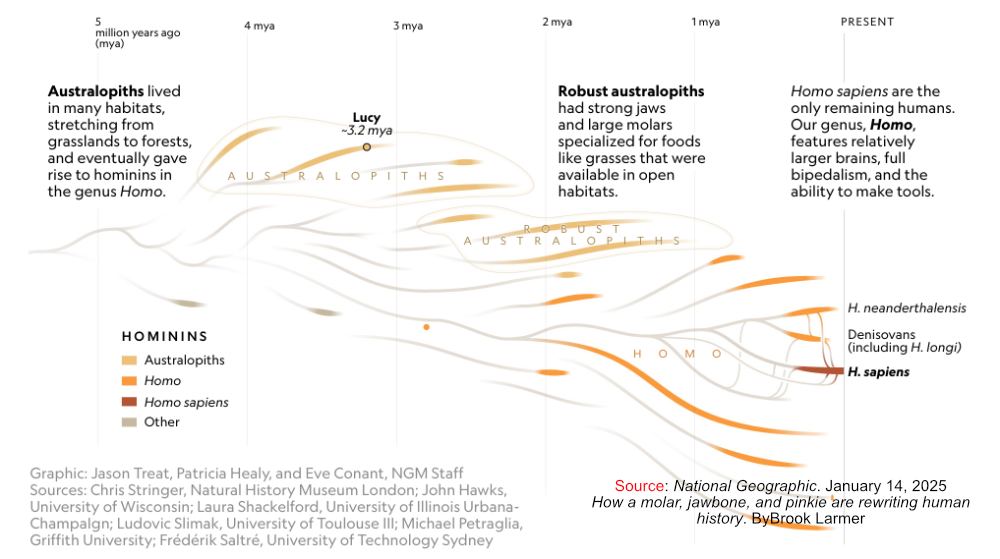
Human lineage summary map.
Source National Geographic
287 000 BP or YA
Denisovans move into the Denisova Cave, Russia
They occupy it off and on from 287 000 to 50 000 BP or YA.
Denisovan artifacts, charcoal, DNA and one bone are discovered. DNA from the bone is found to be a young women whose mother is Neanderthal and father Denisovan. Science February 2019
A lower jaw bone is found on the Tibetan Plateau, dated to 160 000 BP or YA and proteins identify it as Denisovan. Science May 3, 2019.
DNA for later populations 100 000, 60 000, & 45 000 is also found. Science October 30, 2020
300 000 BP or YA
Wooden tools are being made in sothwest China
These wooden tools were made to dig, harvest, and process plants. Suggests our ancient ancestors are eating a more plant oriented diet than meat as is often thought when thinging of them as nomadic hunters. Maybe more Gatherers than hunters.
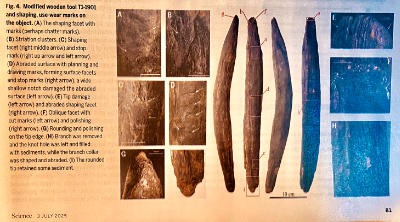
3000,000 year old tools
Source 300,000-year-old wooden tools fro Gantangqing, southwest China. Science. Jian-Hui Liu et. al. July 3, 2025.
Homo sapiens use middle stone age tools (MSA) at Jebel Irhoud, Morocco. Science June 9, 2017
307 000 BP or YA
Pieces of ochre with marks of human alteration and obsidian from about 60 miles away are left at Olorgesailie, Kenya. Indicates humans range further than previously thought and possibly trade with others. Pigment of Our Imagination: The story of human evolution is written in ochre. by Gemma Tarlach Discover April 2018. See also Blombos Cave.
476 00 BP or YA
Pre Homo sapiens construct a wooden structure with interlocking notched logs along the Kalambo River in Zambia. Source Smithsonian Magazine
540 000 BP or YA
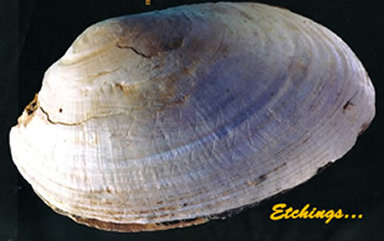
A Shell with zig-zag etchings is left at a site on the Solo River in Java
It is found by Eugene Dubois along with bones classified as Homo-erectus, Trinil 2 sart.
Is the shell art, doodles, or a means for communicating? Jonathon Keats: in Discover July 2015 also Smithsonian article
780 000 BP or YA
Magnetic poles flip orientation. Source The Spinning Magnet by Alanna Mitchell
900 000 BP or YA
Homo erectus makes big Acheulean hand axes, scrapers, and butchers meat at Olorgesailie, Kenya
A prehistoric site where artifacts are found dating from 1.2 million BP or YA - 499 000 BP or YA and a skull cap to about 900 000 BP or YA .
1.0 million BP or YA
Sapien related clades
- The longi clade originates about 1.2 Ma, slightly older than the Yunxian fossils.
- Sapiens clade originates about 1.02 Ma, also close to the age of Yunxian.
- Divergence between the longi and sapiens clades occurres at about 1.32 Ma.
- The Neanderthal monophyletic clade, often considered a sister to H. sapiens, diverges from the longi and sapiens clades about 1.38 Ma.
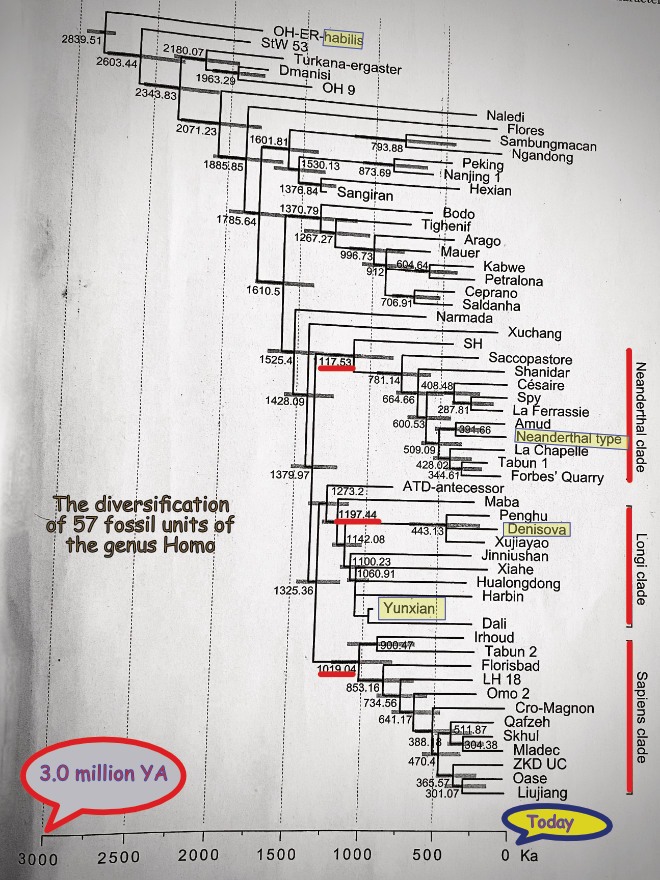
1.4 million BP or YA
Homo Erectus is making stone tools from volcanic rock in western Ukraine.
1.1 million BP or YA
Homo erectus is inhabiting caves in Europe.
Midface remains are found along with thousands of animal fossils. Among them are small mammal bones with cutmarks made with stone tools.
Source Science March 14. 2025.
1.6 million BP or YA
Homo ergaster is walking and running in Africa
The first hominid with long striding legs. Capable of long sustained walking and running.
1.8 million BP or YA (Cenozoic Era, Quaternary Period, Pleistocene Epoch .01-1.8 mya )
1.8 million BP or YA
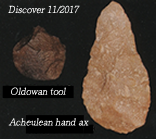
Homo Erectus is a territorial savannah predator able to use tools, run long distances, and is social. It's dispersal from the savannah ebbs and flows with the ice ages until an ice age about 200 000 years before present confined it to the Kalahari Desert where humankind nearly went extinct.
Homo erectus intentionally forms stone tools into teardrop shapes such as the Acheulean hand axes. Creation of these tools requires sensory motor control, memory, visualizing an object within an object, hence, planning. Source
Hippo bone hand axe (right) is discovered in Ethiopia and dates to 1.4 - one million BP or YA , which is likely made by Homo erectus. Source
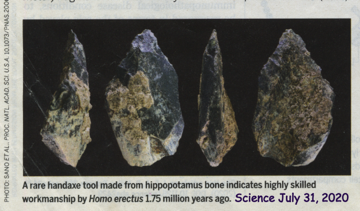
First humans, mammoths, mastodons, saber-toothed cats
1.9 million BP or YA
Australopithecus (southern ape) sediba lives in South Africa
An adult female and young are in a cavern near Johannesburg. Their specimens are found by a 9 year old in 2008. Australopithecus sediba's hands and feet suggest it has grasping ablities to climb trees and the ability to make tools. The remains suggest a direct link to Homo habilis. Source
- Homo erectus living in Drimolen, South Africa.
- Paranthropus robustus living in Swartkrans, South Africa.
- Autralopithecus living in South Africa.
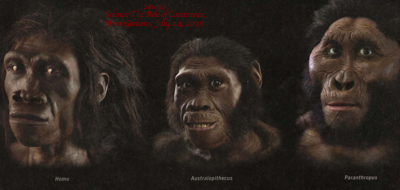
2 million BP or YA
Homo erectus uses fire to cook meat. Many years before Homo Sapien appears.
2.6 million BP or YA (Cenozoic Era, Miocene Epoch 24 - 1.8 mya)
It appears humans begin to eat meat and use weapons, around this time period as stone tools are found at Gona, Ethiopia and date to 2.6 million BP or YA.
These tools match tools known as the Oldowan, named after Olduvai Gorge, Tanzania, where Louis Leakey found similar tools in the 1930's. Those tools are so well knapped that they are believed to have evolved from a less technological tool-making culture.
A strong similarity between marks these tools make and the marks on fossil zebra bones, indicate these stone tools or ones similar were used to butcher animals by at least 2.6 million BP or YA. Humans and food source
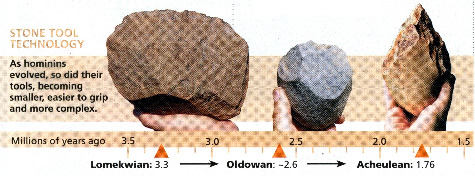
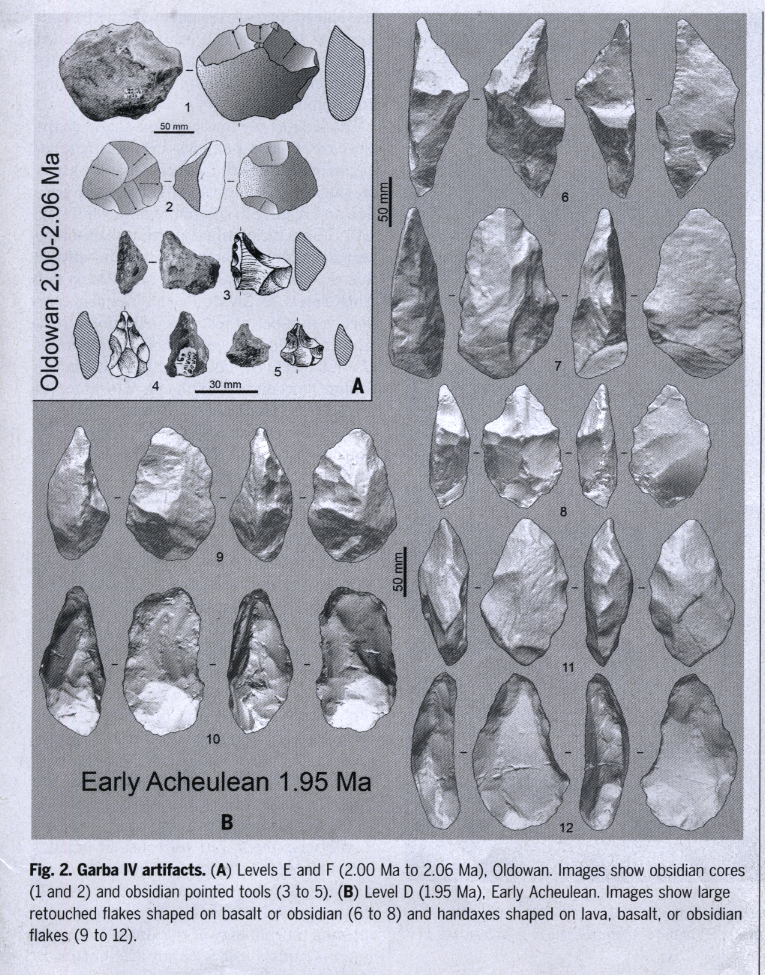
Source Science November 19, 29023
Around 2.6 - 3 million BP or YA
Oldowan tool sets are created and used to process hippopotamus in Kenya possibly by Paranthropus.
2.8 million BP or YA
Fossilized jaw found at Ledi-Geraru, Ethiopia dates as 2.8 million years old and classified in the Homo genus.
3.18 million BP or YA
Lucy roams across Ethiopia, Africa
Discovered in 1974 she is classified as Australopithecus afarenis. Upright a terrestrial hunter and gatherer that probable spent some time in trees. It has been speculated that fractures she suffered might have been from falling.
Afarensis is small and completely non-technological. No one has ever argued that they were predatory. They are bipedal, ground-eating apes.
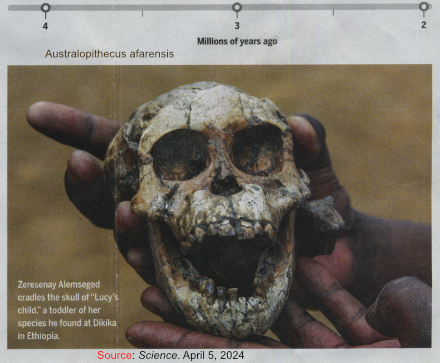
3.3 million BP or YA
Stone tools are at a Lomekwi site near Kenya's Lake Turkana. They are found by Sonia Harmand and her team, and .dated around 33 million YA. Source National Geographic
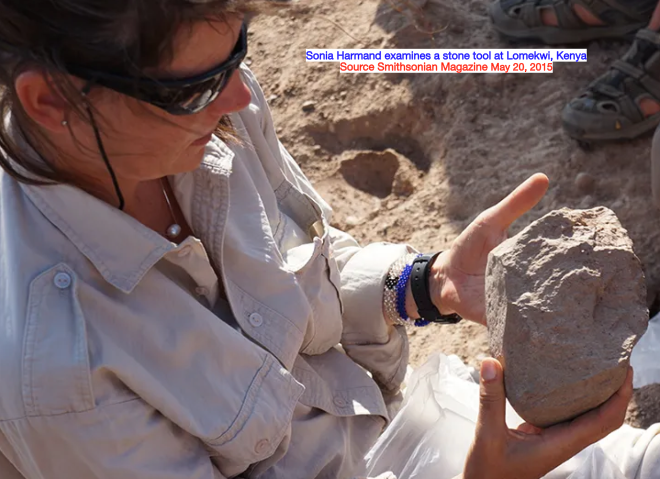
Source Smithsonian Magazine
3.3 - 3.5 million BP or YA
Australopithecus deyiremeda is living in the Afar region in Ethiopia.
Their hominin jawbones are found, dated, and classified along with animal bones dated to the same time, 3.4 million BP or YA The new species is another confirmation that Lucy's species, Australopithecus afarensis, is not the only potential human ancestor species roaming Afar region of Ethiopia during the middle Pliocene. Source & image page originally from the Cleveland Museum of Natural history 2015.
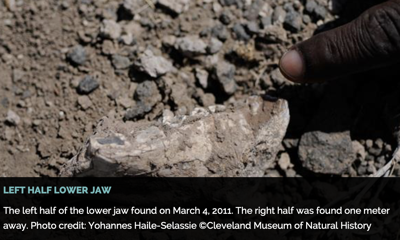
Cut marks are made on animal bones dating to nearly 3.4 million years ago in Ethiopia's Afar region. Suggesting humans (Australopithecus afarensis) are using stone tools. And possibly eating meat far earlier than previously thought. Source
However, additional study of tooth enamel suggest they are vegetarians. Source
3.6 million BP or YA
First evidence of bipedalism
Footprints are left by three Australopithecus afarensis hominids who walk on volcanic ash at Laetoli near Olduvai. They are preserved and Mary Leakey discovers them in 1978.
3.67 million BP or YA
A hominid skeleton named Little Foot a female Australopithecus afarensis or A. prometheus inhabits the South Africa Sterkfontein Cave. It is discovered in 1997 and exposed over the next twenty years. It becomes the most complete skeleton of its kind found at the time and dates to about 4 million BP or YA.
Australopithecus afarensis is believed to have lived around 2.9 million to 4.1 million BP or YA. Source & images
3.9 million BP or YA
Australopithecus affarensis (Lucy) appears 3.8 million BP or YA.
Australopithecus anamensis appears 4 million BP or YA . Source Stunning skull shakes human family tree. Science August 30, 2019
First sheep, cattle, modern whales, bears, mice, rats, apes, monkeys, dogs, and modern birds appear.
5.3 million BP or YA (Cenozoic Era, Tertiary Period, Pliocene Epoch 1.8-5.3 mya )
9 million BP or YA
Tomatoes make potatoes
Tomato plants hybridize with close relatives and create offspring with genes that make tubers. This hybrid's offsrping will diversify to create hundreds of different colors and shapes of wild potatoes that will be capable of being cultivted in many different climates throughout the world. Source - Science. Erik Stokstad, Thank Ketchup, and Interbreeding for your French Fries. Auguest 2025.
23.8 million BP or YA (Cenozoic Era, Tertiary Period, Miocene Epoch 5.3-23.8 mya )
24 million BP or YA - animal agriculture between macrotermitine termites and termitomyces fungi begins
33.7 million BP or YA (Cenozoic Era, Tertiary Period, Oligocene Epoch 23.8-33.7 mya )
Termites farm fungi
The termite Odontotermes obesus has a symbiotic relationship with the fungi Termi-tomyces. They're like partners, the termites feed on the fungi. In return, the termites build a nest that protects the fungi's garden. Making the termites like farmers, always tending to their garden by planting, taking care of it, and harvesting the fruits of their labor. Source Fungus-farming termites can protect their crop by confining weeds with fungistatic soil boluses.
Source Science Panchel et. al. Fungus-farming O. obesus leverages fungicide-releasing microbes to suppress the pathogenic fungi Pseudoxylaria.
54.8 million BP or YA (Cenozoic Era, Tertiary Period, Eocene Epoch 33.7-54.8 mya )
55 million YA Attine ants domesticate fungi and begin animal agriculture
65 million BP or YA (Cenozoic Era, Tertiary Period, Paleocene Epoch 54.8-65 mya )
First deer, cats, pigs, tapirs, and rhinos, elephants, horses, owls, shrews, hedgehogs, and rabbits evolve.
EarthViewer - An interactive application to explore what the Earth looks like at different times. Explore what Earth looks like 250 million BP or YA ? Or 1 billion BP or Y.A ? Or 4.5 billion BP or YA ?
EarthViewer lets you see continents grow and shift as you scroll through billions of years and explore changes in atmospheric composition, temperature, biodiversity, day length, and solar luminosity over deep time.
Beginning
Mesozoic era,
Paleozoic era, & Precambrian
Overview
Holocene Epoch starts about 12,000 YA
Mesozoic era includes three periods
- Cretaceous period - between 65.5 and 145.5 million years BP or YA
- Jurassic period 144-208 mya, &
- Triassic period 208-245 mya
Paleozoic era about 251 - 540 million BP or YA
- Permian Period 245 - 280 mya
- Carboniferous Period 280 - 360 mya
- Devonian Period 360 - 408 mya
- Silurian Period 408 - 438 mya
- Ordovician Period 438 - 505 mya
- Cambrian Period 500 - 540 mya
Precambrian 540 mya - 4.6 billion BP or YA includes about 90% of the time the Earth has existed.
Summary of change
The Earth itself evolves over a very long time period, compared to human life spans. The millions of years eventually provides conditions and materials for habitats suitable for life to evolve complex organisms: most recently Homo sapien.
- A geological period is a basic unit of geological time in which a single type of rock system is formed.
- A geological era is a time period of two or more periods.
More information on eras, periods, and evolution of life see Earth science Australia
Notes on the Anthropocene Epoch
Some scientist believe a more recent Epoch should be add and named the Anthropocene Epoch
- Do we need another? Like the Anthropocene or is adding another a way for an anti human environmental influence.
- Noted geological changes that are used as evidence to add it include …
- Fossil fuel use and carbon emissions, are disrupting the planet's atmospheric and oceanic cycles.
- Microplastics and PFAS forever chemicals now contaminate sediment.
- Radiation from atomic bomb testing.
- Rising global temperatures related to greenhouse gas emissions.
- Is it enough for a new epoch or job should be included in the Holocene?
- Or is it an event or series of events not an epoch?
Mesozoic era 65.5 - 250 million BP or YA
66 million BP or YA (Mesozoic Era, Cretaceous Period 65.5 - 145.5 mya )
First snakes, crocodilians, and many flowering plants (angiosperms).
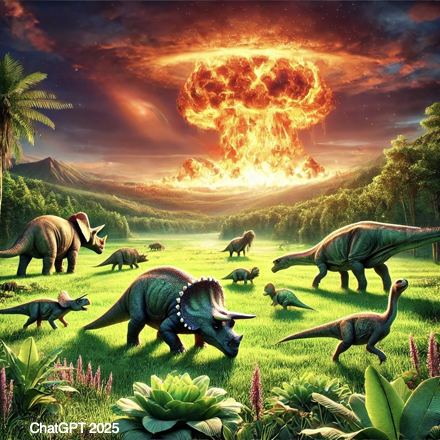
Mass extinction, known as the K-T extinction (Cretaceous - Tertiary extinction) and K-Pg (Cretaceous - Paleogene extinction) ends the Mesozoic Era Cretaceous Period with these mass extinctions. The dinosaurs, ammonites, mollusks are among the 80% of life on Earth that is unable to survive during this time, known as one of the six mass extinctions. Mammals and birds thrive afterward. See PBS and what killed the dinosaur? & The Last Days of the Dinosaurs: An asteroid, extinction, and the beginning of our world. Riley Black 2022
It can be labeled as a critical boundary at 66 million BP or YA .
The boundary of the Mesozoic era results in mass extinctions believed as a result of an asteroid strike, which can be measured by the strong trace of the element iridium it left in rocks and tektites that have been found at sites around the world, both a result of the impact. One recent and site, Tanis, ND part of the Hell Creek Formation, is one site, with some astonishing artifacts.
The asteroid, about 6 miles (10 km) in diameter, crashes in Chicxulub, Mexico creating a crater about 110 miles (180 km) in diameter and 18 miles (29 km) deep. The explosion releases as much energy as 100 trillion tons of TNT, more than a billion times more energy than the bombs that destroyed Hiroshima and Nagasaki.
About the same time period Deccan Traps in India erupts releasing significant amounts of volcanic ash over a time scale that extends before and after the Chicxulub impact. These eruptions likely also contributed to the K-T extinction. Source
85 million BP or YA
Australia breaks away from Antarctica
174 million BP or YA
First flowering plants Nanjinganthus dendrostyla (angiosperm)
200 million (Mesozoic Era, Jurassic Period 144-208 mya)
- Oceans full of fish, squid, ammonites, the great ichthyosaurs, and long-necked plesiosaurs.
- Huge plant-eating dinosaurs roam the Earth and eat huge ferns, palm-like cycads, and a type of seed plant, bennettitaleans.
- Cycads use infared radiation at dusk to attract beetles as pollinators. The beetles antennae have sensors, similar to those in snakes, to find the cycads' thermogenic reproductive structures in the dark.
- Smaller carnivores hunt the herbivores.
- Vertebrates take to the air, like the pterosaurs and the first birds.
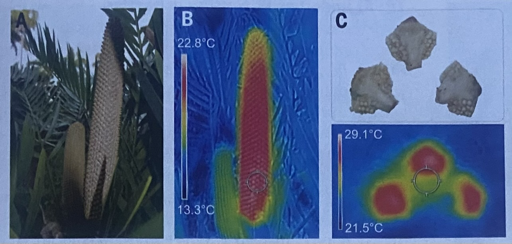
End triassic with volcanic activity in Atlantic Ocean. 80% of species conodont (robbon fish) and reptiles. Ddionosaurs, archosaur, and crocodile relatives thrive.
245 million BP or YA (Mesozoic Era, Triassic Period 208-245 mya )
First mammals, dinosaurs, frogs, turtles, crocodyloformes.
Paleozoic era about 251 - 540 million BP or YA
280 million BP or YA (Paleozoic Era, Permian Period 245-280 mya )
Sail-back reptiles. Amphibians abundant. Synapsids (predicessors of mammals), Podocarps (group of ancient ferns), red pine of New Zealand, Yellowwood of South Africa, corystosperms (seed ferns). Pangaea forms.
Volcanic activity in Siberia creates toxic gases, ash, wildfires, and decreases the ozone layer and the mass extinction of 96 % of all species. Notably, amphibians and synapsids.
Fungus thrives and dinosaurs and mammals evolve.
300 million BP or YA
Both oxygen and ozone levels reach current levels with many different kinds of complex land plants and animals.
360 million BP or YA (Paleozoic Era, Carboniferous Period 280-360 mya)
First reptiles, winged insects, and widespread swamps that will become coal.
- End of Devonian with series of climate changes.
- Possible volcanic activity in Siberia.
- Extinction of armored fish, coral, trilobites.
- Vertebrates under one meter and tetrapods thrive.
408 million BP or YA (Paleozoic Era, Devonian Period 360-408 mya)
First amphibians, sharks, bony fish, ammonoids, and spiders. Many fish.
438 million BP or YA (Paleozoic Era, Silurian Period 408-438 mya )
First insects and vascular plants on land.
443 million BP or YA
End of Ordovician
Climate shifts from cold ice sheets to sudden melting. Sea sponges and brachiopods thrive.
Sponges (porifera) are filter feeders lack organized tissues, however, they willl become the sister to all other animals. They have phylogenomic support for a nervous system, muscles, and a through-gut system that will be inherited by humans, starfish, butterflies, snails, as well as jellyfishes, corals, and sea anemones. Source: Integrative phylogenomics positions sponges at the root of the animal tree. Jacob L. Steenwyk & Nicole King. Science, November 13, 2025.
450 million BP or YA
The ozone level is close to its present value as land plants evolve.
Late Ordovician mass extinction of of trilobites, corals, brachiopods. Astronomers believe a Gamma-ray burst (GRB ) happens that creates smog to blanket the entire Earth and start a global ice age.
505 million BP or YA (Paleozoic Era, Ordovician Period 438-505 mya )
First land plants, corals, Nautiloids. Ends in mass extinction.
540 million BP or YA (Paleozoic Era, Cambrian Period 500 to 540 mya )
Evolution of first shellfish, primitive fish, trilobites, corals, mollusks.
Precambrian 540 million BP or YA
The Precambrium (a geologic time) starts with the Earth's formation, 4.6 billion BP or YA and lasts to the beginning of the Paleozoic Era Cambrian Period, 540 mya.
The Precambrian is not considered a geologic eon, era, period, or epoch, it is simply referred to as Precambrian or Precambrian Time. It spans most of the Earth's history (90%).
635 million - 651 million BP or YA
Snowball Earth
Ice blankets the Earth from pole to pole and temperatures dropped as low as -50C and life survives.
Source Molecular fossils show hw life survived Snowball Earth. Elise Cutts. Science. July 17, 2025.
815 million BP or YA
Oxygen concentration increases to 10 - 11%.
The current level is about 21%.
Precambrian 900 million - 1 billion BP or YA
First chitin
A Canadian fungi (Ourasphaira giraldae) evolves. It is .1 millimeters long with branching filaments and bulbous structure with cell walls made of chitin.
Chitin is necesary for insect and crustacean exoskeletons and fish scales.
2.4 billion BP or YA
Bacteria and archaea evolve to use sunlight for energy and produce oxygen as a by product, which is important for the development of life on land, because it protects Earth's surface from too much ultraviolet radiation which is fatal to life.
However, as oxygen levels rise, some bacteria and archaea are burned alive.
3.5 billion BP or YA
The Great Oxidation Event begins when Cyanobacteria, an oxygen-producing organism evolves.
Since there is no protective atmosphere, Cyanobacteria, evolves in the oceans, where they are protected from deadly sun rays.
They use carbon dioxide and water for photosynthesis and release oxygen, which has been largely absent, as a waste product.
Over time, the oxygen they produce accumulates in the atmosphere, where some is converted to ozone, and a protective atmosphere is created. The atmosphere, blocks ultraviolet radiation, which is fatal to life, this enables bacteria and archaea to survive towards the water's surface and on land.
4.0 billion BP or YA
First life on Earth
Microfossils of tiny creatures are locked in different samples of rock in northern Canada. Sample date from 3.8 - 4.3 billion years & 3.95 billion years BP or YA.
LUCA (last universal common ancestor) of all living organisms is a microbe dates from 4.2 billion YA. It could have 19 CRISPR-Cas9 genes. It has a genome that encodes 2,600 proteins and uses hydrogen and carbon dioxide for energy.
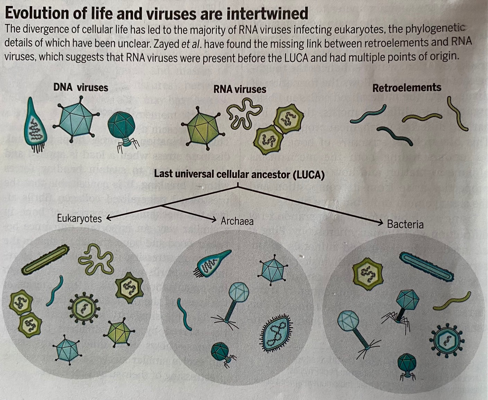
4.3 billion BP or YA
Liquid water & land form on Earth
Earth cools enough to form liquid water and solid land which forms tectonic plates that sink into the mantle.
4.6 billion BP or YA
Earth's primitive atmosphere of mostly nitrogen and oceans evolve complex molecules (maybe RNA) that the will evolve into the first living cells.
4.5 billion BP or YA
Earth's surface is an ocean of magme
4.51 billion BP or YA
Moon forms
Shortly after the Earth forms, the Moon forms when a protoplanet, Theia, smashs into proto-Earth launching vaporized debris into space. From which the Moon forms.
4.53 billion BP or YA
Earth forms
4.5673 billion BP or YA
Sun forms
4.6 billion BP or YA
Birth of our Solar System
13.1 billion BP or YA
First black hole forms
13.8 billion BP or YA plus 3 minutes
HeH+
The Big Bang creates HeH+ (hydrogen, helium, and traces of deuterium and lithium ions) in three minutes.
13.8 billion BP or YA
Big bang ... Creates the Universe?
Logically, creation has three options:
- A cataclysmic creation - most likely
- A non creation - meaning the Universe is always in existence
- A Universe that is an illusion - meaning it doesn't exist as a physical entity.
Ideas related to the universe, time, and space - and some people who thought about ....
Multi Universe related ideas:
- Eternal return - Friedrich Nietzsche
- Many worlds - Hugh Everett
- Infinite twin Earths - Louis-Auguste Blanqui
Time & space:
- Time related ideas:
- Fourth dimension - Albert Einstein
- Fifth dimension - tesseract - Wrinkle in Time
- Infinity - Hilbert's hotel
- Time travel, parallel timelines - Kip Thorne Cyclical cosmologies - Roger Penrose
Space:
- Curved space
- Expanding universe
- Big Bang
Matter:
- Quantum
- Particle physics
- String theory
- Development of (intelligent) life
See Physics notes
What are the top inventions of all time?
101 Inventions that Changed the World source Vimeo (1:28:17) by Meghan A.T .B. Reese
- wheel and axle
- printing press
- light bulb with carbon filament
- steam engine
- transistor
- lever
- computer
- fire
- bronze
- internal combustion engine
- paper
- internet
- automobile
- penicillin Fleming
- compass
- vaccine
- telegraph
- concrete
- sail
- radio
- anesthesia
- ether
- telescope
- water wheel
- electric generator
- mould board plow
- refrigeration
- microprocessor
- telephone
- mechanical clock
- satellite
- arch
- cotton gin
- boat
- dynamite - Alfred Nobel intended its use only for mining and railway construction.
- birth control
- airplane
- eye glasses
- electric motor
- cellphone
- keel
- candle
- Archimedes screw
- windmill
- flush toilet
- nail
- jet engine
- still camera
- rocket
- plastic
- x-ray
- differential gear
- laser
- nuclear power
- mechanical reaper
- software
- aqueduct
- oil lamp
- bellows
- digital camera
- stirrup
- MRI
- hammer
- I beam
- magnetic
- recording tape
- steam turbine
- saw
- phonograph - Thomas Edison invented so people could record their thoughts for posterity and to help the blind. Not happy when people only want to record music.
- arc welder
- bridge suspension
- radar
- gyroscope
- copy machine
- valve
- canal lock
- microwave oven
- paddle
- bike
- light house
- pacemaker
- skyscraper
- robots
- pneumatic tire
- solar panel
- barbed wire
- builders level
- nylon
- elevator break
- chisel
- credit card
- movie camera
- screw propeller
- lock and key
- kevlar
- Ben Franklin wood stove
- CD
- prosthetic limbs
- condom
- wooden peg
- SCUBA
Where is pottery, television, toothbrush, writing, mathematics, smart phone, ... other?
Human Apocalypses - Fourteen significant apocalypses by Lizzie Wade
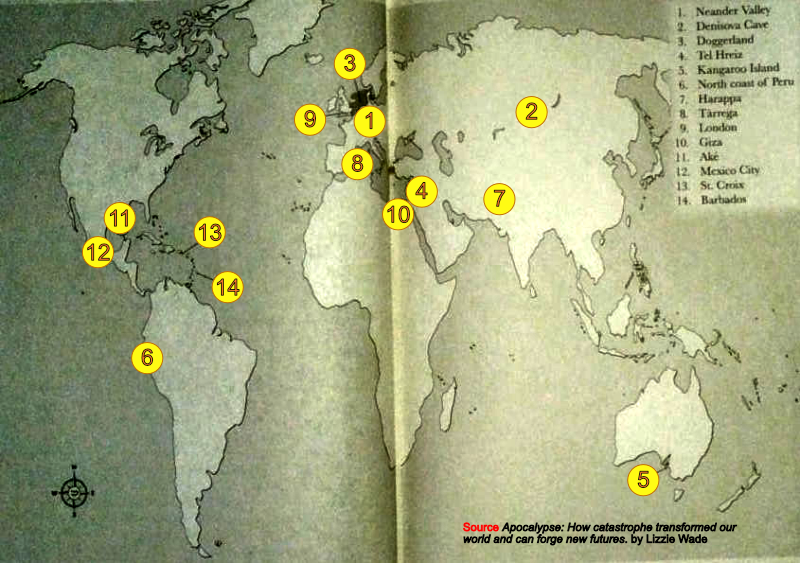
Summary
Lizzie Wade presents a unique historical perspective on apocalypses, challenging conventional wisdom and long-held stories about our past. She reveals that cataclysmic events are not endings but transformations, leaving us to wonder about their causes, and the extent of the survivors' transformations and even possible progress. She reframes human history as a series of crises and cataclysms we survived, challenging narratives from the end of the Old Kingdom of Egypt to the collapse of the Classic Maya and the Black Death. She shows how people lived through and beyond these events, even considering a new world.
The more we learn about past apocalypses, the more hope we have of surviving the next one. It won't be pleasant or fair, but the world will be different, and our cultures and communities will be too.
Source
